
Home » Business » 50 Easy Brainstorming Activities, Games, and Exercises

50 Easy Brainstorming Activities, Games, and Exercises
A brainstorming exercise can be a great way to encourage team members to share their best ideas to create new and innovative solutions to a given problem. The key to effective brainstorming is to use a warm-up exercise to get creative juices flowing and encourage different perspectives. And remember, don’t judge anyone. During the brainstorming process, there is no such thing as a bad idea.
Here are 50 creative brainstorming activities for your next brainstorming session to break out of routine thinking and generate fresh ideas.
Brainstorming Warm-ups
#1. Draw Something It is a good idea to start an idea generation process in a fun way to encourage creative thinking. Drawing is a great starting point, and the idea of the game is simply to be creative.
How to Do It:
- Set a timer for one minute.
- Ask everyone in the ideation session to draw something simple and abstract (toast is a common example).
- To make the most of your time, make the drawing task related to the main problem to get everyone’s mind focused on the topic.
#2. Multi-Purpose Items This is a fun activity to encourage everyone to have an open mind and come up with creative ideas.
- Break into small groups.
- Provide groups an item like a clothes peg or paperclip.
- Set a time limit of 1-3 minutes.
- Come up with as many different uses for the item as possible.
Common Ideas
#3. Popcorn This brainstorming technique is a free flow method for coming up with lots of ideas very quickly. This is a good game to create initial ideas for later activities.
- Propose a specific problem or topic.
- Provide thinking time (usually one minute).
- Designate a note-taker to write down ideas.
- Have people call out their ideas and encourage others to respond and add to these ideas.
- Once you’ve run out of ideas, go back through the list and choose the best ones to explore.
#4. Brain Writing This is one of the most effective brainstorming techniques for generating many possible solutions and ensures that everyone has a say. Usually, due to time constraints, it will be less than ideal if you have a room full of people. Keep the group small so that everyone can participate.
- Define a problem or topic.
- Take a sheet of paper and have one person write down their idea.
- Pass the piece of paper to the next person, and they add their idea or modify the original.
- Repeat this until all group members have contributed.
- For more ideas, have multiple people write the problem in their own words so that several unique lists are created.
#5. Rapid Ideation Sometimes called “rapid writing,” “rapid ideation” is a structured version of the popcorn method.
- Set out a central problem.
- Set a time limit of 3-5 minutes.
- Have each person/team write down as many ideas as they can think of in that time.
- Once time has passed, compare notes and look for similar ideas or common themes.
#6. Mind Mapping A “mind map” is a visually connected form of free association. When mind mapping, ideas are free to grow, and the connections between ideas are visually traced.
- You will need a whiteboard and markers (or an online whiteboard).
- Start by writing down the core question.
- Set a timer (optional).
- Take turns calling out ideas/questions that are associated with the core issue.
- Draw a line between the core idea and each related point.
- Continue calling out associated ideas or questions for the core or sub-ideas.
- Continue until time runs out or enough ideas are generated.
#7. The 5 Whys The “five whys” is one of the most powerful brainstorming techniques for getting to the heart of a problem.
- Best applied in small groups.
- Take a piece of paper or whiteboard and write down your problem in the top corner.
- Regarding the problem, ask “Why?” and write down the answer.
- Then regarding the answer, ask “Why?” again.
- Repeat for five “whys.”
- Then discuss what you have learned about the cause of the issue.
Ideas to Include Quiet People
#8. Walking Brainstorm A “walking brainstorm” is a useful tool if you have enough space, such as a conference room. It is also good for addressing complex problems and ensures that everyone has an opportunity to share.
- Set up stations around a room.
- At each station, have a separate aspect of a larger problem.
- Have sticky notes available at each station.
- Individuals then quietly walk between stations, write their idea(s) on sticky notes and add them to that station.
- Allow adequate time for everyone to attend each station.
#9. Idea Napkin An “idea napkin” is a balance between producing a lot of ideas quickly and getting some depth on the ideas.
- Provide everyone with an index card.
- Set a time limit of 5 minutes.
- During this time, everyone writes down their idea and an elevator pitch.
- Have each person pitch their idea to the group.
- For large groups, break out into smaller groups to complete the task.
#10. Brainstorming with a Partner Breaking into pairs is a great approach when working with a larger group. Each pair can be assigned different aspects of the problem to solve or all work on the same problem.
- Have the group separate into pairs.
- Provide the problem to be addressed.
- Set a timer for five minutes.
- Ensure each group records all ideas, no matter how crazy they may seem.
- Compare ideas as a large group and look for common themes.
#11. Collaborative Brainwriting This is a great way to involve everyone in the ideation process while providing time for natural creativity to flow.
- In a communal area, set up a whiteboard or large flipchart and markers.
- At the top of the writing medium, write a clear problem statement.
- Members of the team/organization can freely approach the board throughout the week and add ideas or comment on others’ ideas.
- At the next meeting, discuss the ideas proposed.
Ideas for Online Groups
#12. Chat Waterfall When working with remote groups, ideas can be lost quickly in the flow of a written chat conversation, and the “chat waterfall” solves this.
- Ideal for groups of 5-15 people.
- Set up a group video chat.
- Set the theme of the brainstorming session.
- Give everyone two minutes to think quietly.
- Have everyone type their best idea(s) into the written chat, but do not send the ideas to each other just yet.
- Once everyone has written their ideas, have everyone press Send at the same time.
- Discuss the ideas.
#13. Brain Netting “Brain netting” is a great way for remote groups to brainstorm together without having to meet in real-time.
- Set up a shared online document such as a Google doc.
- Set the theme of the brainstorming session at the top.
- Allow everyone to access the file for one week and add their ideas or comments on other people’s ideas.
- At the end date, review the document for ideas.
#14. Virtual Change of Scene The “virtual change of scene” uses novelty to encourage originality in thoughts and ideas.
- The presenter should choose a background that creatively relates to the theme of the brainstorming session.
- Ideally, set a theme and have everyone set custom backgrounds to match (e.g., innovation).
- Commence your brainstorming exercise in this novel setting.
- Experiment with using a change of scene with a chat waterfall.
#15. Lightning Decision Jam This is one of the most powerful techniques for remote workgroups and can come up with some great ideas.
- In a small group, begin with the main discussion point.
- First three-minute round: Throw out as many positive points about the main issue as possible.
- Second three-minute round: Repeat the above for negative points.
- Reframe each point as questions.
- Prioritize the most urgent concerns.
- In a five-minute round, develop solutions using another brainstorming method.
- Create a matrix of solutions and weigh solutions by the ease of implementation and highest impact.
#16. Imagination Storming This method is great because it can even be done via a phone call instead of video chat. It appeals to visual thinkers and is great for product development.
- Have participants close their eyes for one minute and imagine the core topic (e.g., smartphones). They should visualize what it looks like, what it does, and how it’s used.
- Then, discuss common trends and themes of what was imagined.
- Everyone closes their eyes again for one minute. This time imagine new uses for the same thing or new features/accessories that would make it better.
#17. Random Stimulus – Version 1 “Random stimulus” is a great activity for spontaneous idea generation with online groups.
- Give each participant one minute to get an item from around their house.
- Give everyone two minutes to write down ideas related to their item.
- Now, introduce the main brainstorming topic.
- Each person has one minute to force-fit what they have written to relate to a core idea.
#18. Eight in Eight This is a version of the “crazy eights” method that can be applied online or in small groups.
- Recommend a group of eight.
- Make sure each participant has a drawing application or paper and pen/marker ready.
- Provide an issue or idea at the center of a 3 x 3 grid.
- Start a one-minute timer, and everyone must produce a drawing of the problem.
- Arrange the drawings around the central issue.
- Put one of the problem representations at the center of another 3 x 3 grid.
- Start another one-minute timer, and everyone must draw a solution to the problem.
- Complete the second exercise for all eight problems.
Visual Ideas
#19. Drawing the Problem This is a type of reverse brainstorming where participants draw pictures to represent the problem as they see it.
- Provide all participants with a sheet of paper and a marker.
- Begin by stating a general issue, e.g., “We have bad customer reviews.”
- Allow all participants five minutes to draw their representation of the problem.
- Discuss solutions openly.
#20. Draw It Out This is similar to #19, but is solution-focused. Drawing solutions can require more time than drawing the problem.
- Provide all participants with a large sheet of paper and a pen/marker.
- Begin by clearly providing a problem statement.
- Allow all participants five minutes to draw their solutions. Common approaches are:
- Draw the envisioned solution (or more than one if time permits).Draw a flowchart illustrating the steps of the problem-solving process.
#21. Drawing Off-Hand This idea is a fun and somewhat silly drawing exercise that can produce some very creative ideas.
- Set out the core issue to be addressed.
- Provide everyone with a piece of paper and pen/marker.
- Using their non-dominant hand to draw, each person draws a solution to the issue.
#22. Sticky Note Map This is a version of free-form mind mapping and is great for including quiet members of a group.
- Write the core issue/idea in the center of a whiteboard.
- Provide sticky notes to everyone in the group.
- Group members can write their idea on a sticky note and then add it to the board.
- Members should draw a line between their idea and the idea it relates to.
#23. Crazy Eights The fast pace helps to remove self-imposed limitations on creativity and discourages overthinking.
- Draw a grid of nine squares on a whiteboard.
- In the center square, write the problem statement.
- Set a timer for eight minutes.
- Take turns drawing a solution in each box around the central problem.
Creative Ideas
#24. Role-Playing Role-playing can be used to better understand a customer or user’s experience.
- You need enough participants for each role represented.
- Act out a scenario, such as a product use case.
- Treat the problem realistically, but be as creative or ridiculous as you want in other ways.
- Anyone not roleplaying can interject with ideas and comments.
- Discuss what everyone has learned about the issue.
#25. Free Association “Free association” is a simple “what comes to mind” association exercise. For this activity, participants write down everything, no matter how unrelated it may seem.
- You will need a whiteboard and pen/markers (or online whiteboard).
- Designate a writer.
- Start by writing down the core idea.
- Take turns calling out ideas/thoughts/words that come to anyone’s mind.
- Look for common themes.
#26. The 5 Senses The “five senses” technique is an effective way to brainstorm for original ideas as it involves using all of your senses.
- Close your eyes and imagine the problem you are facing (or a problem using a product, etc.) and try to experience it with your five senses: sight, smell, sound, taste, touch.
- For each sense, imagine possible solutions or ideas related to the problem at hand.
- Write down any ideas that come to you during this process.
#27. Storytelling This is good for product development or marketing teams. It involves telling a narrative about your problem and working through the scenario.
- Outline the problem to be solved.
- Best for groups of 7-15.
- Designate a storyteller in each group.
- The storyteller begins by describing a fictional narrative (e.g., about using a product that receives a lot of bad feedback).
- Other group members may ask questions, point out objections or suggest additional ideas.
- Write down a summary of your story and your group progress on the problem.
- Discuss what you have learned.
#28. Reverse Assumptions This method challenges what you think you know about an idea. It can be applied online, in groups, or alone.
- Write down the problem on a piece of paper or a whiteboard/online whiteboard (e.g., “Not enough sales.”).
- Write down what you think the problem is (e.g., “Our products are too expensive.”).
- Challenge the idea with different assumptions (e.g., “Competitors’ products are better.”).
- Continue until no new assumptions come to mind.
#29. Metaphoric Association This can be more challenging to learn than other ideas but helps generate lots of creativity.
- Think of a location, place, or object (e.g., police station).
- Try to think of what it can be a metaphor for (e.g., challenging risks/confrontation).
- Now, force this metaphor to relate to your core problem.
#30. Random Stimulus – Version 2 “Random stimulus” is a method that is designed to generate abstract creativity. Version 1 of the random stimulus exercise is included above in the Ideas for Online Groups section and is meant to be done from home.
- Before your brainstorming session, select random items equal to the number of participants.
- Pass each person an item and give everyone two minutes to write down ideas related to their item.
- Now, introduce the main brainstorming topic to the group.
- Each person has one minute to force what they have written to relate to the core idea.
#31. Writing Off-Hand This method helps with thinking with the non-dominant half of your brain and is a fun way to generate new ideas.
- Identify the core issue to address.
- Provide everyone with a piece of paper and pen.
- Set a timer of 3-5 minutes.
- Everyone writes as many ideas as they can think of with their non-dominant hand.
#32. Exaggeration This is a method designed to use absurdity to encourage creativity. By making things absurd, it’s easier to be creative.
- This works best with multiple small groups.
- Give each group an exaggeration (e.g., make it 10x as big, solve this with a zero $ budget, etc.).
- Give the groups a problem statement.
- Provide 5-10 minutes for each group to discuss the problem under their exaggerated conditions.
- Discuss the ideas generated and how they could apply in reality.
Ideas for Deep Thinking
#33. Lotus Bloom This is a technique that goes deep in search of innovative ideas, building on each suggestion to find a better idea.
- Break into groups of 3-10.
- Draw a grid of nine squares in the center of a large piece of paper or whiteboard.
- Write the central issue in the middle square.
- Try to fill out the other eight squares with related ideas.
- Repeat 2-5 times for the most promising ideas from each attempt.
#34. Six Questions This method looks at a problem from several different angles and is a popular approach to address big problems.
- Draw a 6-point star in the center of a whiteboard.
- In the center of the star, write the core topic.
- Around the points, write Who, What, Why, When, Where and How.
- Begin answering each of the questions
- If you have enough participants, small groups can be assigned to work on each question.
#35. Five Times For this method, try to rephrase your answer to the main idea/problem five times in new ways.
- This can be done as a group or individually.
- This can be used to analyze ideas generated from another brainstorming game.
- Take the central idea and write down the best solution you can think of.
- Rewrite the same solution another four times, as uniquely as possible.
- Look for how each solution might be implemented differently, even though each is based on the same statement.
#36. Stakeholder Round Robin This is a good way to come up with a large number of ideas that each fit different categories or approaches.
- Think of the stakeholders who matter to your core issue (2 is minimum, but ideally 3+).
- Before the brainstorming session, prepare a flip chart with one stakeholder listed at the top of each page.
- Set a five-minute timer to discuss the brainstorming topic from the perspective of the first stakeholder.
- Flip the chart and repeat for the next stakeholder.
- Continue until all stakeholders are discussed.
- Compare common themes between stakeholders.
Uncommon Ideas
#37. Outrageous Ideas This is one of the most creative exercises for brainstorming and is particularly good when you become stuck with other methods.
- In a group, or on your own, take a piece of paper or a whiteboard.
- Write down every idea, no matter how outrageous.
- Look at the ideas to see if any can become reality.
#38. Talking Timebomb This is a great brainstorming game and is particularly good for use with students or when you want to make a fun activity for a group.
- You will need a tool such as an online random timer (like here: https://creativetechguy.com/utilities/randomtimer) and a physical object to pass, such as a small ball or use a physical random timer (like in the Gibson Easiplay Pass The Bomb Game).
- Give the central topic or idea to be addressed.
- Set the timer to between 15-60 seconds.
- The first student starts with the timer or object.
- When the time starts, they must call out an idea or solution related to the central topic. They then pass the ball to the second student.
- The second student then also adds an idea or solution that hasn’t already been said. They then pass the ball to the next student.
- Repeat until the timer expires. The goal is not to be the person it ends on.
- For extra fun, have a low-stakes reward such as leaving 15 minutes early or a free coffee.
#39. Shiritori This is a chained word association game for groups of three or more. It is a fun way to generate a lot of ideas.
- Set a timer.
- One person starts by saying a word related to the main topic.
- The next person must say a word that is related to the main topic and starts with the last letter of the first word.
- Continue in this manner.
#40. Pushy Salesperson This game is intended to be fun while often providing surprising insights about existing products or services or when analyzing ideas from another brainstorming game.
- You need at least two people.
- Pick the product/service/solution to be discussed.
- One person has two minutes to sell the solution to the rest of the group. Like a pushy salesperson, they must continuously talk, not stopping.
- Repeat as few or as many times as you like.
#41. Like/Dislike This can be used to compare ideas generated in a previous activity or to create and compare new ideas.
- Have a group of three or more people.
- On a whiteboard, draw five columns. From left to right, label them -2, -1, neutral, +1, +2.
- Each person writes one idea/solution to the central topic on a sticky note and puts it in the neutral column.
- Have a list of 4-10 great ideas from another activity and arrange these in the neutral column.
- Each person can move up to three notes, but they can only move each note one space left or right.
- Once everyone has had a turn moving notes (voting), discuss which ideas have the greatest preference and why.
#42. The Next Big Thing This is a fun game. It is intended to be light-hearted and start conversations, but it can also be used for product idea generation.
- Provide the main issue/market to be addressed.
- Allow a certain amount of time, such as 20 minutes, for the group to quietly think of the most ambitious ideas they can. The goal is to be the next Apple or Coca Cola.
- After time is up, each person pitches their idea.
#43. Bad Ideas The “bad ideas” game is a great approach when it seems all other attempts have stalled.
- Set the core topic.
- Come up with the worst ideas possible to solve it.
- Some ideas may spur thoughts that lead to good ideas.
- If not, start working through each idea and discussing what the opposite of it looks like.
#44. 30 Circles This is designed to force participants to think outside the box by requiring a set number of solutions.
- Take a large sheet of paper or a whiteboard and draw 30 circles in a square.
- Write the problem to be addressed across the top of the square.
- In each circle, write one idea/solution to address the problem.
- Continue until all 30 are filled.
- Look for common ideas.
#45. Radaptation “Radaptation,” or “reverse adaptation” is a method that requires a lot of abstract thought. Adaptation is changing a function/feature to perform a new role. In radaptation, you take a function unchanged and apply it to an existing issue/problem.
- Think of a product or feature that is currently popular (e.g., Nike shoes).
- Now, consider what this product does in its current form, other than its core function (e.g., they look very nice).
- How can this product be used/sold for other issues (e.g., now sold as a status symbol, instead of just jogging shoes).
#46. In the Footsteps of Greatness This is a brainstorming technique intended to put participants into someone else’s shoes, usually a celebrity or someone notable.
- Before the brainstorming session, decide what the brainstorming topic will be.
- Decide what notable historical or celebrity figure’s perspective would be interesting to discuss your topic from.
- Provide both the topic and the name of a famous person to your group.
- Discuss how that person would approach your problem.
#47. What-if This approach is great for having a lot of fun while getting different perspectives on an issue, particularly if you have become stuck.
- Set a problem statement.
- Ask “What if?” and then make up your own scenario (e.g., what if this happened when we didn’t have computers?).
- Explore how different questions would be answered.
- Continue until you have enough ideas.
#48. Random Words This is a forced correlation and association game.
- Prepare a list of common words.
- Provide each participant with one word at random.
- Each person has one minute to discuss how their word relates to the main brainstorming topic.
#49. I Wish “I wish” is a similar concept to exaggeration. It removes real-world limitations from the problem-solving exercise.
- Discuss a problem statement as a group, such as “make the world’s oceans better.”
- In small groups, discuss “I wish” solutions such as “I wish there were robotic ships that picked up ocean litter.”
- Discuss the solutions.
- Are any of the solutions more achievable than they initially sounded?
#50. Yes, And “Yes, and” is a technique that is about building on what another person shares, rather than objecting to or tearing ideas down.
- Best applied after another technique has produced some good ideas.
- If no idea already exists, someone starts and suggests their best idea to address a chosen problem.
- The next person must say “yes, and” and add to the conversation without detracting from the previous statement.
- Continue until no one has anything more to add (or enough ideas are provided).
There are a lot of different ways to run a brainstorming activity. To get lots of new ideas, start with a brainstorming method that is fun and build on this with a more in-depth method. Remember, it is a creative exercise about finding original ideas. To maximize your chance of doing this, be sure to include each member of your team and try to leave choosing your favorite ideas until the end of the game or activity.
Related Posts:
- 25 Best Time Management Activities, Games & Exercises
- 50 Fun and Unique Team Outing Ideas
- 21 Best Active Listening Exercises with Examples
- 25 Time Management Tips for Students (Skills and Strategies)
43 brainstorming techniques and games for creating new ideas

Finding new and innovative ideas is a vital part of the growth and success of any team or organization . While brainstorming techniques are rightly perceived as creative and exciting , it’s important to find a framework and idea-generation process that empowers your group to generate meaningful results.
Innovation is important for many businesses, but what brainstorming activities might you use to help make true innovation a reality? Find out in this collection of effective brainstorming techniques!
Design your next session with SessionLab
Join the 150,000+ facilitators using SessionLab.
Recommended Articles
A step-by-step guide to planning a workshop, how to create an unforgettable training session in 8 simple steps, 47 useful online tools for workshop planning and meeting facilitation.
In this post, we’ll explore a host of effective brainstorming techniques in categories such as creative exercises and visual idea generation games, all of which can be used to help your group brainstorm be more effective and gratifying for all involved.
We’ll also explore talk about the benefits of group ideation and share some examples of brainstorming sessions that utilize these methods. Let’s get started!
What are brainstorming techniques?
Brainstorming is a process of enabling people to think freely and creatively when trying to come up with ideas, solutions, or sharing knowledge.
Brainstorming techniques are proven activities and frameworks for coming up with lots of ideas quickly. They’ll often include steps to shift perspective, facilitate team collaboration and refine initial ideas into something even better.
Some examples of brainstorming activities include classic mind mapping and brain writing where you quickly try to generate as many ideas as possible.
Teams often use these techniques to generate creative ideas to tough problems and to explore possible solutions . They can also be used as part of more in-depth brainstorming workshops where team members then refine and choose ideas to put into action.
Some of the core concepts of brainstorming include: reserving judgment, go for quality over quantity, listen to all ideas, and think outside of the box in the pursuit of radical new ideas and creative solutions. Bring these concepts and a proven technique to your session and you’re already on the route to success!
If you’re finding your team with a problem they don’t know how to solve, a technique that encourages creative thinking might be just the ticket! Use these activities as part of a complete workshop process to refine those ideas into something actionable.
In SessionLab, it’s quick an easy to create an effective agenda for a brainstorming workshop in minutes. Drag and drop blocks in the session planner to create your structure. Add timing for each item to ensure you stay on time. Color-code your blocks to get an instant sense of your learning flow.

Core group brainstorming techniques
Brainstorming has been around as long as individuals and teams have tried to find creative and innovative solutions, or come up with new ideas or products. Whether a group is ideating on how to solve an organizational problem or generate ideas for new features or initiatives, getting people together to quickly ideate and come up with something new is time well spent.
In this section, we’ll first explore some of the core techniques that have been used time and again to create meaningful results and great ideas.
Popcorn Brainstorming
One of the classic brainstorming techniques, chances are you’ve done a popcorn brainstorm already. It’s been used by everyone from school teachers to CEOs to generate ideas and create energy around new initiatives – much like the popping of corn in a microwave!
Start by posing a question or problem statement and invite participants to take a minutes silence to think on it. Once the minute is up, start a timer and invite everyone to contribute ideas out-loud and build on each other’s ideas too. Have a single person take notes and encourage quality over quantity: no evaluation, no criticism or discussion yet – just rapid ideation!
Brainstorming – Popcorn and Round Robin #idea generation #brainstorming Simple, classic brainstorming with two variants. Popcorn – where participants speak out-loud and Round Robin – where participants work in silence and pass their ideas to the next person in turn.
Round-Robin Brainstorming
A tried and tested idea generation technique, Round-Robin Brainstorming provides a little more structure and ensures everyone in a group can contribute to a brainstorm by ensuring the discussion isn’t dominated by the loudest voices.
In this group method, seat everyone in a circle and hand them an index card. In silence, everyone writes an idea on their index card before passing it to the person to their left. Each participant then writes an idea based on their neighbour’s card and passes that along.
The result is a more relaxed session that encourages a combination of idea development and co-creation while ensuring everyone is heard. Perfect for teams with big personalities!

SWOT analysis
A SWOT analysis (strengths, weaknesses, opportunities and threats) is a tried and tested technique that teams often using when planning new initiatives or solving problems. It also happens to be a great tool for generating new ideas while also taking into account potential problems and opportunities.
The act of brainstorming around your weaknesses or threats can result in innovative solutions and ideas you might not have otherwise come up with. Try using each point of the process as a jumping off point for ideation or explore a topic from each of the different angles for best results.
SWOT Analysis #project planning #strategic planning #environmental analysis #planning #issue analysis #online #remote-friendly A SWOT Analysis is used in project planning, strategic planning and other processes where agreement is needed about the current situation of a project, team, department or organization. It stands for Strengths, Weaknesses, Opportunities and Threats.
Brainwriting
No single person is as smart or as creative as a group. With the brain writing technique, tap into the ideas and approaches of multiple collaborators and co-create effectively.
Start by writing down the topic or area for which you’ll be generating ideas. Have all team members silently write down an idea related to the topic on a card and then, pass that idea to the person to their right. The receiving player reads the card and then adds an idea inspired by the original OR enhances the original idea before passing the card along.
By asking participants to grow and improve on one another’s ideas, Brain writing helps a group ideate effectively and come up with better ideas. You can even bring this to an online brainstorming session by using an online whiteboard and have participants pass post-its to the working spaces of their partners.
Brainwriting #gamestorming #idea generation Some of the best ideas are compilations from multiple contributors. Brainwriting is a simple way to generate ideas, share them, and subsequently build on them within a group. Access to multiple hands, eyes, and minds can yield the most interesting results.
Question storming
Sometimes, shifting perspective and starting from a different angle can generate the best ideas. Q-Storming, or question storming invites participants to brainstorm questions, rather than solutions.
After rounds of gathering qualifying data and assumptions, ask your group to think of all those questions that they still have which might help the team think the matter through. This approach can be really useful at finding ideas your team might not have considered and ensuring that what you come up with is truly going to solve the problem at hand.
Walking Brainstorm
Brainstorming methods come in many forms – you might have a quick-fire session that encourages excitement and verbal exchanges. Alternatively, you might find your group will create better ideas by working together in a more relaxed, introvert-friendly manner.
Walking Brainstorm is designed to help large groups work on idea generation dynamically but without creating scenarios where only the loudest participants are heard.
Create a space where different topics or questions are spread on posters/post-its around a room or virtual space. Silently and individually, each participant is encouraged to walk around and visit each question/topic in turn and add ideas to each. By moving around and working individually, this method helps create a more reflective, dynamic ideation session and can also help ensure group-think doesn’t set in!
Walking Brainstorm #brainstorming #idea generation #remote-friendly This introvert-friendly brainstorming technique helps groups of any size to generate and build on each other’s ideas in a silent but dynamic setting. As the participants keep moving, the exercise is ideal to kick-off a full day workshop or re-energize the group after lunch.
For those who prefer a more organized approach to idea generation, mind mapping is a great activity for creating ideas quickly and effectively.
Begin by writing the key topic in the center of a piece of paper or in an online whiteboard. Invite participants to brainstorm related topics and ideas by adding branches to the central idea and create new nodes or elements. As a facilitator, you’ll want to group ideas by color and also amend the thickness of the branches to show the strength of various ideas and concepts.
When you’re done mind mapping, the result will be a diagram that visually represents your ideas and makes it clear how the various parts interrelate – a great resource for idea development or for future sessions!
Mind map #idea generation #concepts #create #issue analysis #design A mind map is a diagram used to represent a number of ideas or things. Mind maps are methods for analyzing information and relationships.
Brain Netting
The concept of brain netting is to not only take your brainstorming online, but to use online tools and virtual spaces to make the session a truly engaging experience.
The key is to use an online tool that the group is familiar with, can co-create in easily and which works both synchronously or asynchronously. Using an online whiteboard or shared document for brain netting means participants can contribute in both a live online workshop as well as in their own time. This is a unique benefit of online brainstorming, and it’s one we’d recommend taking advantage of with your team!
We’d especially recommend using an online tool that supports easy commenting, images, videos and links – encourage your group to use whatever assets best communicate their ideas!

Six Thinking Hats
Exploring a problem or idea from multiple perspectives is a great way to generate new ideas and inform your brainstorming process. In this brainstorming activity, start by explaining the six different hats and that at various points, each person will wear the different hats to explore your chosen topic. For example, the green hat is for creative thinking while the white hat is all about information and facts.
Invite the group to start with the blue hat, which is to control the process and then move between hats to explore, define, ideate, identify risk and gather information around a topic in a sequence. By asking the group to all wear the same hat at the same time, you can ensure your brainstorm moves forward while also ensure all perspectives are explored.
The Six Thinking Hats #creative thinking #meeting facilitation #problem solving #issue resolution #idea generation #conflict resolution The Six Thinking Hats are used by individuals and groups to separate out conflicting styles of thinking. They enable and encourage a group of people to think constructively together in exploring and implementing change, rather than using argument to fight over who is right and who is wrong.
Rapid writing
Different teams and workshops need different approaches to generating fresh ideas. While a carefully structured approach can be effective, using quick-fire brainstorming techniques like Rapid Writing can help create a sense of energy, urgency, and get heaps of ideas out quickly.
For this method of brainstorming, start by setting a timer and encouraging your participants to get as many ideas out as possible within that time limit. Remember that at this stage in the idea generation process, there is no such thing as a bad idea and by quickly ideating without being critical, your group can be creative without prematurely shutting down possible ideas. Be sure to collect all the ideas and share them without judgment at the end, whether you’re brainstorming online or in person!
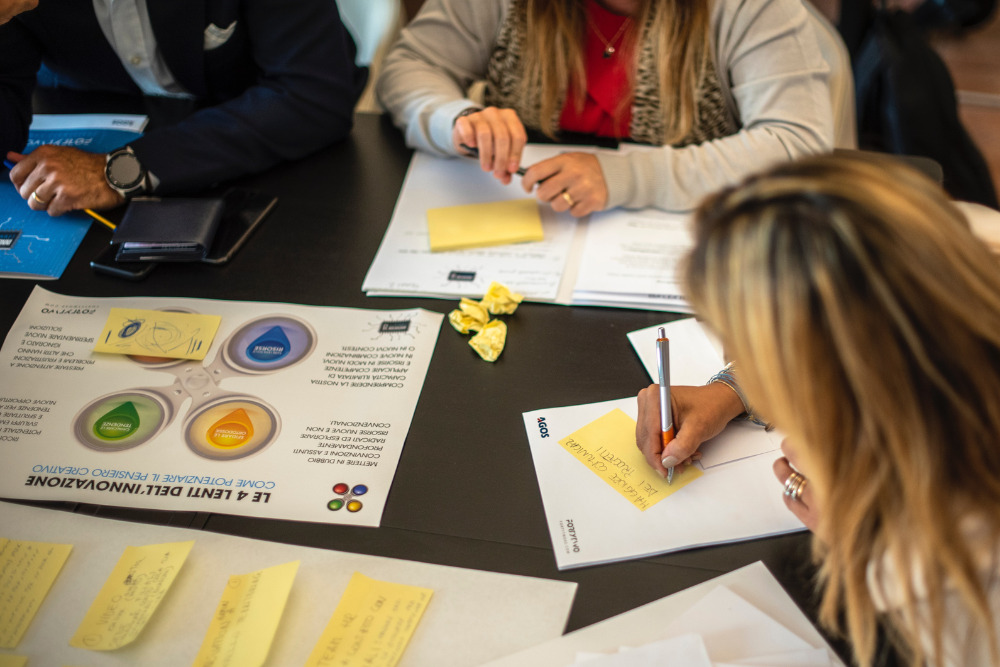
Lotus Blossom
Some of the most effective techniques are those that encourage free-thinking and rapid ideation while also having some rules that can keep things structured. Lotus Blossom combines these concepts while also creating a great visual representation of your brainstorming activity.
Lotus Blossom helps facilitate idea generation by working out from a central concept and adding eight additional themes or ideas inspired by the first on sticky notes. Once you have those eight ideas, you then invite participants to take each of those and add another eight and effectively blossom them around the original. By clustering ideas in this way, this ideation method also creates a visual resource you can come back to later and follow the brainstorming process from start to finish.
Lotus blossom #concepts #create #design #idea generation The lotus blossom method is a creativity exercise. It is a framework for idea generation, starting from one central theme. Eight conceptual themes grow out from the main theme and each of them are used as central theme to generate 8 more themes. Explore!
Starbursting
Complete freedom without an ideation framework isn’t always the best way to find and develop ideas. Structured techniques like Starbursting can help guide a team through more effective idea generation and ensure all key elements are considered at an early stage.
To begin, create a six-pointed star on a large piece of paper or online whiteboard. At the tip of each point of the star, write down the words Who, What, Why, Where, When and How. Invite the group to brainstorm ideas and questions related to each of these points in turn.
At this stage, the group only needs to brainstorm questions in each of these sections, leaving answers until later, though creating follow-up questions can also be helpful in effectively ideating on your central concept or problem.
When ideating on solutions to problems, it’s very easy to come to the table with underlying assumptions that can affect the course of the idea generation process. You can avoid this potential pitfall by using The 5 Whys to go further and deeper in a very simple, group-friendly manner.
Kick-off by working as a group to create a problem statement that you’ll work on solving. Once you have a concise statement, ask the group why you have this problem and discuss the answer. After working together to form a cohesive answer, ask the group why you have the problem again. By repeating the process, you and your team can dig deeper and find the root cause of the issue and move past the first, most obvious ideas.
The 5 Whys #hyperisland #innovation This simple and powerful method is useful for getting to the core of a problem or challenge. As the title suggests, the group defines a problems, then asks the question “why” five times, often using the resulting explanation as a starting point for creative problem solving.
Creative brainstorming techniques
All brainstorming is creative. Generating ideas and finding solutions often asks groups and teams to find new ways of looking at things but in this next section, we’ll look at techniques that aim to approach the ideation process from a unique or especially creative starting point.
If you’re finding your typical exercises aren’t yielding results or want to try something new, creative games like those below can create space for innovation. Let’s dig in!
Imagie-ination
Words are often our primary tool when it comes to starting a brainstorm or kicking off an idea generation workshop. While these kinds of techniques are tried and tested, it can also be useful to try something different that can unlock your team’s creativity.
With Imagie-ination, you’ll use images to help your group generate ideas that go beyond the norm. First, collect an assortment of images for your brainstorm and write down a simple description of the topic you want to generate new ideas around. Have each participant select an image and then come up with as many ideas as they can for how the image relates to the topic.
After the first round, you’ll then cluster ideas together and find an image and title to best illustrate those clusters. This kind of clustering and titling can help refine the ideas your team has generated and move them towards action – a great outcome for any brainstorming session!
Imagie-ination #idea generation #gamestorming Images have the ability to spark insights and to create new associations and possible connections. That is why pictures help generate new ideas, which is exactly the point of this exercise.
Bad idea brainstorming
Idea generation is at its best when groups are encouraged to add their ideas without being self critical or overthinking. Often, individuals involved in ideation can put pressure on themselves to offer only great ideas and so don’t contribute everything that comes to their minds.
Use this brainstorming technique to help free your group’s creativity and encourage them to come up with the absolute worst ideas they can in relation to a central topic or problem. Like reverse brainstorming, this brainstorming technique is a great way to find alternative routes to more creative ideas. Just be sure to use a swot analysis to figure out what should make it into reality!
Bad Idea Brainstorm #brainstorming #creative thinking #idea generation Name all the bad ideas to make room for good ones. Coming up with the perfect solution right off the bat can feel paralyzing. So instead of trying to find the right answer, get unstuck by listing all the wrong ones.
Brainstorm questions instead of solutions
Our first instinct when it comes to problem-solving can often be to jump straight to giving answers and finding solutions. Though this can be effective, when it comes to generating creative ideas, a different tact can be more effective.
With this reverse brainstorming game, challenge participants to offer questions instead of solutions so they can respond to a central concept creatively and from a new angle. If you’re finding your group can become blocked when generating ideas, it might be that your existing questions or frameworks aren’t sufficient. By taking a new ideation approach, you can unblock your team!
Brainstorm questions instead of solutions #questions and answers #brainstorming When we are given a problem our reflex is to find answers. But it can be difficult to leave the comfort zone and to come up with creative answers. This exercise will encourage to think out of the box.
Stakeholder Round Robin Brainstorm
Bringing together groups of different stakeholders with their own areas of expertise is a great idea whether you’re brainstorming or finding solutions. That said, it’s worth noting that in these kinds of mixed groups, participants will be coming from different places and have different priorities and approaches to idea generation.
Start by creating a flipchart or whiteboard space for each stakeholder’s perspective and writing this at the top. Give each stakeholder two minutes to brainstorm on the central idea from their perspective and add those to their flipchart before then inviting each participant to move to the next one and brainstorm from this different perspective. By using this round-robin brainstorming exercise, you can help the group understand the perspectives and insights each member brings to the table while also generating fresh ideas as a result!
Backcasting
A simple change in perspective can have a massive impact on how your team approaches solving a problem. Backcasting is a simple but effective brainstorming exercise where a team is invited to work backwards from an ideal future state in order to come up with concrete actions they can take today.
Start by listing your long term goals in a time frame of 1-20 years. Then work backwards from that state to today, listing every action necessary to achieve that goal state. Collect insights on what difficulties might come up, what steps your team needs to take and what resources you might need in order to brainstorm effectively and find a new way to reach your team’s long term goals!
Backcasting #define intentions #create #design #action Backcasting is a method for planning the actions necessary to reach desired future goals. This method is often applied in a workshop format with stakeholders participating. To be used when a future goal (even if it is vague) has been identified.
Walking Questions
A brainstorming technique with a What if learning style, Walking Questions is a great way of encouraging group members to share knowledge, ask questions to personal problems, and explore a topic dynamically.
Best used at the end of a training session or workshop, each participant writes a question they have on the top of a sheet of paper then hands it to the person to their right. The person receiving the paper then writes any ideas or answers they have underneath and passes it to the next person.
By the end, the original piece of paper will be returned to the owner filled with ideas and answers from the entire group. It’s a great way of generating ideas from a group quickly and efficiently and of utilizing everyone’s expertise in a structured way. Give it a go!
Walking questions #what if learning style #idea generation #learning This is a great facilitation technique to answer open questions of trainees with a “What if” learning style. It prevents the facilitator from answering all questions herself. With this method trainees can: close knowledge gaps find solutions for personal problems imagine themselves using their new knowledge in future and prepare themselves for obstacles
Guided Imagery
Coming up with new ideas doesn’t always have to be boisterous! You can also get the creative juices flowing in a relaxed way by tapping into mindfulness and imagination with this method.
Start by inviting participants to close their eyes and get comfortable. Next, progress through a guided meditation designed to inspire creativity. Afterward, ask your group to reflect on what came up for them in the meditation and use this as the basis for further brainstorming!
Guided Imagery #idea generation #creativity #online facilitation #reflection This can be used for idea generation especially when the group is stuck.
Headlines from the future
Starting from the desired outcome and working backward with a reverse brainstorming technique can be a great way to solve a problem. Thinking into the future can also be inspiring in a way that encourages free thinking and big ideas – a great result for any brainstorming workshop.
In this idea generation game, ask your group to imagine it’s twenty years in the future and that your project or organisation has been a huge success. Invite each participant to draft a headline and sketch an image for a New York Times feature of this reality. Encourage big, bold ideas and debrief by discussing any common themes or ideas before moving onto idea development as a team!
Headlines from the Future #creative thinking #design #idea generation #creativity Get inspired today by a world 20 years away. Sometimes it helps to start from the end. This exercise will help you align with your team on an audacious vision for your project – one that you can work backward from.
Brainstorming techniques for problem solving and refining ideas
When you want to go beyond initial brainstorming and generate more refined ideas, the following complex idea generation techniques can effectively guide you through the process.
These activities combine brainstorming with idea evaluation, idea selection, and then going into concept development to help you come up with the best options. Let’s dig in!
25/10 Crowd Sourcing
Group ideation can be tricky to manage, and not all techniques are up to the task of managing creative input from large groups effectively. 25/10 Crowd Sourcing is a fantastic exercise that not only invites big, bold ideas, but can ensure everyone takes part in generating ideas as a group.
After first inviting participants to write a big, bold idea on an index card, start a timer and invite the group to move around the space and exchange cards without reading. Stop the timer and ask each person to read the idea and give it a score from 1 to 5. Repeat five times so that each idea has a score out of twenty-five and then find and share the top ten ideas with the group.
Group brainstorming techniques with a mix of blind scoring and sharing can be especially useful in avoiding bias and encouraging bold ideas – especially useful when ideating in large groups!
25/10 Crowd Sourcing #idea generation #liberating structures You can help a large crowd generate and sort their bold ideas for action in 30 minutes or less! With 25/10 Crowd Sourcing , you can spread innovations “out and up” as everyone notices the patterns in what emerges. Though it is fun, fast, and casual, it is a serious and valid way to generate an uncensored set of bold ideas and then to tap the wisdom of the whole group to identify the top ten. Surprises are frequent!
3-12-3 Brainstorm
Brainstorming is often associated with fast ideation and energetic idea generation sessions. While many standard techniques can be slowed down and run in different ways, there can be obvious benefits to maintaining energy and proving the value of short working bursts to your ideation group.
The 3-12-3 Brainstorm technique taps into the power of speed to generate great ideas and can help a team generate, develop, and present ideas in just less than twenty minutes. By combining speed and structure, this ideation method can help a group pressed for time use the session effectively, and we love how much ground can be covered by a group with this exercise!
3-12-3 Brainstorm #gamestorming #idea generation This format for brainstorming compresses the essentials of an ideation session into one short format. The numbers 3-12-3 refer to the amount of time in minutes given to each of three activities: 3 minutes for generating a pool of observations, 12 for combining those observations into rough concepts, and 3 again for presenting the concepts back to a group.
Mash-Up Innovation
Some of the best ideas come from taking existing ideas and putting them together. Brainstorming that takes advantage of what your group already knows and loves can really supercharge the idea generation process and this creative exercise is a perfect example of that.
In Mash-Up innovation, first ask your group to brainstorm around three different topics or areas and add them to a shared space or whiteboard. Next, organize your participants into small groups who will spend the next twelve minutes combining and mashing up as many of the elements as possible to make even better ideas. After a short idea presentation, you can even take your group through an idea development stage to really make the most out of this activity. You’ll be surprised at what comes out!
Mash-Up Innovation #hyperisland #innovation #idea generation Mash-ups is a collaborative idea generation method in which participants come up with innovative concepts by combining different elements together. In a first step, participants brainstorm around different areas, such as technologies, human needs, and existing services. In a second step, they rapidly combine elements from those areas to create new, fun and innovative concepts. Mash-ups demonstrates how fast and easy it can be to come up with innovative ideas.
Large group brainstorming can be dynamic, exciting, and productive but without structure and strong facilitation, it can also become disorganized and frustrating. 1-2-4-All is a classic idea generation process that not only helps ideas find space to allow idea development but also ensures the entire group can contribute to the session.
Start by inviting silent self-reflection on a shared challenge or question before then moving to pairs, foursomes, and then entire group ideation. One of the many benefits of this brainstorming technique is that everyone gets a chance to contribute freely and share their ideas in a structured way. In groups where conversation can become dominated by strong personalities or not everyone gets a chance to speak, this method is well worth employing.
1-2-4-All #idea generation #liberating structures #issue analysis With this facilitation technique you can immediately include everyone regardless of how large the group is. You can generate better ideas and more of them faster than ever before. You can tap the know-how and imagination that is distributed widely in places not known in advance. Open, generative conversation unfolds. Ideas and solutions are sifted in rapid fashion. Most importantly, participants own the ideas, so follow-up and implementation is simplified. No buy-in strategies needed! Simple and elegant!
One will get you Ten
Ideas most often spring from other ideas, and the sharing and co-creation of ideas during a brainstorm or idea generation workshop is where the magic really happens. This technique uses the sharing of ideas between teams as a central concept and it’s a great way of having participants communicate and learn from one another’s ideas meaningfully.
After first generating ideas solo and as a team, this ideation game asks team members to pair up with members of another team and share ideas. Each member then returns to their own team and presents two ideas – one of their own, and one from the other team – while the rest of the team guesses whose is whose. It’s interesting to see how participants package and present generated ideas and find ways to improve them organically as part of a rapid ideation.
One will get you Ten #thiagi #idea generation #team If I give you a dollar and you give me a dollar, we both end up where we began. But if I give you an idea and you give me an idea, we end up with two ideas each, benefiting from a 100 percent return on our investment. In One Will Get You Ten, we leverage this principle so that you and all other participants receive a 1000 percent return on your investment on ideas.
The Creativity Dice
When approaching the idea generation process it can be tempting for a team to go with what’s worked in the past and get locked into what appears to be working. Games that challenge the status quo and challenge teams in ways they don’t expect can be especially effective when generating ideas.
The Creative Dice is a brainstorming technique that encourages participants to work in three minute bursts and work on either specification, investigation, ideation, incubation, Iteration or integration based on a roll of the dice. By moving between different modes, this method prevents premature closure of one line of ideation and keeps the session energized and engaging. What’s more, the non-linear thinking can help with idea development too!
The Creativity Dice #creativity #problem solving #thiagi #issue analysis Too much linear thinking is hazardous to creative problem solving. To be creative, you should approach the problem (or the opportunity) from different points of view. You should leave a thought hanging in mid-air and move to another. This skipping around prevents premature closure and lets your brain incubate one line of thought while you consciously pursue another.
Affinity Map
Using brainstorming techniques to get a large number of ideas together quickly and efficiently is a great first step to developing new solutions or solving problems. But what to do once you’ve generated lots of ideas and want to work on idea development? Affinity Map is a great method for organizing your group’s brainstormed ideas and for both seeing and challenging existing patterns.
Starting with a simple brainstorm, Affinity Map asks that the group collectively organizes the ideas into columns or groups based on relationships. By doing this idea clustering as a group, your team can take ownership of the idea generation process and discover patterns of thinking together! It’s a great way of identifying and improving a group’s natural inclinations while also creating meaningful ideas.
Affinity Map #idea generation #gamestorming Most of us are familiar with brainstorming—a method by which a group generates as many ideas around a topic as possible in a limited amount of time. Brainstorming works to get a high quantity of information on the table. But it begs the follow-up question of how to gather meaning from all the data. Using a simple Affinity Diagram technique can help us discover embedded patterns (and sometimes break old patterns) of thinking by sorting and clustering language-based information into relationships. It can also give us a sense of where most people’s thinking is focused

Fun brainstorming games
Brainstorming is often a fast-paced and engaging process that results in a group having fun. Creative brainstorming games that help participants have fun while generating ideas are also effective ways of loosening folks up and getting into new ways of thinking. If you’re finding your group stuck
In this section, we’ll look at brainstorming games that intentionally take a fun angle as a means to create better ideas.
Energy, fun, and creativity go hand-in-hand, and brainstorming techniques that encourage these items and generate ideas quickly and effectively – especially with large groups!
In MindSpin, teams of 3-5 participants are challenged to write as many ideas as they can in two five-minute rounds. Whenever a person writes an idea, they slam it down on the table. If they cannot think of one, they can take an idea from the person on their left and hopefully be inspired to write an additional card they also slam on the table. Remember that this brainstorming game is designed to be fast and loud while getting creative juices flowing. Encourage all participants to really slam their ideas down and keep things moving!
MindSpin #teampedia #idea generation #problem solving #action A fast and loud method to enhance brainstorming within a team. Since this activity has more than round ideas that are repetitive can be ruled out leaving more creative and innovative answers to the challenge.
Figure storming
One potential difficulty when generating ideas is that not everyone feels comfortable sharing or holds back their ideas for fear of judgment. Creative brainstorming is all about removing restrictions or hesitation, and enabling your group to ideate freely – figure storming is a great method for achieving this!
Start by asking the group how a famous person, fictional character or well-known creative would approach the problem or topic at hand. You might ask how Albert Einstein, Elizabeth Bennett or Barack Obama might think about the ideas or concepts at hand. By inhabiting a different person’s perspective, not only can teams and individuals access new ideas, but they can also do so free of judgment. Also, it can be great fun to invite Atilla the Hun or Cleopatra to your creative exercises!
Flip and Rip
Images can often unlock our creativity but when using them to generate ideas, it can sometimes be difficult to know where to start. This visual brainstorming technique places some rules on how a group will both source and use images, and can encourage some really creative ideas!
Start by giving participants two magazines or image sets each. Then, invite each person to tear our whatever images stand out to them or grab their attention. Next, give them a problem statement and encourage them to find the connections between the problem and their chosen images. These unexpected connections between visuals can then be used as the foundation for further ideas! Plus, who doesn’t love the sound and feeling of tearing paper!
Flip and Rip #idea generation #problem solving #creativity #online Creativity through pictures and images
Forced Connections
An important part of the ideation process is giving your team permission to be silly and bring ideas to the table without fear of judgement or inhibitions. Empowering your team to be creative without limiting themselves can massively affect the effectiveness of your brainstorming and so it’s worth spending time to unblock your participants early.
Assemble a collection of random objects or images and invite participants to choose two or more items and brainstorm how they might be used together or connected in some way. Encourage out-of-the-box thinking and unusual ideas by bringing a collection of odd items to the table and you’ll be surprised at all the ideas your team can generate!
The Thing from the Future
Science fiction and speculative thinking about the future has long been a great source of ideas. In this brainstorming exercise, invite groups to co-design their ideal future by creating tangible objects with their imaginations.
Begin by sourcing a heap of prototyping materials and craft supplies. Invite participants to imagine an ideal future state and create an object that has time travelled back to the present. After spending some time creating strange and wonderful objects, participants then present them to the group and tell stories about the objects to inform future strategies and ideas.
If you’re looking for a fun, practical exercise to bring to your brainstorming session and encourage creative thinking, this activity is a great choice!
The Thing from the Future #imagination #storymaking #idea generation #issue analysis Help a group to time-travel and tap their imagination by fictional objects. With tangible objects and the stories your participants make up w/ them you’ll get so much richer inputs and context to inform joint visioning / strategizing: The future doesn’t look that far away when you can pick it off the shelf.
Making Lemonade
Sometimes, the best ideas come from moments of adversity or struggle. This brainstorming exercises leverages the power of positive thinking and attempting to make the best of a bad situation to generate creative ideas.
Start by sharing a couple of negative scenarios that might radically change something in the world. For example, everyone in the world has a cold, it rains constantly or we lost all our customers over night.
Next, ask your group to take something that appears negative and aim to reframe it to be as positive as possible while coming up with ideas of how that change might actually have a positive impact. Rain every day? That might be the end of drought and a boom to umbrella sales!
Making Lemonade #creative thinking #creativity #design #idea generation Try on a relentlessly positive, can-do attitude before tackling the big stuff. The proverb goes “If life gives you lemons, make lemonade.” Practice the art of positive thinking to unlock creative ideas. Use this as a warm-up before brainstorming or to energize your team meetings.

Visual brainstorming techniques
Visual brainstorming is a great way of helping your teams out of creative roadblocks and encouraging fresh ideas. When words fail, images can enliven, invigorate and inspire your process. In this section, we’ll look at some great brainstorming techniques that focus on drawing or creating visual responses when ideating. Let’s take a look!
Brainstorming shouldn’t stop when you have your first good idea. Fast iteration and refinement can help your group discover better ideas and develop ideas in record time. With 6-8-5, you can encourage your team to move from brainstorming to idea development in just a few minutes, and by asking participants to draw, you can keep things flowing easily!
Start by inviting your group to sketch 6-8 ideas in response to a central question or topic in five minutes. Encourage your team to be rough and not to worry about finesse at this stage – remember that the first stage of brainstorming works best when it’s free and unrestricted!
After a quick round of presenting ideas, go through the sketching process again and encourage idea development or ideas that have come out of group sharing. The result will be a heap of ideas and sketches you can move forward with too!
6-8-5 #gamestorming #idea generation Part of the reason we end up with under-developed ideas is that we stick with the first good idea we have — rather than taking the time to explore complementary approaches. 6-8-5 is designed to combat this pattern by forcing us to generate lots of ideas in a short period of time. The activity can then be repeated to hone & flesh out a few of the best ideas.
Four Step Sketch
Visual brainstorming techniques can be great right at the start of the process but they can be equally effective later on when it comes to idea development. In this exercise pulled from the design sprint playbook, take your group through a structured ideation process that encourages reflection, quick sketching and a completed idea too.
Begin by reviewing any existing materials or outputs from earlier exercises before then having your group do a round of Crazy 8’s, where they create eight sketched variations on their idea. At this stage, you then invite participants to finesse their idea and create a final polished sketch to share with the team. By mixing reflection, ideation and development, this brainstorming technique offers a structured path towards better ideas!
Four-Step Sketch #design sprint #innovation #idea generation #remote-friendly The four-step sketch is an exercise that helps people to create well-formed concepts through a structured process that includes: Review key information Start design work on paper, Consider multiple variations , Create a detailed solution . This exercise is preceded by a set of other activities allowing the group to clarify the challenge they want to solve. See how the Four Step Sketch exercise fits into a Design Sprint
Drawing Together
Visual thinking is a powerful tool for any creative process or brainstorming workshop. This brainstorming game asks teams to tell stories about a personal or group challenge personal by expressing themselves with just five simple symbols drawn on paper. After a first draft, participants are then invited to refine their stories with colour, size and placement before the group interprets them.
By expressing themselves in a novel way, participants can exercise their creative muscles and consider new ways to express ideas nonverbally.
Drawing Together #skills #liberating structures #visual methods You can help people access hidden knowledge such as feelings, attitudes, and patterns that are difficult to express with words. When people are tired, their brains are full, and they have reached the limits of logical thinking, you can help them evoke ideas that lie outside logical, step-by-step understanding of what is possible. Stories about individual or group transformations can be told with five easy-to-draw symbols that have universal meanings. The playful spirit of drawing together signals that more is possible and many new answers are expected. Drawing Together cuts through the culture of overreliance on what people say and write that constrains the emergence of novelty. It also provides a new avenue of expression for some people whose ideas would otherwise not surface.
Brainstorming games for warming up
Generating ideas and thinking creatively isn’t always easy. Finding ways to energize and prepare your group for brainstorming with simple and fun warm-ups can help ensure the success of the workshop or session and introduce key idea generation concepts too.
While these creative games don’t necessarily create ideas in themselves, they are a great way to get teams ready for the next step. Let’s take a look!
When it comes to warming people up for an idea generation workshop, simple is best. With Draw Toast, you can introduce your group to visual thinking, working memory and systems thinking, all through the prism of a simple warm-up that works well online or offline!
For this creative exercise, invite your participants to illustrate how to make toast with a sketch or diagram without using any text. Afterward, share observations and insights as a group and outline the fact that there is no right or wrong diagram, and that differing and unique approaches to a problem or concept are all valid and useful. Not only is this a fun, fast brainstorming technique, but it prepares a group for the next stages of idea generation too!
Draw toast #problem solving #opening #design #gamestorming #idea generation You can use the Draw Toast exercise to introduce people to the concepts of visual thinking, working memory, mental models and/or systems thinking. This also works as a nice warm-up exercise to get people engaged with each other and thinking visually. Plus, it’s fun!
The Paper Clip Method
Even established and successful groups have preconceptions about brainstorming or how to generate ideas. Warming up a team by introducing the power of brainstorming practically can prevent stumbling blocks later on and ensure everyone is on the same page when approaching the brainstorming process.
The Paper Clip Method is a creative exercise that challenges your group to brainstorm all possible uses for a paper clip. After some silent brainstorming, debrief by sharing what the group has come up with and highlight how the group has cumulatively come up with a greater quality and quantity of ideas than any single person could.
The paper clip method #sharing #creativity #warm up #idea generation #brainstorming The power of brainstorming. A training for project leaders, creativity training, and to catalyse getting new solutions.
Apple-Drawing Ideation
Learning how to approach creative brainstorming as a group is a worthwhile way to kick-off your idea generation workshop. In this simple creative game, split your participants into groups and invite them to take it in turns to fill a grid with drawings of apples, with the challenge that no apple can be the same as another.
When the time is done or the grid is full, debrief and highlight some of key concepts for effective brainstorming including the fact quantity is a precursor to quality and that we should try to build on the ideas of others. This brainstorming game is flexible by design and you can use it with something other than apples for a more practical application: e.g., draw 30 logos, write 30 taglines, draw 30 new cars.
Apple-Drawing Ideation #hyperisland #innovation #idea generation The purpose of this simple exercise is to demonstrate three key principles useful for creativity and idea generation: quantity is a condition for quality; building on the ideas of others; the ideas we come up with are usually all the same. The format is simple, with small groups standing and drawing apples. At the end of the exercise, the whole group reflects and draws out learnings and reflections.
Activities to support a brainstorming workshop
We’ve covered everything from fast and fun creative games to in-depth brainstorming techniques, but what about if you’re looking for ways to improve or kick start your brainstorming process? Preparing for a brainstorming workshop with research on inspiration collection can really help your team make the most of the upcoming session.
In this section, we’ll look at some techniques and methods you can use to inform, enable and improve your group brainstorm and bring better quality ideas to the table!
Rapid Research
Like all effective workshops, idea generation sessions generally want to limit the number of participants in the room to ensure productivity. That said, ideas and insight can come from anywhere in an organisation and this brainstorming technique can tap into the expertise of people outside of the room.
Start by asking participants to think of a colleague or peer outside the room and call them to get a perspective on the topic or question at hand. For remote teams, you can arrange quick calls or use Slack or other tools to get quick and useful feedback. After collecting input, bring the group back together to share and document insights. You’ll be surprised at how quickly and effectively you can get a wide variety of useful information!
Rapid Research #hyperisland #innovation #idea generation A simple exercise that complements exploratory, discursive, and creative workshops with insights and opinions from outside. Use this exercise when brainstorming ideas, developing a new product or service or creating a strategy or plan that will include others. Participants phone a co-worker and ask them questions relevant to the task. This quickly generates meaningful input from a range of “outside” perspectives. Often, participants will be surprised at how simple it was to solicit this input and how valuable it is to the process.
Lightning Demos
No idea is wholly original. Brainstorming is all about taking existing ideas and learning from others while also bringing our own insights to the table.
With this activity, you and your group will look for inspiration from how other organizations, products or thought leaders have solved or approached the problem or topic at hand. Invite participants to spend a little time gathering 2-3 examples before then presenting ideas back to the group. By the end of the exercise, you’ll have a set of ideas you can use as the basis for further discussion or idea development.
If you’re working online, collect demos in an online whiteboard and even explore the possibility of gathering inspiration before the workshop if your team has a busy schedule.
Lightning Demos #design sprint #innovation #idea generation This is an exercise to inspire your team with products or services that they think they can use as inspiration for their concepts in the next phases of their design sprints.
The Medici Effect
Great ideas can often come from sources outside of your own industry or field. The Medici Effect is inspired by Frans Johansson’s book The Medici Effect, which explores how game-changing ideas and breakthroughs can occur when concepts and ideas from one area are applied to another and used as the basis for innovation.
In this exercise, invite participants to find examples of how individuals from other fields have achieved their goals and come up with great ideas. Think of successful scientists, creatives, business owners, musicians, entrepreneurs, educators etc. have found success and what inspiration you and your team might take from them. If working online, encourage participants to include images, links and quotes so you can create an inspiration wall for further exploration of the problem you are trying to solve!
Brainstorming session templates
Are you looking to run a workshop or meeting where you need a complete group process to come up with ideas and turn those into actions?
Check out the brainstorming session templates below to see how to build upon an initial brainstorming session with appropriate idea selection and prioritization tools to arrive at sound group decisions.!
Ideation Workshop
In this one-day workshop template, follow an entire ideation process from start to finish, going from brainstorming and idea generation through to idea development and pitching. Tap into concepts such as disruptive cases, future tech & trends and opposite thinking to create innovative ideas and empower your team!
One Hour Brain Sprint
Have imited time for group brainstorming? Try the One Hour Brain Sprint to generate ideas quickly and effectively, all while avoiding unproductive discussions and the pitfalls of some brainstorming approaches.
One-hour Brain Sprint
Remote Problem Solving Workshop
Want to solve problems with your remote team? This virtual workshop template includes several stages of ideation and development and provides a great example of how you might utilize lightning demos and research as a basis for experimental ideas and solutions.
Remote problem solving workshop
What are the benefits of group brainstorming ?
While the primary measure of success for a brainstorming workshop will be the quantity and quality of ideas generated, the benefits of this kind of session can go much further.
Establishing an ideation mindset and encouraging creative thinking will benefit your organization in the long term, and finding new ways to push your team in the direction of generating effective ideas has positive effects for your whole organization. Let’s see some of the benefits that can come from bringing team members together for a brainstorming session.
Encourage creativity
Creative games and exercises can yield instant results when it comes to creatively engaging a team and generating ideas but beyond that, regular brainstorming can help participants be more creative in their regular work and find methods of finding new ideas and solutions that work for them. Being creative is a wonderful way to engage a group and getting out of a regular workflow can be the key that unlocks innovation.
Inclusive, easy-to-understand activities
Brainstorming is a simple group activity that is easy to understand and contribute to. Whatever skill level or competency a person has, the first stage of the idea generation process is something that can be involved in with little overhead or difficulty. This can have massive value in helping a team come together toward a shared goal in an inclusive and simple way!
Diverse ideas
Relying on certain teams or individuals to generate ideas alone can lead to stagnation. By pooling together a diverse group of people to contribute to generating and developing ideas, brainstorming can be a great way to find innovative approaches and diverse ways of thinking. Every point of view you bring to the table is another way of approaching the issue and the results generated by diverse groups are often more robust and multi-facted than those made in a silo.
Quantity of ideas
When it comes to brainstorming techniques, quantity often comes before quality. In order to find great ideas, a group first needs to flush out as many ideas as possible and share before moving onto idea development. The best brainstorming exercises encourage the creation of large amounts of ideas in a short period of time, providing a great foundation for the next steps!
Get past creative blocks
Problem solving or idea generation can go around in circles if a team isn’t given the freedom to think creatively and approach things from a new angle. Brainstorming methods like those featured here are great ways to unblock a team’s creative and find new ways to approach stalled conversations.
Improve team morale
Brainstorm sessions are often fun and energetic by their nature, and games and exercises that focus on idea generation allow for everyone to contribute and feel heard as part of their team. These kinds of idea generation activities can really help bring a team together and improve team morale too – everyone wants to take part in developing new ideas and being creative!
Get project buy-in
Involving participants across departments and specialties early in the process by inviting them to contribute to generating and developing ideas can not only lead to great ideas but also ensure that a project is followed through on. Get buy-in early by involving stakeholders in early brainstorming sessions and help that creative energy continue throughout your project!
Kickstart projects with energy
The opening stages of a project can determine the tone for the rest of it, and by kicking off your projects with a fun, energetic brainstorming workshop, you can ensure everyone is energised for the work ahead. Try creative games to help your team approach the project with a sense of creativity and experimentation and use brainstorming techniques that see proven results to help move a team forward effectively.
Brainstorming sessions made simple
An effective brainstorming session means creating a balanced agenda of activities and group discussions while keeping everyone engaged.
With SessionLab, you drag, drop and reorder blocks to build your step-by-step agenda.
Your session timing adjusts automatically as you make changes and when you’re done, you can share a beautiful printout with your colleagues and participants.
Explore how facilitators use SessionLab to design effective workshops that create results or watch this five minute video to see the planner in action!

Over to you
Brainstorming can be simple or complex, visual or virtual, but whatever method you choose to use, the results should be the same – great ideas. Finding new ways to facilitate innovation is something we’re passionate about here at SessionLab, and we hope you find the above brainstorming techniques useful!
Did we miss anything? Are there any great brainstorming or idea generation methods you’d like to add? We’d love to hear from you in the comments.
Leave a Comment Cancel reply
Your email address will not be published. Required fields are marked *

Going from a mere idea to a workshop that delivers results for your clients can feel like a daunting task. In this piece, we will shine a light on all the work behind the scenes and help you learn how to plan a workshop from start to finish. On a good day, facilitation can feel like effortless magic, but that is mostly the result of backstage work, foresight, and a lot of careful planning. Read on to learn a step-by-step approach to breaking the process of planning a workshop into small, manageable chunks. The flow starts with the first meeting with a client to define the purposes of a workshop.…

How does learning work? A clever 9-year-old once told me: “I know I am learning something new when I am surprised.” The science of adult learning tells us that, in order to learn new skills (which, unsurprisingly, is harder for adults to do than kids) grown-ups need to first get into a specific headspace. In a business, this approach is often employed in a training session where employees learn new skills or work on professional development. But how do you ensure your training is effective? In this guide, we'll explore how to create an effective training session plan and run engaging training sessions. As team leader, project manager, or consultant,…

Effective online tools are a necessity for smooth and engaging virtual workshops and meetings. But how do you choose the right ones? Do you sometimes feel that the good old pen and paper or MS Office toolkit and email leaves you struggling to stay on top of managing and delivering your workshop? Fortunately, there are plenty of online tools to make your life easier when you need to facilitate a meeting and lead workshops. In this post, we’ll share our favorite online tools you can use to make your job as a facilitator easier. In fact, there are plenty of free online workshop tools and meeting facilitation software you can…
Design your next workshop with SessionLab
Join the 150,000 facilitators using SessionLab
Sign up for free

Brainstorming
What this handout is about.
This handout discusses techniques that will help you start writing a paper and continue writing through the challenges of the revising process. Brainstorming can help you choose a topic, develop an approach to a topic, or deepen your understanding of the topic’s potential.
Introduction
If you consciously take advantage of your natural thinking processes by gathering your brain’s energies into a “storm,” you can transform these energies into written words or diagrams that will lead to lively, vibrant writing. Below you will find a brief discussion of what brainstorming is, why you might brainstorm, and suggestions for how you might brainstorm.
Whether you are starting with too much information or not enough, brainstorming can help you to put a new writing task in motion or revive a project that hasn’t reached completion. Let’s take a look at each case:
When you’ve got nothing: You might need a storm to approach when you feel “blank” about the topic, devoid of inspiration, full of anxiety about the topic, or just too tired to craft an orderly outline. In this case, brainstorming stirs up the dust, whips some air into our stilled pools of thought, and gets the breeze of inspiration moving again.
When you’ve got too much: There are times when you have too much chaos in your brain and need to bring in some conscious order. In this case, brainstorming forces the mental chaos and random thoughts to rain out onto the page, giving you some concrete words or schemas that you can then arrange according to their logical relations.
Brainstorming techniques
What follows are great ideas on how to brainstorm—ideas from professional writers, novice writers, people who would rather avoid writing, and people who spend a lot of time brainstorming about…well, how to brainstorm.
Try out several of these options and challenge yourself to vary the techniques you rely on; some techniques might suit a particular writer, academic discipline, or assignment better than others. If the technique you try first doesn’t seem to help you, move right along and try some others.
Freewriting
When you freewrite, you let your thoughts flow as they will, putting pen to paper and writing down whatever comes into your mind. You don’t judge the quality of what you write and you don’t worry about style or any surface-level issues, like spelling, grammar, or punctuation. If you can’t think of what to say, you write that down—really. The advantage of this technique is that you free up your internal critic and allow yourself to write things you might not write if you were being too self-conscious.
When you freewrite you can set a time limit (“I’ll write for 15 minutes!”) and even use a kitchen timer or alarm clock or you can set a space limit (“I’ll write until I fill four full notebook pages, no matter what tries to interrupt me!”) and just write until you reach that goal. You might do this on the computer or on paper, and you can even try it with your eyes shut or the monitor off, which encourages speed and freedom of thought.
The crucial point is that you keep on writing even if you believe you are saying nothing. Word must follow word, no matter the relevance. Your freewriting might even look like this:
“This paper is supposed to be on the politics of tobacco production but even though I went to all the lectures and read the book I can’t think of what to say and I’ve felt this way for four minutes now and I have 11 minutes left and I wonder if I’ll keep thinking nothing during every minute but I’m not sure if it matters that I am babbling and I don’t know what else to say about this topic and it is rainy today and I never noticed the number of cracks in that wall before and those cracks remind me of the walls in my grandfather’s study and he smoked and he farmed and I wonder why he didn’t farm tobacco…”
When you’re done with your set number of minutes or have reached your page goal, read back over the text. Yes, there will be a lot of filler and unusable thoughts but there also will be little gems, discoveries, and insights. When you find these gems, highlight them or cut and paste them into your draft or onto an “ideas” sheet so you can use them in your paper. Even if you don’t find any diamonds in there, you will have either quieted some of the noisy chaos or greased the writing gears so that you can now face the assigned paper topic.
Break down the topic into levels
Once you have a course assignment in front of you, you might brainstorm:
- the general topic, like “The relationship between tropical fruits and colonial powers”
- a specific subtopic or required question, like “How did the availability of multiple tropical fruits influence competition amongst colonial powers trading from the larger Caribbean islands during the 19th century?”
- a single term or phrase that you sense you’re overusing in the paper. For example: If you see that you’ve written “increased the competition” about a dozen times in your “tropical fruits” paper, you could brainstorm variations on the phrase itself or on each of the main terms: “increased” and “competition.”
Listing/bulleting
In this technique you jot down lists of words or phrases under a particular topic. You can base your list on:
- the general topic
- one or more words from your particular thesis claim
- a word or idea that is the complete opposite of your original word or idea.
For example, if your general assignment is to write about the changes in inventions over time, and your specific thesis claims that “the 20th century presented a large number of inventions to advance US society by improving upon the status of 19th-century society,” you could brainstorm two different lists to ensure you are covering the topic thoroughly and that your thesis will be easy to prove.
The first list might be based on your thesis; you would jot down as many 20th-century inventions as you could, as long as you know of their positive effects on society. The second list might be based on the opposite claim, and you would instead jot down inventions that you associate with a decline in that society’s quality. You could do the same two lists for 19th-century inventions and then compare the evidence from all four lists.
Using multiple lists will help you to gather more perspective on the topic and ensure that, sure enough, your thesis is solid as a rock, or, …uh oh, your thesis is full of holes and you’d better alter your claim to one you can prove.
3 perspectives
Looking at something from different perspectives helps you see it more completely—or at least in a completely different way, sort of like laying on the floor makes your desk look very different to you. To use this strategy, answer the questions for each of the three perspectives, then look for interesting relationships or mismatches you can explore:
- Describe it: Describe your subject in detail. What is your topic? What are its components? What are its interesting and distinguishing features? What are its puzzles? Distinguish your subject from those that are similar to it. How is your subject unlike others?
- Trace it: What is the history of your subject? How has it changed over time? Why? What are the significant events that have influenced your subject?
- Map it: What is your subject related to? What is it influenced by? How? What does it influence? How? Who has a stake in your topic? Why? What fields do you draw on for the study of your subject? Why? How has your subject been approached by others? How is their work related to yours?
Cubing enables you to consider your topic from six different directions; just as a cube is six-sided, your cubing brainstorming will result in six “sides” or approaches to the topic. Take a sheet of paper, consider your topic, and respond to these six commands:
- Describe it.
- Compare it.
- Associate it.
- Analyze it.
- Argue for and against it.
Look over what you’ve written. Do any of the responses suggest anything new about your topic? What interactions do you notice among the “sides”? That is, do you see patterns repeating, or a theme emerging that you could use to approach the topic or draft a thesis? Does one side seem particularly fruitful in getting your brain moving? Could that one side help you draft your thesis statement? Use this technique in a way that serves your topic. It should, at least, give you a broader awareness of the topic’s complexities, if not a sharper focus on what you will do with it.
In this technique, complete the following sentence:
____________________ is/was/are/were like _____________________.
In the first blank put one of the terms or concepts your paper centers on. Then try to brainstorm as many answers as possible for the second blank, writing them down as you come up with them.
After you have produced a list of options, look over your ideas. What kinds of ideas come forward? What patterns or associations do you find?
Clustering/mapping/webbing:
The general idea:
This technique has three (or more) different names, according to how you describe the activity itself or what the end product looks like. In short, you will write a lot of different terms and phrases onto a sheet of paper in a random fashion and later go back to link the words together into a sort of “map” or “web” that forms groups from the separate parts. Allow yourself to start with chaos. After the chaos subsides, you will be able to create some order out of it.
To really let yourself go in this brainstorming technique, use a large piece of paper or tape two pieces together. You could also use a blackboard if you are working with a group of people. This big vertical space allows all members room to “storm” at the same time, but you might have to copy down the results onto paper later. If you don’t have big paper at the moment, don’t worry. You can do this on an 8 ½ by 11 as well. Watch our short videos on webbing , drawing relationships , and color coding for demonstrations.
How to do it:
- Take your sheet(s) of paper and write your main topic in the center, using a word or two or three.
- Moving out from the center and filling in the open space any way you are driven to fill it, start to write down, fast, as many related concepts or terms as you can associate with the central topic. Jot them quickly, move into another space, jot some more down, move to another blank, and just keep moving around and jotting. If you run out of similar concepts, jot down opposites, jot down things that are only slightly related, or jot down your grandpa’s name, but try to keep moving and associating. Don’t worry about the (lack of) sense of what you write, for you can chose to keep or toss out these ideas when the activity is over.
- Once the storm has subsided and you are faced with a hail of terms and phrases, you can start to cluster. Circle terms that seem related and then draw a line connecting the circles. Find some more and circle them and draw more lines to connect them with what you think is closely related. When you run out of terms that associate, start with another term. Look for concepts and terms that might relate to that term. Circle them and then link them with a connecting line. Continue this process until you have found all the associated terms. Some of the terms might end up uncircled, but these “loners” can also be useful to you. (Note: You can use different colored pens/pencils/chalk for this part, if you like. If that’s not possible, try to vary the kind of line you use to encircle the topics; use a wavy line, a straight line, a dashed line, a dotted line, a zigzaggy line, etc. in order to see what goes with what.)
- There! When you stand back and survey your work, you should see a set of clusters, or a big web, or a sort of map: hence the names for this activity. At this point you can start to form conclusions about how to approach your topic. There are about as many possible results to this activity as there are stars in the night sky, so what you do from here will depend on your particular results. Let’s take an example or two in order to illustrate how you might form some logical relationships between the clusters and loners you’ve decided to keep. At the end of the day, what you do with the particular “map” or “cluster set” or “web” that you produce depends on what you need. What does this map or web tell you to do? Explore an option or two and get your draft going!
Relationship between the parts
In this technique, begin by writing the following pairs of terms on opposite margins of one sheet of paper:
Looking over these four groups of pairs, start to fill in your ideas below each heading. Keep going down through as many levels as you can. Now, look at the various parts that comprise the parts of your whole concept. What sorts of conclusions can you draw according to the patterns, or lack of patterns, that you see? For a related strategy, watch our short video on drawing relationships .
Journalistic questions
In this technique you would use the “big six” questions that journalists rely on to thoroughly research a story. The six are: Who?, What?, When?, Where?, Why?, and How?. Write each question word on a sheet of paper, leaving space between them. Then, write out some sentences or phrases in answer, as they fit your particular topic. You might also record yourself or use speech-to-text if you’d rather talk out your ideas.
Now look over your batch of responses. Do you see that you have more to say about one or two of the questions? Or, are your answers for each question pretty well balanced in depth and content? Was there one question that you had absolutely no answer for? How might this awareness help you to decide how to frame your thesis claim or to organize your paper? Or, how might it reveal what you must work on further, doing library research or interviews or further note-taking?
For example, if your answers reveal that you know a lot more about “where” and “why” something happened than you know about “what” and “when,” how could you use this lack of balance to direct your research or to shape your paper? How might you organize your paper so that it emphasizes the known versus the unknown aspects of evidence in the field of study? What else might you do with your results?
Thinking outside the box
Even when you are writing within a particular academic discipline, you can take advantage of your semesters of experience in other courses from other departments. Let’s say you are writing a paper for an English course. You could ask yourself, “Hmmm, if I were writing about this very same topic in a biology course or using this term in a history course, how might I see or understand it differently? Are there varying definitions for this concept within, say, philosophy or physics, that might encourage me to think about this term from a new, richer point of view?”
For example, when discussing “culture” in your English, communications, or cultural studies course, you could incorporate the definition of “culture” that is frequently used in the biological sciences. Remember those little Petri dishes from your lab experiments in high school? Those dishes are used to “culture” substances for bacterial growth and analysis, right? How might it help you write your paper if you thought of “culture” as a medium upon which certain things will grow, will develop in new ways or will even flourish beyond expectations, but upon which the growth of other things might be retarded, significantly altered, or stopped altogether?
Using charts or shapes
If you are more visually inclined, you might create charts, graphs, or tables in lieu of word lists or phrases as you try to shape or explore an idea. You could use the same phrases or words that are central to your topic and try different ways to arrange them spatially, say in a graph, on a grid, or in a table or chart. You might even try the trusty old flow chart. The important thing here is to get out of the realm of words alone and see how different spatial representations might help you see the relationships among your ideas. If you can’t imagine the shape of a chart at first, just put down the words on the page and then draw lines between or around them. Or think of a shape. Do your ideas most easily form a triangle? square? umbrella? Can you put some ideas in parallel formation? In a line?
Consider purpose and audience
Think about the parts of communication involved in any writing or speaking act: purpose and audience.
What is your purpose?
What are you trying to do? What verb captures your intent? Are you trying to inform? Convince? Describe? Each purpose will lead you to a different set of information and help you shape material to include and exclude in a draft. Write about why you are writing this draft in this form. For more tips on figuring out the purpose of your assignment, see our handout on understanding assignments .
Who is your audience?
Who are you communicating with beyond the grader? What does that audience need to know? What do they already know? What information does that audience need first, second, third? Write about who you are writing to and what they need. For more on audience, see our handout on audience .
Dictionaries, thesauruses, encyclopedias
When all else fails…this is a tried and true method, loved for centuries by writers of all stripe. Visit the library reference areas or stop by the Writing Center to browse various dictionaries, thesauruses (or other guide books and reference texts), encyclopedias or surf their online counterparts. Sometimes these basic steps are the best ones. It is almost guaranteed that you’ll learn several things you did not know.
If you’re looking at a hard copy reference, turn to your most important terms and see what sort of variety you find in the definitions. The obscure or archaic definition might help you to appreciate the term’s breadth or realize how much its meaning has changed as the language changed. Could that realization be built into your paper somehow?
If you go to online sources, use their own search functions to find your key terms and see what suggestions they offer. For example, if you plug “good” into a thesaurus search, you will be given 14 different entries. Whew! If you were analyzing the film Good Will Hunting, imagine how you could enrich your paper by addressed the six or seven ways that “good” could be interpreted according to how the scenes, lighting, editing, music, etc., emphasized various aspects of “good.”
An encyclopedia is sometimes a valuable resource if you need to clarify facts, get quick background, or get a broader context for an event or item. If you are stuck because you have a vague sense of a seemingly important issue, do a quick check with this reference and you may be able to move forward with your ideas.
Armed with a full quiver of brainstorming techniques and facing sheets of jotted ideas, bulleted subtopics, or spidery webs relating to your paper, what do you do now?
Take the next step and start to write your first draft, or fill in those gaps you’ve been brainstorming about to complete your “almost ready” paper. If you’re a fan of outlining, prepare one that incorporates as much of your brainstorming data as seems logical to you. If you’re not a fan, don’t make one. Instead, start to write out some larger chunks (large groups of sentences or full paragraphs) to expand upon your smaller clusters and phrases. Keep building from there into larger sections of your paper. You don’t have to start at the beginning of the draft. Start writing the section that comes together most easily. You can always go back to write the introduction later.
We also have helpful handouts on some of the next steps in your writing process, such as reorganizing drafts and argument .
Remember, once you’ve begun the paper, you can stop and try another brainstorming technique whenever you feel stuck. Keep the energy moving and try several techniques to find what suits you or the particular project you are working on.
How can technology help?
Need some help brainstorming? Different digital tools can help with a variety of brainstorming strategies:
Look for a text editor that has a focus mode or that is designed to promote free writing (for examples, check out FocusWriter, OmmWriter, WriteRoom, Writer the Internet Typewriter, or Cold Turkey). Eliminating visual distractions on your screen can help you free write for designated periods of time. By eliminating visual distractions on your screen, these tools help you focus on free writing for designated periods of time. If you use Microsoft Word, you might even try “Focus Mode” under the “View” tab.
Clustering/mapping. Websites and applications like Mindomo , TheBrain , and Miro allow you to create concept maps and graphic organizers. These applications often include the following features:
- Connect links, embed documents and media, and integrate notes in your concept maps
- Access your maps across devices
- Search across maps for keywords
- Convert maps into checklists and outlines
- Export maps to other file formats
Testimonials
Check out what other students and writers have tried!
Papers as Puzzles : A UNC student demonstrates a brainstorming strategy for getting started on a paper.
Works consulted
We consulted these works while writing this handout. This is not a comprehensive list of resources on the handout’s topic, and we encourage you to do your own research to find additional publications. Please do not use this list as a model for the format of your own reference list, as it may not match the citation style you are using. For guidance on formatting citations, please see the UNC Libraries citation tutorial . We revise these tips periodically and welcome feedback.
Allen, Roberta, and Marcia Mascolini. 1997. The Process of Writing: Composing Through Critical Thinking . Upper Saddle River, NJ: Prentice Hall.
Cameron, Julia. 2002. The Artist’s Way: A Spiritual Path to Higher Creativity . New York: Putnam.
Goldberg, Natalie. 2005. Writing Down the Bones: Freeing the Writer Within , rev. ed. Boston: Shambhala.
Rosen, Leonard J. and Laurence Behrens. 2003. The Allyn & Bacon Handbook , 5th ed. New York: Longman.
University of Richmond. n.d. “Main Page.” Writer’s Web. Accessed June 14, 2019. http://writing2.richmond.edu/writing/wweb.html .
You may reproduce it for non-commercial use if you use the entire handout and attribute the source: The Writing Center, University of North Carolina at Chapel Hill

- 43 Creative writing exercises

A selection of fun creative writing exercises that can be completed solo, or with a group. Some are prompts to help inspire you to come up with story ideas, others focus on learning specific writing skills.
I run a Creative Writing Meetup for adults and teens in Montpellier or online every week. We start with a 5 to 20 minute exercise, followed by an hour and a half of silent writing, during which each participant focuses on their own project. Every exercise listed below has been run with the group and had any kinks ironed out. Where the exercises specify a number of people, if you have a larger group, simply split everyone up into smaller groups as appropriate.
The solo exercises are ideal to help stimulate your mind before working on a larger project, to overcome writer’s block, or as stand-alone prompts in their own right. If a solo exercise inspires you and you wish to use it with a larger group, give every member ten minutes to complete the exercise, then ask anyone who wishes to share their work to do so in groups of 3 or 4 afterwards.
Looking for something quick to fire your imagination? Check out these creative writing prompts for adults .
Writing Retreat in South France

A note on running exercises remotely
While you can enjoy the exercises solo, they are also designed for online writing groups using Zoom, WhatsApp, or Discord.
If you're running a group and follow a ' Shut Up and Write ' structure, I recommend connecting on WhatsApp (for example) first, doing the exercise together, sharing writing samples as needed. Next, write in silence for an hour and a half on your own projects, before reconnecting for a brief informal chat at the end. This works great with small remote groups and is a way to learn new techniques, gain online support, and have a productive session.
If you have a larger online group, it's worth looking into Zoom, as this has a feature called Breakout Rooms . Breakout Rooms let you split different writers into separate rooms, which is great for group activities. The free version of Zoom has a 40 minute limit, which can be restrictive, but Zoom Pro is well worth it if you're going to use it on a regular basis. In my experience, Zoom has a better connection than Facebook chat or WhatsApp.
A Letter From Your Character To You

Spend ten minutes writing a letter from a character in your novel to you , the author, explaining why you should write about them. This serves three purposes:
- As you write, it helps you get into the mindset of the character. Ask yourself how they would language this letter and what they would consider important.
- It's motivating to know that your character wants you to write about them.
- If your goal is to publish a complete work of fiction one day, whether it be a novel, a play or a movie script, you will want to contact an agent or publisher. This helps you practice in an easy, safe way.
If you're doing this exercise with a group of teens or adults, and some of the group haven't already started working on their masterpiece, they can instead choose any fictional novel they love. Ask participants to imagine that a character within the book wrote to the author in the first place to ask them to write their story. How did they plead their case?
The Opening Sentence

The opening sentence has to grab the reader's attention and make them want to keep reading. Many authors achieve this by starting with an action scene. In modern literature, it's best to avoid starting with someone waking up, or a description of the weather. In this exercise the task is to write an opening sentence either to a book you're currently writing, or simply for an imaginary piece of literature. Here are some of my favourite opening sentences to get you going:
It was a bright cold day in April, and the clocks were striking thirteen.
George Orwell , 1984
The Golem's life began in the hold of a steamship.
Helene Wecker , The Golem and the Djinni
All happy families are alike; each unhappy family is unhappy in its own way.
Leo Tolstoy , Anna Karenina
It wasn't a very likely place for disappearances, at least at first glance.
Diana Gabaldon , Outlander
You better not never tell nobody but God.
Alice Walker , The Color Purple
The cage was finished.
Gabriel Garcia Marquez , Balthazar’s Marvelous Afternoon
Imagine that you are living your life out of order: Lunch before breakfast, marriage before your first kiss.
Audrey Niffenegger , The Time Traveler's Wife
Far out in the uncharted backwaters of the unfashionable end of the western spiral arm of the Galaxy lies a small unregarded yellow sun.
Douglas Adams , The Hitchhiker's Guide to the Galaxy
There are a plethora of ways you can start a book, however two ways that help engage the reader immediately are:
- Set the scene in as few words as possible, so the reader immediately knows what's happening and wants to know what happens next. The scene must be original and create a vivid image in the reader's mind.
- Surprise the reader with an unusual event or usual point of view.
Spend 5 minutes working on your own opening sentence, then share it with the other participants.
Make your protagonist act!
Exercise for 2 writers, or can be done solo.

According to John Gardner:
"Failure to recognise that the central character must act, not simply be acted upon, is the single most common mistake in the fiction of beginners."
Spend 5 minutes writing a scene where the protagonist is passive in a conversation with one other character. It could be that the other character says something dramatic, and the protagonist just listens, or it could be anything else of your choice!
Once the 5 minutes is up, swap papers with another writer. If you're using Zoom, or working online, send it to each other in a private chat. Now the other person spends 8 minutes rewriting the scene to make the protagonist as active as possible. This might include:
Read both scenes together. Which makes you want to keep on reading?
If you're doing this as a solo writing exercise, simply complete both parts yourself.
- Showing the emotion this evokes.
- Getting them to disagree with the other character.
- Showing how they respond physically (whether it's as a physical manifestation of how they feel, or a dramatic gesture to make a point).
Overcoming writer's block
.webp)
Are you staring at a blank page or stuck for any story ideas? This exercise will help anyone who's experiencing writer's block with a particular piece of writing. If this isn't you, that's great, others will value your input!
If anyone has a particular scene they're stuck with (a pool of blood on the floor they have no explanation for, a reason why the rich lady just walked into a particular pub, etc.) then at the start of the exercise everyone briefly describes their scenes (if working online with a large group, typing it into the chat might be best). Everyone then chooses one scene to use as a writing prompt to write a short story for 10-15 minutes.
Afterwards, split into small groups if necessary, and read out how you completed someone else's writing prompt. As everyone listens to everyone else's ideas, this can be a wonderful source of inspiration and also improves your writing. As an alternative solo exercise, try free writing. With free writing, simply write as quickly as you can on the topic without editing or censoring yourself - just let your creative juices flow. If you're not sure what happens next, brainstorm options on the page, jot down story ideas, or just put, "I don't know what happens next." Keep going and ideas will come.
Writing Character Arcs

There are several different types of character arc in a novel, the 3 most common being:
For this exercise choose either a positive or negative character arc. Spend 8 minutes writing a scene from the start of a novel, then 8 minutes writing a scene towards the end of a novel showing how the character has developed between the two points. Don't worry about including how the character has changed, you can leave that to the imagination.
The point here is to capture the essence of a character, as they will be the same, but show their development.
- Positive - Where a character develops and grows during the novel. Perhaps they start unhappy or weak and end happy or powerful.
- Negative - Where a character gets worse during a novel. Perhaps they become ill or give in to evil tendencies as the novel progresses.
- Flat - In a flat character arc the character themself doesn't change much, however the world around them does. This could be overthrowing a great injustice, for example.
Sewing Seeds in Your Writing

In this exercise, we will look at how to sew seeds. No, not in your garden, but in your story. Seeds are the tiny hints and indicators that something is going on, which influence a reader's perceptions on an often unconscious level. They're important, as if you spring a surprise twist on your readers without any warning, it can seem unbelievable. Sew seeds that lead up to the event, so the twists and turns are still surprising, but make intuitive sense. Groups : Brainstorm major plot twists that might happen towards the end of the novel and share it in a Zoom chat, or on pieces of paper. Choose one twist each. Individuals : Choose one of the following plot twists: - Your friend is actually the secret son of the king. - Unreliable narrator - the narrator turns out to be villain. - The monster turns out to be the missing woman the narrator is seeking. - The man she is about to marry happens to already have a wife and three kids.
Write for ten minutes and give subtle hints as to what the plot twist is. This is an exercise in subtlety. Remember, when the twist occurs, it should still come as a surprise.

This is a fun writing activity for a small group. You’ve found a magic potion labelled ‘Cat Chat’ and when you drink it, you turn into whichever animal you’re thinking about; but there’s a problem, it also picks up on the brainwaves of other people near you!
Everyone writes down an animal in secret and then reveals it to the other writers. The spell will turn you into a creature that combines elements of all the animals. Each person then spends 5 minutes writing down what happens when they drink the potion.
After the 5 minutes is up, everyone shares their story with the other participants.
If you enjoy this exercise, then you may also want to check out our Fantasy and Sci-Fi writing prompts full of world building, magic, and character development prompts..

Joe Brainard wrote a novel called: I Remember It contains a collection of paragraphs all starting with “I remember”. This is the inspiration for this exercise, and if you’re stuck for what to write, is a great way to get the mental gears turning. Simply write “I remember” and continue with the first thing that pops into your head.
Spend 5 minutes writing a short collection of “I remember” stories.
Here are a couple of examples from Joe Brainard’s novel:
“I remember not understanding why people on the other side of the world didn't fall off.”
“I remember waking up somewhere once and there was a horse staring me in the face.”
Giving feedback to authors

If you're running a workshop for more experienced adult authors and have at least an hour, this is a good one to use. This is the longest exercise on this page, but I felt it important enough to include.
Give each author the option to bring a piece of their own work. This should be double spaced and a maximum of 3 pages long. If you're running a workshop where not everyone is likely to bring a manuscript, ask everyone who wants to bring one to print two copies each. If someone forgets but has a laptop with them, the reader can always use their laptop.
Print out a few copies and hand them around to everyone in the workshop of the guide on: 'How to give constructive feedback to writers'
Each author who brought a sample with them then gives them to one other person to review. They write their name on the manuscript in a certain colour pen, then add any comments to it before passing it to a second person who does the same (commenting on the comments if they agree or disagree).
Then allow 5 minutes for everyone to discuss the feedback they've received, ensuring they are giving constructive feedback.
The Five Senses

Painting by Giovanni Battista Manerius - The Five Senses
Choose a scene and write it for 5 minutes focusing on one sense, NOT sight. Choose between:
Hearing Taste Smell Touch
This can be internal as well as external (I heard my heartbeat thudding in my ears, or I smelt my own adrenaline).
After the 5 minutes stop and everyone reads it out loud to each other. Now write for another 5 minutes and continue the other person's story, but do NOT use sight OR the sense they used.
You can use any sense to communicate the essentials, just focus on creating emotions and conveying the story with the specific sense(s).
If you need some writing prompts, here are possible scenes that involve several senses:
- Climbing through an exotic jungle
- Having an argument that becomes a fight
- A cat's morning
- Talking to someone you're attracted to
Show don't tell
2 or 3 people

A lot of writing guides will advise you to, "Show, don't tell". What does this actually mean?
If you want to evoke an emotional reaction from your reader, showing them what is happening is a great way to do so. You can approach this in several ways:
Split up into pairs and each person writes down a short scene from a story where they "tell" it. After this, pass the description of the scene to your partner and they then have 5 minutes to rewrite it to "show" what happened. If there are an odd number of participants, make one group of three, with each person passing their scene clockwise, so everyone has a new scene to show. After the 5 minutes, for small groups everyone reads their new description to everyone else, or for large groups, each person just reads their new scene to their partner.
- Avoid internal dialogue (thinking), instead have your protagonist interact with other people, or have a physical reaction to something that shows how s/he feels. Does their heart beat faster? Do they notice the smell of their own adrenaline? Do they step backwards, or lean forwards?
- Instead of using an adjective like creepy, e.g. "Mary entered the creepy house", show why the house is creepy through description and in the way the protagonist responds - "The light streamed through the filthy skylight, highlighting the decomposing body of a rat resting on top of it. As Mary stepped inside, she felt a gust of freezing air brush past her. She turned, but there was nothing there..."
World building

World building is the art of conveying the magic of living in a different world, whether it's a spaceship, a medieval castle, a boat, or simply someone's living room. To master world building, it's not necessary to know every intricate detail, rather to convey the experience of what it would be like to live there.
Choose one of the above images as a prompt and spend 10 minutes writing a scene from the perspective of someone who is seeing it for the first time. Now, move your character six months forward and imagine they've spent the last six months living or working there. Write another scene (perhaps with an additional character) using the image as a background, with the events of the scene as the main action.
Click the above image for a close-up.
Gossiping about a character as if they're a friend.

Judy Blume says that she tells her family about her characters as if they’re real people.
Chris Claremont said, "For me, writing the 'X-Men' was easy - is easy. I know these people, they're my friends."
Today’s exercise has 2 parts. First, spend 5 minutes jotting down some facts about a character you’ve invented that might come up if you were telling your friends about them. Either choose a character in something you’ve already written, or invent one from scratch now.
Answer the questions:
What are they up to? How are they? What would you say if you were gossiping about them?
Then split up into groups of 4 to 6 writers. 2 volunteers from each group then role-play talking about their character as if they were a friend (perhaps another character in the story). The other participants will role-play a group of friends gossiping about the character behind their back and ask questions. If you don’t know the answer, invent it!
Degrees of Emotion Game

This is based on an acting game, to help actors understand how to perform with different degrees of emotion.
Ask everyone to write the following 4 emotions:
For groups of 5 or less, write down numbers starting with 1 and going up until everyone has a number, then give them out in order. For groups of 6 or more, divide groups into 3's, 4's or 5's.
Each person has to write a scene where the protagonist is alone and is only allowed to say a single word, e.g. "Banana". The writer with number 1 should write the scene with a very low level of the emotion (e.g. happiness), number 2 increases the intensity a bit and the highest number writes a scene with the most intense emotion you can possibly imagine.
Once each writer has written about happiness, rotate the numbers one or two spaces, then move onto anger, then fear, then sadness.
It can help to give everyone numbers showing the intensity of the emotions to write about at the start of the exercise, in which case you may wish to print either the Word or PDF file, then use the ones corresponding to 3, 4 or 5 writers.

Everyone shares their scene with the other course participants.
Three birds, one line

The first paragraph of a surprising number of best-selling novels serves multiple purposes. These are to:
- Establish a goal
- Set the scene
- Develop a character
Nearly every chapter in a novel also serves all three purposes. Instead of establishing a goal though, the protagonist either moves towards it, or encounters an obstacle that hinders them from achieving it.
Some books manage to meet all three purposes with their opening lines, for example:
Mr and Mrs Dursley, of number four, Privet Drive, were proud to say that they were perfectly normal, thank you very much.
J.K. Rowling , Harry Potter and the Philosopher's Stone
A little more than one hundred days into the fortieth year of her confinement, Dajeil Gelian was visited in her lonely tower overlooking the sea by an avatar of the great ship that was her home.
Iain M. Banks , Excession
"We should start back," Gared urged as the woods began to grow dark around them.
George R.R. Martin , A Game of Thrones
For this exercise write a sentence or short paragraph that serves all three purposes. If you're already writing a novel, then see if you can do this for the first line in a chapter. If not, choose any combination from the following table:
Blind Date on Valentine's Day (Exercise for Adults)

In pairs one writer spends a minute or two describing a character they're writing about, or alternatively they can describe a celebrity or someone from a work of fiction. The next writer then describes their character.
The story is that these 2 characters (or in my case, person and alien, as I'm writing a sci-fi) have accidentally ended up on a blind date with each other. Perhaps the waiter seated them in the wrong location, perhaps it's an actual blind date, or perhaps they met in some other fashion the writers can determine.
Now spend 10 minutes discussing what happens next!
A Success (Works best for online groups)

This exercise works best for online groups, via Zoom, for example. The instructions to give are:
"In a few words describe a success in your life and what it felt like to achieve it. It can be a small victory or a large one."
Share a personal example of your own (mine was watching my homeschooled sons sing in an opera together).
"Once you have one (small or large), write it in the chat.
The writing exercise is then to choose someone else's victory to write about for 10 minutes, as if it was the end of your own book.
If you want to write for longer, imagine how that book would start. Write the first part of the book with the ending in mind."
This is great for reminding people of a success in their lives, and also helps everyone connect and discover something about each other.
Your dream holiday

You’re going on a dream holiday together, but always disagree with each other. To avoid conflict, rather than discuss what you want to do, you’ve decided that each of you will choose a different aspect of the holiday as follows:
- Choose where you’ll be going – your favourite holiday destination.
- Choose what your main fun activity will be on the holiday.
- Decide what mode of travel you’ll use to get there.
- If there’s a 4 th person, choose what you’ll eat on the holiday and what you’ll be wearing.
Decide who gets to choose what at random. Each of you then writes down your dream holiday destination/activity/travel/food & clothes in secret. Next spend 5 minutes discussing your dream holiday and add any other details you’d like to include, particularly if you’re passionate about doing something in real life.
Finally, everyone spends another 5 minutes writing down a description of the holiday, then shares it with the others.

A haiku is a traditional Japanese form of non-rhyming poetry whose short form makes it ideal for a simple writing exercise.
They are traditionally structured in 3 lines, where the first line is 5 syllables, the second line is 7 syllables, and the third line is 5 syllables again. Haiku tend to focus on themes of nature and deep concepts that can be expressed simply.
A couple of examples:
A summer river being crossed how pleasing with sandals in my hands! Yosa Buson , a haiku master poet from the 18 th Century.
And one of mine:
When night-time arrives Stars come out, breaking the dark You can see the most
Martin Woods
Spend up to 10 minutes writing a haiku. If you get stuck with the 5-7-5 syllable rule, then don’t worry, the overall concept is more important!
See How to write a haiku for more details and examples.

Unlike a haiku, which is profound and sombre, a limerick is a light-hearted, fun rhyming verse.
Here are a couple of examples:
A wonderful bird is the pelican. His bill can hold more than his beli-can He can take in his beak Food enough for a week But I'm damned if I see how the heli-can.
Dixon Lanier Merritt, 1910
There was a young lady named Bright, Whose speed was far faster than light; She started one day In a relative way, And returned on the previous night.
Arthur Henry Reginald Buller in Punch, 1923
The 1 st , 2 nd and 5 th line all rhyme, as do the 3 rd and 4 th line. The overall number of syllables isn’t important, but the 3 rd and 4 th lines should be shorter than the others.
Typically, the 1 st line introduces the character, often with “There was”, or “There once was”. The rest of the verse tells their story.
Spend 10 minutes writing a limerick.
Time Travel - Child, Adult, Senior

Imagine that your future self as an old man/woman travels back in time to meet you, the adult you are today. Alternatively, you as a child travels forward in time to meet yourself as an adult. Or perhaps both happen, so the child you, adult you, and senior you are all together at the same time. In story form write down what happens next.
Participants then share their story with other writers either in small groups, or to the whole group.
Focus on faces
Solo exercise.

One challenge writers face is describing a character. A common mistake is to focus too much on the physical features, e.g. "She had brown eyes, curly brown hair and was five foot six inches tall."
The problem with this is it doesn't reveal anything about the character's personality, or the relationship between your protagonist and the character. Your reader is therefore likely to quickly forget what someone looks like. When describing characters, it's therefore best to:
- Animate them - it's rare that someone's sitting for a portrait when your protagonist first meets them and whether they're talking or walking, it's likely that they're moving in some way.
- Use metaphors or similes - comparing physical features to emotionally charged items conjures both an image and a sense of who someone is.
- Involve your protagonist - if your protagonist is interacting with a character, make it personal. How does your protagonist view this person? Incorporate the description as part of the description.
- Only give information your protagonist knows - they may know if someone is an adult, or a teenager, but they won't know that someone is 37 years old, for example.
Here are three examples of character descriptions that leave no doubt how the protagonist feels.
“If girls could spit venom, it'd be through their eyes.” S.D. Lawendowski, Snapped
"And Ronan was everything that was left: molten eyes and a smile made for war." Maggie Stiefvater, The Dream Thieves
"His mouth was such a post office of a mouth that he had a mechanical appearance of smiling." Charles Dickens
Spend 5 minutes writing a character introduction that is animated, uses metaphors or similes and involves your protagonist.
If working with a group, then form small groups of 3 or 4 and share your description with the rest of the group.
Onomatopeai, rhyme and alliteration
.webp)
Today's session is all about sound.
Several authors recommend reading your writing out loud after you've written it to be sure it sounds natural. Philip Pullman even goes as far as to say:
"When I’m writing, I’m more conscious of the sound, actually, than the meaning. I know what the rhythm of the sentence is going to be before I know what the words are going to be in it."
For today's exercise, choose the name of a song and write for 10 minutes as if that's the title for a short story. Focus on how your writing sounds and aim to include at least one onomatopoeia, rhyme or alliteration. At the end of the 10 minutes, read it out loud to yourself, or to the group.
Alliterations
An alliteration example from Samuel Taylor Coleridge’s “The Rime of the Ancient Mariner”
The fair breeze blew, the white foam flew, The furrow followed free; We were the first that ever burst Into that silent sea.
Onomatopoeias
Buzz, woof, quack, baa, crash, purr, beep, belch,...
The alphabet story - creating a story as a group

This is a novel way to write a story as a group, one word at a time. The first person starts the story that begins with any word starting with “A”, the next person continues the story with a word starting with “B”, and so on.
Keep going round until you have completed the alphabet. Ideally it will all be one sentence, but if you get stuck, start a new sentence. Don’t worry if it doesn’t make complete sense!
It can be tricky to remember the alphabet when under pressure, so you may wish to print it out a couple of times, so the storytellers can see it if they need to, this is particularly helpful if you have dyslexics in the group.
A B C D E F G H I J K L M N O P Q R S T U V W X Y Z
Here’s an example of an alphabet story:
A Band Can Dance Each Friday, Ghostly Hauntings In Jail Kill Lucky Men, Nobody Or Perhaps Quiet Rats, Still That Unifies Villains Who X-Ray Your Zebras.
As I mentioned, it doesn’t need to make sense!
A question or two
Small or large groups

The standard format in our group is a short writing exercise followed by an hour and a half of silent writing on our projects.
At one point I felt like we'd done a lot of small group exercises, and wanted to gain an insight into what everyone was working on, so we did the following exercise instead:
Go round the table and ask everyone to briefly talk about their writing. Each person then asks one or two yes/no questions.
Everyone responds either by raising their hand for 'yes' or shaking their heads for 'no'. You can also leap up and down to indicate a very strong 'yes'.
Questions can be about anything, and you can use them either to help guide your writing or to help find other people in the group who have similar interests.
Here are some random examples you might ask:
- I want to write a romance novel and am considering setting it in Paris, a traditional romantic setting, or Liverpool which is a less obvious setting. Who thinks Liverpool would be best?
- I need to know more about the life of a farmer. Has anyone got farming experience who I can interview in exchange for a drink?
- My character gets fired and that night goes back to his office and steals 35 computers. Does that sound realistic as the premise of a story?
This works best when you give participants some advance notice, so they have time to think of a question.
Murder Mystery Game
Groups of 3 or 4

This exercise takes 20-30 minutes and allows participants to create a murder mystery outline together.
Phase 1 (3 minutes)
- Split into groups of 3 or 4
- Decide as a group where the murder occurs (e.g. the opera house, a bar, a casino)
- Decide one person who will write the details of the victim and the murder itself. Everyone else writes the details of one suspect each.
- The ‘victim author’ then invents a few extra details about the scene of the crime, who the victim was (a teenage punk, an adult opera singer, etc.) and the murder weapon and summarises this to the others.
Phase 2 (10 minutes)
Each person then writes a police report as if they are either describing the scene of the crime, or recording the notes from their interview with a single suspect:
Write the following:
- 1 line description of the victim.
- When they were last seen by a group of witnesses (and what they were doing).
- How the murder occurred in more detail based on the evidence available.
Write the following (from the perspective of the investigator):
- 1 line description of the suspect
- What they said during the interview (including what they claim to have doing when the murder occurs).
- A possible motivation (as determined by the police from other witnesses).
Phase 3 (5 minutes)
- Each person reads out their police reports to the other members of their small group
- As a group, decide who the murderer was and what actually happened
See more ideas on creating murder mystery party games
The obscure movie exercise

Pick a famous movie and spend 5 minutes writing a scene from it from an unusual perspective. Your aim is to achieve a balance between being too obscure and making it too obvious. Feel free to add internal dialogue.
At the end of the 5 minutes, everyone reads their movie scene to the others and all the other participants see if they can guess what the movie is.
How to hint at romantic feelings

Write a scene with two people in a group, where you hint that one is romantically interested in the other, but the feelings aren’t reciprocated.
The goal of this exercise is to practice subtlety. Imagine you are setting a scene for the future where the characters feelings will become more important. Choose a situation like a work conference, meeting with a group of friends, etc. How do you indicate how the characters feel without them saying it in words?
Some tips for hinting at romantic feelings:
- Make the characters nervous and shy.
- Your protagonist leans forward.
- Asks deeper questions and listens intently.
- Finds ways to be close together.
- Mirrors their gestures.
- Gives lots of compliments.
- Makes eye contact, then looks away.
- Other people seem invisible to your protagonist.
A novel idea

Take it in turns to tell everyone else about a current project you’re working on (a book, screenplay, short story, etc.)
The other writers then brainstorm ideas for related stories you could write, or directions your project could take. There are no right or wrong suggestions and the intention is to focus on big concepts, not little details.
This whole exercise takes around 15 minutes.
Creative writing prompts
Exercise for groups of 3-5

If you're in larger group, split up into groups of 3 or 4 people.
Everyone writes the first line of a story in the Zoom chat, or on paper. Other people can then choose this line as a writing prompt.
For this exercise:
- Say who the protagonist is.
- Reveal their motivation.
- Introduce any other characters
Once everyone's written a prompt, each author chooses a prompt (preferably someone eles's, but it can be your own if you feel really inspired by it.) Then write for 10 minutes using this prompt. See if you can reveal who the protagonist is, what their motivation is (it can be a small motivation for a particular scene, it doesn't have to be a huge life goal), and introduce at least one new character.
Take turns reading out your stories to each other.
- Write in the first person.
- Have the protagonist interacting with an object or something in nature.
- The challenge is to create intrigue that makes the reader want to know more with just a single line.
Creative story cards / dice

Cut up a piece of paper and write one word on each of the pieces of paper, as follows:
Give each participant a couple of pieces of paper at random. The first person says the first sentence of a story and they must use their first word as part of that sentence. The second person then continues the story and must include their word in it, and so on. Go round the group twice to complete the story.
You can also do this creative writing exercise with story dice, your own choice of words, or by asking participants to write random words down themselves, then shuffling all the cards together.
Alternative Christmas Story

Every Christmas adults tell kids stories about Santa Claus. In this exercise you write a Christmas story from an alternative dimension.
What if every Christmas Santa didn't fly around the world delivering presents on his sleigh pulled by reindeer? What if gnomes or aliens delivered the presents? Or perhaps it was the gnomes who are trying to emulate the humans? Or some other Christmas tradition entirely that we humans have never heard of!
Group writing exercise
If you're working with a group, give everyone a couple of minutes to write two possible themes for the new Christmas story. Each theme should be 5 words or less.
Shuffle the paper and distribute them at random. If you're working online, everyone types the themes into the Zoom or group chat. Each writer then spends 10 minutes writing a short story for children based on one of the two themes, or their own theme if they really want to.
If working alone, choose your own theme and spend 15 minutes writing a short story on it. See if you can create the magic of Christmas from another world!
Murder Mystery Mind Map

In a murder mystery story or courtroom drama, there's often conflicting information and lots of links between characters. A mind map is an ideal way to illustrate how everything ties together.
Split into groups of 3 or 4 people each and place a blank piece of A3 paper (double the size of A4) in the middle of each group. Discuss between you who the victim is and write their name in the middle of the piece of paper. Then brainstorm information about the murder, for example:
Feel free to expand out from any of these, e.g. to include more information on the different characters involved.
The idea is that everyone writes at the same time! Obviously, you can discuss ideas, but anyone can dive in and write their ideas on the mind map.
- Who was the victim? (job, appearance, hobbies, etc.)
- Who did the victim know?
- What were their possible motivations?
- What was the murder weapon?
- What locations are significant to the plot?
New Year’s resolutions for a fictional character

If you’re writing a piece of fiction, ask yourself how your protagonist would react to an everyday situation. This can help you to gain a deeper insight into who they are.
One way to do this is to imagine what their New Year’s resolutions would be.
If completing this exercise with a group, limit it to 3 to 5 resolutions per person. If some participants are historical fiction or non-fiction writers, they instead pick a celebrity and either write what their resolutions will be, or what their resolutions should be, their choice.
Verb Noun Fiction Exercise (Inspired by Stephen King)

Stephen King said, "I believe the road to hell is paved with adverbs, and I will shout it from the rooftops."
He also said, "Take any noun, put it with any verb, and you have a sentence. It never fails. Rocks explode. Jane transmits. Mountains float. These are all perfect sentences. Many such thoughts make little rational sense, but even the stranger ones (Plums deify!) have a kind of poetic weight that’s nice."
In this fiction writing exercise, start by brainstorming (either individually or collectively) seven verbs on seven different pieces of paper. Put those aside for later. Now brainstorm seven nouns. Randomly match the nouns and verbs so you have seven pairs. Choose a pair and write a piece of fiction for ten minutes. Avoid using any adverbs.
It’s the end of the world

It’s the end of the world! For 5 minutes either:
If working as a team, then after the 5 minutes is up each writer reads their description out to the other participants.
- Describe how the world’s going to end, creating evocative images using similes or metaphors as you wish and tell the story from a global perspective, or
- Describe how you spend your final day before the world is destroyed. Combine emotion and action to engage the reader.
7 Editing Exercises
For use after your first draft

I’ve listened to a lot of masterclasses on writing by successful authors and they all say variants of your first draft won’t be good and that’s fine. Terry Pratchett and Neil Gaiman summarise it the best:
“The first draft is just you telling yourself the story.”
Terry Pratchett
“For me, it’s always been a process of trying to convince myself that what I’m doing in a first draft isn’t important. One way you get through the wall is by convincing yourself that it doesn’t matter. No one is ever going to see your first draft. Nobody cares about your first draft. And that’s the thing that you may be agonising over, but honestly, whatever you’re doing can be fixed… For now, just get the words out. Get the story down however you can get it down, then fix it.”
Neil Gaiman
Once you’ve written your first draft, it will need editing to develop the plot, enhance the characters, and improve each scene in a myriad of ways – small and large. These seven creative editing exercises are designed to help with this stage of the process.
The First Sentence
Read the first paragraph of the novel, in particular the first sentence. Does it launch the reader straight into the action? According to On Writing and Worldbuilding by Timothy Hickson, “The most persuasive opening lines are succinct, and not superfluous. To do this, it is often effective to limit it to a single central idea… This does not need to be the most important element, but it should be a central element that is interesting.” Ask yourself what element your opening sentence encapsulates and whether it’s the best one to capture your readers’ attention.
Consistency
Consistency is crucial in creative writing, whether it’s in relation to location, objects, or people.
It’s also crucial for personality, emotions and motivation.
Look at scenes where your protagonist makes an important decision. Are their motivations clear? Do any scenes force them to choose between two conflicting morals? If so, do you explore this? Do their emotions fit with what’s happened in previous scenes?
As you edit your manuscript, keep the characters’ personality, emotions and motivation in mind. If their behaviour is inconsistent, either edit it for consistency, or have someone comment on their strange behaviour or be surprised by it. Inconsistent behaviour can reveal that a character is keeping a secret, or is under stress, so characters don’t always need to be consistent. But when they’re not, there has to be a reason.
Show Don’t Tell One
This exercise is the first in The Emotional Craft of Fiction by Donald Maass. It’s a writing guide with a plethora of editing exercises designed to help you reenergize your writing by thinking of what your character is feeling, and giving you the tools to make your reader feel something.
- Select a moment in your story when your protagonist is moved, unsettled, or disturbed… Write down all the emotions inherent in this moment, both obvious and hidden.
- Next, considering what he is feeling, write down how your protagonist can act out. What is the biggest thing your protagonist can do? What would be explosive, out of bounds, or offensive? What would be symbolic? … Go sideways, underneath, or ahead. How can your protagonist show us a feeling we don’t expect to see?
- Finally, go back and delete all the emotions you wrote down at the beginning of this exercise. Let actions and spoken words do the work. Do they feel too big, dangerous, or over-the-top? Use them anyway. Others will tell you if you’ve gone too far, but more likely, you haven’t gone far enough.
Show Don’t Tell Two
Search for the following words in your book:
Whenever these words occur, ask yourself if you can demonstrate how your characters feel, rather than simply stating it. For each occasion, can you use physiological descriptors (a racing heart), actions (taking a step backwards) or dialogue to express what’s just happened instead? Will this enhance the scene and engage the reader more?
After The Action
Find a scene where your characters disagree – in particular a scene where your protagonist argues with friends or allies. What happens next?
It can be tempting to wrap up the action with a quick resolution. But what if a resentment lingers and mistrust builds? This creates a more interesting story arc and means a resolution can occur later, giving the character development a real dynamic.
Review how you resolve the action and see if you can stretch out the emotions for a more satisfying read.
Eliminating the Fluff
Ensure that the words used don’t detract from the enormity of the events your character is going through. Can you delete words like, “Quite”, “Little”, or “Rather”?
Of “Very” Florence King once wrote: “ 'Very' is the most useless word in the English language and can always come out. More than useless, it is treacherous because it invariably weakens what it is intended to strengthen .” Delete it, or replace the word after it with a stronger word, which makes “Very” redundant.
“That,” is another common word used in creative writing which can often be deleted. Read a sentence as is, then reread it as if you deleted, “That”. If the meaning is the same, delete it.
Chapter Endings
When talking about chapter endings, James Patterson said, “At the end, something has to propel you into the next chapter.”
Read how each of your chapters finish and ask yourself does it either:
- End on a cliff hanger? (R.L. Stine likes to finish every chapter in this method).
- End on a natural pause (for example, you’re changing point of view or location).
Review how you wrap up each of your chapters. Do you end at the best point in your story? Can you add anticipation to cliff hangers? Will you leave your readers wanting more?
How to run the writing exercises
The editing exercises are designed to be completed individually.
With the others, I've always run them as part of a creative writing group, where there's no teacher and we're all equal participants, therefore I keep any 'teaching' aspect to a minimum, preferring them to be prompts to generate ideas before everyone settles down to do the silent writing. We've recently gone online and if you run a group yourself, whether online or in person, you're welcome to use these exercises for free!
The times given are suggestions only and I normally get a feel for how everyone's doing when time's up and if it's obvious that everyone's still in the middle of a discussion, then I give them longer. Where one group's in the middle of a discussion, but everyone else has finished, I sometimes have a 'soft start' to the silent writing, and say, "We're about to start the hour and a half of silent writing now, but if you're in the middle of a discussion, feel free to finish it first".
This way everyone gets to complete the discussion, but no-one's waiting for ages. It's also important to emphasise that there's no wrong answers when being creative.
Still looking for more? Check out these creative writing prompts or our dedicated Sci-Fi and Fantasy creative writing prompts
If you've enjoyed these creative writing exercises, please share them on social media, or link to them from your blog.

Marketing Blog
- Real estate SEO case study
- Writing retreat in South France
- How Google detects and penalizes AI content
- 42 Sci-Fi and Fantasy Writing Prompts
- 85 Creative Writing Prompts
- How to create your own Murder Mystery Party
Indigoextra Ltd © 2006 - 2024
UK Tel: +44 (0) 208 1234 618 France Tel: +33 (0) 602 222 354
Testimonials - Terms & Privacy - Ethics - Contact
- Product overview
- All features
- App integrations
CAPABILITIES
- project icon Project management
- Project views
- Custom fields
- Status updates
- goal icon Goals and reporting
- Reporting dashboards
- workflow icon Workflows and automation
- portfolio icon Resource management
- Time tracking
- my-task icon Admin and security
- Admin console
- asana-intelligence icon Asana Intelligence
- list icon Personal
- premium icon Starter
- briefcase icon Advanced
- Goal management
- Organizational planning
- Campaign management
- Creative production
- Marketing strategic planning
- Request tracking
- Resource planning
- Project intake
- View all uses arrow-right icon
- Project plans
- Team goals & objectives
- Team continuity
- Meeting agenda
- View all templates arrow-right icon
- Work management resources Discover best practices, watch webinars, get insights
- What's new Learn about the latest and greatest from Asana
- Customer stories See how the world's best organizations drive work innovation with Asana
- Help Center Get lots of tips, tricks, and advice to get the most from Asana
- Asana Academy Sign up for interactive courses and webinars to learn Asana
- Developers Learn more about building apps on the Asana platform
- Community programs Connect with and learn from Asana customers around the world
- Events Find out about upcoming events near you
- Partners Learn more about our partner programs
- Support Need help? Contact the Asana support team
- Asana for nonprofits Get more information on our nonprofit discount program, and apply.
Featured Reads

- Inspire & Impact Collection |
- 29 brainstorming techniques: effective ...
29 brainstorming techniques: effective ways to spark creativity

Bright ideas don’t come as easily as flicking on a light.
When it’s up to one individual to dream up a solution, it can be time-consuming and cause a lot of pressure. And when it comes to a group of people tasked with solving a problem, ideas might clash. Not to mention, everyone has a preferred method for their creative madness, making it difficult to get every team members’ wheels turning in the same direction.
That’s where brainstorming techniques come in. These techniques provide structure for brainstorming sessions, ignite creativity across all brainstormers, and ensure your ideas come to fruition. And luckily, there are lots of effective brainstorming techniques to choose from.
What is brainstorming?
Here’s a general brainstorming definition: it’s an approach taken by an individual or team to solve a problem or generate new ideas for the improvement of a product, organization, or strategy.
No matter your preferred method, most brainstorming techniques involve three steps:
Capture ideas
Discuss and critique the ideas
Choose which ideas to execute
Every brainstorming technique also involves the same ingredients. All you need is an individual or group of people, a problem to solve or an opportunity to address, and time.
Brainstorming challenges
The golden rule of all brainstorming sessions is quantity over quality. The more ideas you have, the better your chances are that one will be worthy of execution. For these reasons, especially in group brainstorming sessions, be sure all team members check their criticisms at the door and let it be known that the only bad ideas are no ideas.
Of course, not every brainstorming session will go off without a hitch. Some common brainstorming challenges include:
Unbalanced conversations, sometimes due to extroverts dominating discussions
The anchoring effect, meaning brainstormers cling to the first few ideas shared and don’t move on to others
Awkward silences, which often occur when participants are not prepared
Perhaps you’ve experienced some of these uncomfortable brainstorming sessions yourself. Thankfully, there are plenty of tried-and-true, and also some unorthodox, brainstorming techniques and tools that tackle just these issues.
Analytic brainstorming techniques

When you need to look at an idea from all angles or vet a problem thoroughly, analytic brainstorming techniques might be worth implementing. Consider the following brainstorming methods and tools to generate and qualify ideas.
1. Starbursting
A visual brainstorming technique, starbursting should be used once you or your team of brainstormers has homed in on a single idea. To begin starbursting, put an idea on the middle of a whiteboard and draw a six-point star around it. Each point will represent a question:
Consider every question and how it might pertain to your idea, such as, “Who will want to buy this product?” or, “When will we need to launch this program?” This will help you explore scenarios or roadblocks you hadn’t considered before.
Best for: large group brainstorms, vetting ideas thoroughly
2. The five whys, a.k.a. why analysis
Similar to starbursting, the five whys brainstorming technique helps you evaluate the strength of an idea. Challenge yourself to ask “why” questions about a topic or idea at least five times and consider what new problems you surface—and, importantly, note how you can address them. To help organize your thoughts, consider using a flowchart or fishbone diagram in hand with this brainstorming technique.
Best for: individual and group brainstorms, vetting ideas thoroughly
3. SWOT analysis
You might be familiar with SWOT analysis as it relates to strategic planning , and you might also be surprised to know that this concept can also be applied as a brainstorming exercise to help qualify an idea. The notion? Discuss the following aspects of your topic to determine whether it’s worth executing:
Strengths : how does the idea dominate or stand out from competitors?
Weakness : are there any flaws in the idea that could jeopardize its execution?
Opportunities : what else can you capitalize on based on this idea?
Threats : what are potential downfalls that could arise if the idea is launched?
4. How Now Wow
The How Now Wow brainstorming technique is all about categorizing ideas based on how unique they are and how easy they are to implement. Once you’ve collected several ideas, either individually or from team members, talk through where they fall in the How Now Wow spectrum:
How ideas are ideas that are original but not executable.
Now ideas are unoriginal ideas that are easily executable.
Wow ideas are never-been-pitched before ideas that are also easy to implement.
Obviously, you want as many “Wow” ideas as possible since these are executable but also because they might set you apart from competitors or dispel monotony in a company. To help organize your ideas, consider using a matrix of four squares with difficulty weighted on the Y-axis and innovation on the X-axis.
Best for: individual and group brainstorms, homing in on an executable solution
5. Drivers analysis
Just as the name implies, driver analysis is a brainstorming technique that analyzes the drivers or “causes” of a problem. To use this brainstorming technique, simply keep asking yourself or your team of brainstormers: “What’s driving [insert problem]?” and then, “What’s driving [insert answer to the previous question]?” Similar to why analysis, the deeper you dig into a problem, the more well-vetted it will be and the more confident you will be in executing solutions for those problems.
6. Mind mapping
Another visual brainstorming technique, mind mapping addresses the anchoring effect—a common brainstorming challenge where brainstormers fixate on the first ideas instead of coming up with new ones. Mind mapping does this by using the first idea to inspire other ideas.
You’ll need a large piece of paper or whiteboard to do this. Begin by writing down a topic and then drawing lines connecting tangential ideas to it. This essentially helps you paint a picture of your topic at hand and what might impact its execution or even expedite it.
Best for: individual and group brainstorms, visual thinkers
7. Gap filling, a.k.a. gap analysis
When you’re struggling with how to execute an idea, that’s where gap filling comes in—to address the obstacles standing in your way. Begin by starting with a statement of where you are and then a statement of where you want to be. For example, “Our company creates smart watches; we want to expand our portfolio to also include fitness trackers.”
It’s worth writing these out on a large piece of paper or a whiteboard for all of your brainstormers to see, perhaps using a flowchart or mind map to do so. Then, list obstacles that are preventing you from getting where you want to be and work through solutions for each of them. By the end of your brainstorming session, you should have a clearer plan of how to get where you want to be.
Best for: individual and group brainstorms, visual thinkers, honing in on an executable solution
Quiet async brainstorming techniques

Best for businesses that are crunched for time or teams with more introverted individuals, these quiet brainstorming techniques allow brainstormers to contribute ideas on their own time and often anonymously. Look to the following methods to get your creative juices flowing, especially for remote teams with frequent virtual meetings .
8. Brainwriting, a.k.a. slip writing
A nonverbal and in-person brainstorming technique, brainwriting addresses the brainstorming challenge of unbalanced conversations head-on. That’s because it requires participation and teamwork from every brainstormer, beginning with each person writing down three ideas relating to a topic on three separate slips of paper. Then everyone passes their ideas to the right or left and their neighbor builds on those ideas, adding bullet points and considerations.
The slips of paper continue to be passed around the table until they’ve made it all the way around. Then, the brainstorm facilitator can digest all of the ideas themselves, or the brainstormers can discuss each idea out loud and determine what’s worth pursuing. Pro tip: limit this brainstorming technique to no more than 10 people to not be overwhelmed with ideas or time constraints.
Best for: group brainstorms and introverted team members
9. Collaborative brainwriting
You can think of collaborative brainwriting like a herd of cows grazing in a field, except it’s brainstormers grazing on ideas throughout a week, anonymously jotting down thoughts or ideas. Oftentimes a brainstorming facilitator will kick off this technique by posting a large piece of paper, sticky notes, or sharing a cloud-based document to jot down a few brainstorming ideas.
From there, team members can build off of those ideas on their own time and anonymously provide feedback. Be sure to set a clear deadline of when the brainstorming session closes to ensure all brainstormers have an opportunity to chime in.
Best for: individual brainstorming
10. Brain-netting, a.k.a. online brainstorming
Great for remote teams, brain-netting is essentially a place for a team to brain dump their own ideas, whether that’s a Slack channel, Google Doc, or your project management tool .
The notion is that brainstormers can add ideas whenever inspiration strikes and that the list will be ever-evolving. Of course, the team leader might want to inform their team of brainstormers of any important dates or deadlines when they need solutions to a problem. They may also want to hold a meeting to discuss the ideas. All brainstormers’ identities can be left anonymous even in the meeting.
Best for: group brainstorms, introverted team members, remote teams
11. SCAMPER
The SCAMPER brainstorming technique encourages brainstormers to look at an idea from different angles and it uses its acronym to inspire each lens:
Substitute : consider what would happen if you swapped one facet of a solution for another.
Combine : consider what would happen if you combined one facet of a solution with another.
Adapt : consider how you could adapt an idea or solution in a new context.
Modify : consider how you can modify an idea to make it higher impact.
Put to another use : consider how else you could leverage your idea.
Eliminate : consider what you could remove from the idea or solution so that it’s simplified.
Reverse effective : finally, consider how you could reorganize an idea to make it most effective .
When used in a group brainstorming session, you might want to use templates to track responses or pair the SCAMPER method with a brainwriting session to encourage all brainstormers to evaluate ideas from every angle.
12. Lightning Decision Jam
Known as LDJ for short, the Lightning Decision Jam brainstorming technique requires 40 minutes to one hour to complete. What will you have by the end? Tangible results and buy-in from an entire team of brainstormers.
This brainstorming technique is great for remote team alignment . It all begins with writing down positives about a topic or what’s working regarding the topic, then writing down negatives and identifying what needs to be addressed most urgently. This is followed by a few minutes of reframing problems as questions, then brainstorming solutions for those problems.
Finally, your team uses a matrix to determine how high impact and how high effort your solutions are to decide which ideas are worth pursuing. For a more robust explanation of LDJ, watch this video by design agency AJ&Smart, which created the brainstorming technique.
Best for: group brainstorms, remote workforces, tight deadlines, honing in on an executable solution
13. The idea napkin
Similar to LDJ, the idea napkin is essentially a brainstorming template that distills a broad topic into tangible solutions. How it works: Every brainstormer has an “idea napkin” that they commit one idea to, beginning by writing down their idea, as well as an elevator pitch for it.
The idea napkin also includes a column for who the idea is targeting—meaning who you’re solving a problem for (customers, teammates, etc.)—and a column noting what problems your idea addresses. Brainstormers can fill out their napkins ahead of or during a brainstorming session, each is expected to present or share them. The final ideas will be placed on an impact and effort matrix to determine which are worth pursuing.
Best for: group brainstorms, honing in on an executable solution
Roleplaying brainstorm techniques

Drama lovers rejoice! These roleplay brainstorming techniques encourage brainstormers to figuratively walk in someone else’s shoes or put on their hat—or six hats, in one instance—to address a problem or dream up ideas from a new perspective. An added benefit of this? When brainstormers take on a personality that’s not their own, it lowers inhibitions since it’s technically not their point of view being brought to the table.
14. Six thinking hats
This brainstorming technique requires a minimum of six brainstormers to wear imaginary hats—hence the name— that require them to look solely at an idea from one specific angle. For instance, one brainstormer might be wearing an impact hat and only concern themselves with the impact of an idea and another might be wearing a constraints hat and only looking at the constraints of an idea.
You can pick and choose which angles are most important to your organization. And by the end of the group discussion, the whole brainstorming group should be able to hang their hats feeling confident about the ideas you’ll pursue.
Best for: group brainstorms (six or more people), introverted team members, vetting ideas thoroughly
15. Figure storming
Ever heard the phrase, “What would Abe do?” That’s pretty much the premise of this brainstorming technique in that brainstormers take on the identity of a famous or prominent figure, whether that’s a leader or celebrity, and put themselves in their brain space and how they’d approach an idea.
This helps teams look at a topic through a different lens and, in the case of group brainstorms, alleviates any nervousness that brainstormers will put out bad ideas. Because they’re not putting out their ideas—they’re sharing someone else’s. So go on and give yourself a new job title for the day.
Best for: individual and group brainstorms, extroverted team members
16. Role storming
Role storming is similar to figure storming in that brainstormers take on different personalities to dream up ideas, but with one dramatic twist—brainstormers act out those ideas.
Generally, brainstormers are asked to take on the role of an average person who will be affected by the idea or solution in question, whether that’s an employee, client, or another party, and they act out a scenario that could stem from the idea to help them decipher what problems might arise from it. Consider this brainstorming technique for more extroverted teams.
Best for: group brainstorms, extroverted team members
17. Reverse brainstorming
Reverse brainstorming is grounded in a little bit of chaos. It encourages brainstormers to play the role of disruptors by brainstorming problems first and then solutions. To kick off the brainstorming questions, a team leader will usually ask, “How do we cause [insert problem]?”
Once your team has listed the causes, they’ll have a new and different perspective for coming up with solutions to problems.
Best for: group brainstorms, idea generation, problem-solving
18. Reverse thinking
Reverse thinking is a bit of a mashup of the figure storming and six thinking hats brainstorming techniques. It encourages brainstormers to merely ask themselves, “What would someone else do in this situation?” Then, it prompts them to think through why that person’s solution would work or not and if your current solution is more effective.
Best for: group brainstorms, extroverted team members, vetting ideas thoroughly
Group brainstorm techniques
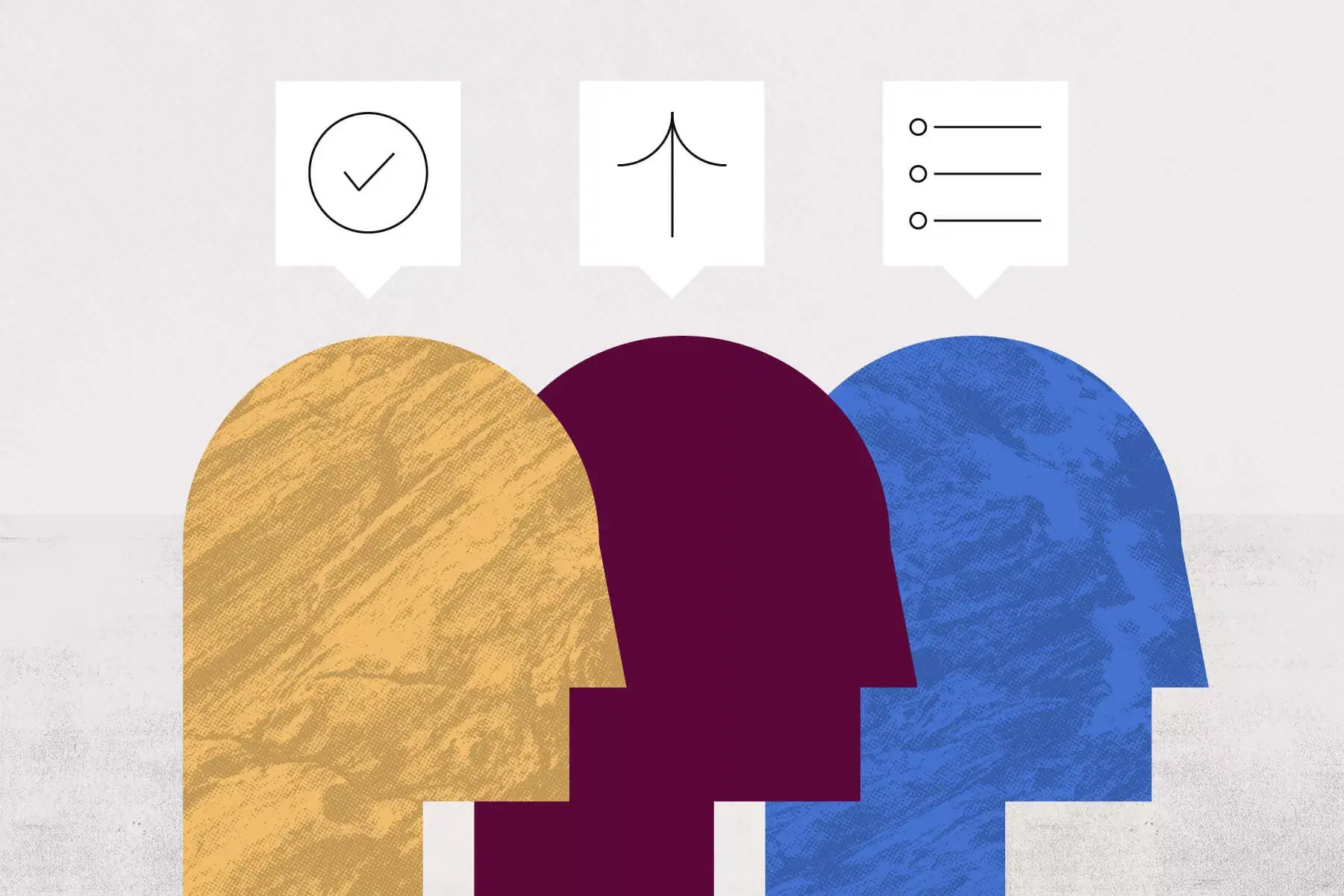
Most brainstorming techniques can be applied to groups of brainstormers, but these specific brainstorming techniques promote (and some even require) participation from everyone. When facilitated well, group brainstorming techniques not only yield more ideas but they can also:
Boost team morale through lighthearted brainstorming games and by involving participation in every step of the brainstorming process
Promote creative thinking, especially when brainstormers are given time to prepare their ideas and a structured approach to solve problems
Bring more diverse ideas together, thanks to the unique perspective each brainstormer has and their individual strengths
All this to say, group brainstorming techniques are all about putting people’s heads together.
19. Eidetic image method
The eidetic image method is grounded in setting intentions, and it begins with group members all closing their eyes to do just that. For example, if a company is setting out to design a new smartwatch, the brainstorming facilitator would encourage all brainstormers to close their eyes and quietly meditate on what smartwatches currently look like.
Then the group would discuss and close their eyes once more and quietly imagine new features to add to the device. They’d all open their eyes and discuss again, essentially layering on the possibilities for enhancing a product. This brainstorming technique is ideal for revamping or building on an existing product or solution.
Best for: visual thinkers, creating an idea anew
20. Rapid ideation
Great for teams that get sidetracked or have difficulty staying focused in meetings, the rapid ideation brainstorming technique encourages brainstormers to race against a clock and come up with as many ideas as possible—and importantly, not take themselves too seriously. This can be done by having brainstormers shout out ideas to a facilitator or write them on a piece of paper. You might find that some of the same ideas keep popping up, which likely means those are worth pursuing.
Best for: extroverted team members, tight deadlines
21. Round-robin brainstorming
Participation is required for the round-robin brainstorming technique. Everyone must contribute at least one idea before the entire group can give feedback or share a second idea.
Given the requirement that everyone must share an idea, it’s best to allow brainstormers time to prepare ideas before each round-robin brainstorming session. This brainstorming technique is great for introverted team members and also for larger groups to ensure everyone can contribute. Moreover, the round-robin brainstorming technique also promotes the notion that the only bad idea is no idea.
Best for: introverted team members and developing a surplus of ideas
22. Step-ladder brainstorming
Ideal for medium-sized groups of five to 15 people, the step-ladder brainstorming technique prevents ideas from being influenced by the loudest brainstormers of a group.
Here’s how it works: A brainstorming facilitator introduces a topic to their group of brainstormers and then dismisses all but two brainstormers from the room. The two brainstormers left in the room discuss their ideas for a few minutes and then one brainstormer is welcomed back into the room and shares their ideas before the original two brainstormers divulge their ideas.
Brainstormers are added back into the room one by one, with each new brainstormer sharing their ideas before the rest of the group divulges theirs, and so forth. Once the entire brainstorming group is back in the room, it’s time to discuss the ideas they’ve built together, step by step.
Best for: introverted team members, vetting ideas thoroughly, honing in on an executable solution
23. Charrette
You might want to book a few rooms for this one. The charette brainstorming technique helps break up a problem into smaller chunks and also breaks up your brainstormers into separate teams to address them.
For instance, you might reserve three rooms, write a topic or problem on a whiteboard, and have three sets of brainstormers walk into those rooms to jot down their ideas. Then, the sets of brainstormers rotate rooms and build off of the ideas of the group that was there before them. Consider it effective teamwork at its best.
Best for: vetting ideas thoroughly, honing in on an executable solution
More brainstorming techniques
For more unconventional approaches to get your individual or your team’s wheels turning, consider adding some of these brainstorming techniques to your arsenal of ways to ideate.
24. ‘What if’ brainstorming
A very off-the-cuff brainstorming technique, “what if” brainstorming is as simple as throwing out as many “what if” questions surrounding a topic as possible, similar to the rapid ideation brainstorming technique. For instance, “what if this problem occurred in a different country,” or, “what if this problem occurred in the 1800s?”
Walking through the scenarios might help spur new obstacles pertaining to your problem. Essentially, the “what if” brainstorming technique helps your team evaluate all the possibilities.
Best for: individual and group brainstorms, creating an idea anew, vetting ideas thoroughly
25. Change of scenery
It’s no secret that physical surroundings can impact your team workflow and even creativity. When your brainstorming session is in a rut, consider relocating to another location, perhaps a park, a walking meeting, or even a coffee shop.
Being in a new setting might spur new ideas and even loosen up your brainstormers so that they’re more open to sharing ideas and helping you achieve quantity over quality.
Best for: individual and group brainstorms, creating an idea anew
26. Random word picker
As this name implies, this brainstorming technique is a little random. Begin by tossing words into a hat and then pull them out and discuss how they relate to your brainstorming topic at hand. You may want to use a template to keep track of your thoughts and any new ideas the word association sparks.
To further organize your thoughts, consider pairing this brainstorming technique with word banking, meaning categorizing random words together and then drawing associations between their category and the brainstorming topic.
Best for: group brainstorms, creating an idea anew
27. Storyboarding
Turns out, storyboarding isn’t only for television and film. You can also apply this as a brainstorming technique, meaning illustrating or drawing a problem and possible solutions. Consider it another way to put yourself in someone else’s shoes, especially those your solution impacts. It’s also a means to visualize any roadblocks you might experience when executing a solution.
Best for: individual or group brainstorms, problem-solving, vetting ideas thoroughly
28. Wishing
Wishing is as simple as it sounds: You just wish for the solution you want to build. Think: “I wish our company was carbon neutral,” and then think of the possible ways in which you could achieve this, as well as areas that might be impossible to address for this. This will help uncover obstacles you might face and maybe even shed light on what you’re capable of overcoming.
Best for: individual or group brainstorms, creating an idea anew
29. Crazy eights
A short and fun brainstorming technique, crazy eights delivers on quantity by encouraging brainstormers to think quickly using a template that has eight boxes and only eight minutes on the clock to sketch out eight ideas. Once the timer stops, the group discusses their ideas.
For a larger group, consider having each brainstormer narrow in on only three ideas and give them a longer time limit of six minutes to sketch them out in more detail.
Best for: group brainstorms, visual thinkers, developing a surplus of ideas
8 tips for a productive brainstorming session
No matter which brainstorming technique is right for you and your team, consider the following best practices to brainstorm most effectively . Of course, it all begins with the brainstorming facilitator and how they set the tone for the session.
1. Allow time to prep
A brainstorming facilitator isn’t the only one in a brainstorming session who needs time to prepare for a meeting . They also should give brainstormers some context ahead of the session, such as in the form of a meeting agenda , to get in the correct mindset for the brainstorming session.
At least one day is standard but as little as two to 10 minutes is useful. Moreover, brainstorming facilitators should also have a few ideas in their back pocket for any creative ruts that might creep in.
2. Set a clear intention
The more context you can provide brainstormers from the get-go, the more fruitful ideas they can produce. For instance, clearly spell out what types of ideas you’re looking for. Whether it’s quickly executable ones or ones that are entirely pathbreaking, identify specific targets to address.
Additionally, be sure to let brainstormers know of any constraints you or your organization is operating under, including project timelines or budgets, so they’re generating executable ideas.
3. Invite new teammates and ideas
When the same people brainstorm together over and over, they can tend to produce the same ideas over and over. For this reason, consider introducing new people to your brainstorming session to shake up the usual and lend a fresh perspective—and hopefully fresh ideas—to your brainstorming topics. Invitees can be colleagues from different departments, customers or clients for a focus group, or an outside consultant.
4. Promote inclusivity
Every brainstorming session should be considered a safe space to share ideas—even unconventional ones. Remember, the only bad ideas are no ideas, and any idea shared shouldn’t be shot down or judged. In addition, the brainstorm facilitator should ensure every brainstormer is treated equally and given the same amount of time to talk. This might mean setting a timer for each brainstormer to talk and acknowledging those who are dominating conversations. Likewise, every brainstormer should be open and curious to ideas.
5. Think out of the box
Creative thinking begins with not taking ourselves too seriously. Just as you encourage inclusivity, encourage imperfections and out-of-the-box thinking, too. This could include anything from fun team building games to unique icebreaker questions. Hey, even a bevy of silly ideas to build off of is better than no ideas at all. Brainstorming techniques like wishing can encourage team members to open up.
6. Amplify creativity with music
Similar to how a change of scenery can inspire new ideas, even a little background music can promote creativity. Consider putting some on for your brainstorming session, and for the best results ensure it’s:
Instrumental
In a major key
On a fixed tempo and volume
7. Mix and match brainstorming techniques
Just as brainstorming techniques aren’t necessarily one-size-fits-all, they also aren’t all one-type-fits-every-session. Be prepared to pivot your brainstorming technique depending on what your group of brainstormers is most receptive to and also how many ideas you're juggling.
8. Execute your ideas
Coming up with bright ideas is great. But they’re pretty useless unless you effectively execute them. While some brainstorming techniques build the execution process into them, others might require you to follow up with brainstormers using project templates to map out a plan using creative solutions.
Brainstorming is about quantity over quality
When done right, a brainstorming session shouldn’t feel like a chore but rather an opportunity to create something together, especially when your brainstorming technique supports different styles of thinking and expression.
And whether you're operating as an individual or on a team, there’s something uniquely satisfying about seeing your ideas come to fruition. Get the creative ideas flowing, then customize your workflow management tool to turn those ideas into action.
Related resources

How to accomplish big things with long-term goals

Fix these common onboarding challenges to boost productivity

30-60-90 day plan: How to onboard new hires with ease

15 types of employee performance reviews
16 Brainstorming Techniques to Boost Your Writing Skills

Have you ever wondered how writers become famous? Creativity is the key to their success, regardless of the genre in which they write. Many have prosperous careers because of the unconventional approaches they use in their work. Brainstorming, which often combines disparate ideas to reach innovative conclusions, is an important part of the creative process.
This article presents a collection of techniques and strategies to boost your creative thinking. Here you will find step-by-step instructions on how to engage in a brainstorming session. In addition, we’ve provided a list of the top free apps to ensure your success.
❓ What Is Brainstorming?
- 📝 Brainstorming Techniques for Writing
- 👣 Brainstorming Session: 6 Steps
- 📱 Free Apps
Brainstorming is a method used to find a creative solution to a complex problem. The first step in the brainstorming process is to identify the problem. The next is to generate as many ideas as possible, no matter how fantastic or strange, which could provide a solution. Finally, those ideas that offer the most creative way to solve the problem are selected and used.
In the 19th century, the term “brain-storm” was used to refer to a mental disturbance. A century later, in the 1940s, a similar word was coined for a different purpose. Alex Osborn, an advertising executive, developed a system to facilitate the production of ideas. He called it “brainstorming.” Some business executives believed that the term held medical connotations and was potentially offensive. They suggested using different terms, like “cloud bursting” and “thought shower,” but none of them caught on.

Brainstorming is an informal way to arrange a business meeting. It also can be used for personal purposes, especially by creative people. The main goal is to avoid criticizing or rewarding any of the ideas.
How Will Brainstorming Make Me a Better Writer?
Our society has trained our brains so much that thinking outside the box becomes more and more challenging the older we get.
If you are a writer, brainstorming is the best technique you can use in your work. It silences self-criticism and traditional thinking . Use a voice recorder or a pen and piece of paper to keep track of your ideas. Do not judge whether your thoughts are good or bad. Just record the flow of ideas.
There are six stages of writing. You start by generating ideas for your topic. Then, you plan your work, make an outline, and create content ideas. After this step, you usually face writer’s block. This is the most challenging time, but when you overcome it, you can write and finish your project. Brainstorming can help you at each of these stages. Below, you will find 15 techniques to help you along the entire writing process.
Writing is a creative activity, and brainstorming is the perfect tool to help you improve your skills. For this process to become even more productive, apart from following the tips below, we also recommend you to check out our essay database . It’s a perfect place to find information and sources of reference for any paper you’re about to write.
Individual Brainstorming
For many reasons, conventional thinking is viewed as the most productive type of thinking. But for creative jobs, this often proves to be quite wrong. The value of artists, writers, poets, and musicians lies in their uniqueness. It has been proven that individual brainstorming sessions produce more valuable results than group sessions. One explanation might be that when you work by yourself, you’re not afraid of how others will judge your ideas. On your own, you are free and more creative.
Group Brainstorming
The individual approach is more efficient with simple problems and broad ideas. But group brainstorming is perfect when a complex problem is at stake. Sophisticated issues require the input of many different perspectives. For example, during audit planning, a manager’s opinion is only a small part of the brainstorming session. Each employee should have a chance to propose possible solutions.

📝 16 Brainstorming Techniques for Every Stage of Writing
Some topics are so difficult that you could spend hours on end trying to think of something special to write. Complicated philosophical essays can also be challenging. Sometimes, a topic may offer an overwhelming number of ways to complete the assignment, but none seems appropriate. In all of these cases, a good brainstorming session is usually the first stop on your path to success.
We have selected the 16 best techniques to generate ideas at each stage of writing a paper of any length. Fifteen minutes of effort at every stage can save you hours of fruitless thinking.
Stage 1: Generating Topic Ideas
Before you begin writing, you need to identify your topic. This decision will narrow the field of your research. Here are five techniques to help you.
1. Brainwriting
This brainstorming game works well in groups. For instance, your teacher might assign a task to write an essay on internet addiction. Her preference is that no one in the class has the same topic.
- The first person writes down three topic ideas and passes the paper to the next student.
- The second person uses the topics already listed to trigger their own ideas and adds another three.
- This process repeats until all members of the class have added three topics to the list.
- Three to five minutes for each person is enough. You can make several rounds around the group if necessary.
- When you are done, cross out the topics that repeat or don’t apply.
- Share the remaining topics with the members of the brainstorming group.
2. Freewriting
This method offers the best way to avoid censoring ideas .
Have a lot of paper on hand (freewriting can take up a lot of space). Do not think about what to write next, and don’t judge your thoughts as good or bad. The only requirements are:
- Write in sentences and paragraphs.
- Keep on writing. If you don’t have any new ideas, write something like, “I am waiting for an idea, and it will come” as many times as you need before a new idea does come.
This exercise takes about 20 minutes, or you can continue until you feel the topic is ready.
3. Meditation
The general purpose of essay brainstorming is to free your mind from stress and improve its performance. What could combat stress better than meditation ? This technique is known for improving the quality of your sleep, focus, and even academic performance.

It also helps writers find the answers they need. While meditating, they remove distractive thoughts and focus on what matters.
4. The criminal technique
In the words of the wise Pablo Picasso, “Good artists copy. Great artists steal.”
This method is perfect for selecting a title for your writing. Search for about fifteen texts similar to the one you have to write. Analyze the advantages and disadvantages of their titles. Then, combine the good parts into your own original title. Voila!
5. The worst idea challenge
Try this when nothing else has been successful. Write down the worst topic ideas you can think of. You will be surprised, but some of them will not be as bad as you thought in the beginning. Our brain is primed for conventional wisdom and critical thinking, and these are the last things you need when trying to engage in creative activities.
Stage 2: Planning Your Work
Congratulations on coming up with a list of topics that perfectly match your assignment! But now, you have to choose just one. At this stage, you need to plan how and where you will search for information to include in your paper. SWOT analysis is a great tool to help you.
6. SWOT analysis
This technique is traditionally used to evaluate the strong and weak points of a company, but we can also use it to assess ideas for creative purposes. SWOT stands for Strengths, Weaknesses, Opportunities, and Threats. To evaluate the feasibility of your topic, juxtapose its strengths and opportunities with its weaknesses and threats. If the latter outweighs the former, choose another topic.
Stage 3: Outlining
This is often the most hated stage of writing, both among students and copywriters. Still, you’ll be thankful that your outline is so structured and detailed when you proceed to the writing phase. These two techniques can sweeten the pill.
7. Clustering/idea mapping
Draw a picture of all the ideas you have on the chosen subject. This technique is a great way to establish the relationships between problems, their causes, and consequences.
- Put your main idea or the possible thesis statement at the center of the paper.
- Write down related issues and draw connecting lines between them.
- Add problems, hypotheses, and facts that contribute to these issues.
- When you’re done, you will have a detailed diagram to help you develop any argument on your topic.
8. Topic association
Did you play the word association game as a child? This technique will help you generate and structure multiple ideas.
- Use short phrases or single words.
- Start with the topic word in the center.
- Write down sub-topics around it. Their relation should be general-to-specific, not cause-and-effect, like in idea mapping.
- Make another row of sub-sub-topics, and so on.

Stage 4: Generating Content Ideas
When your outline is ready, you need to produce those minor content details that make up a compelling paper. Although all of the above techniques can help create content ideas, here are several brainstorming techniques that offer specific benefits at this stage.
9. Reverse brainstorming
This is a useful tool for essays that need to offer a solution to a problem. In this case, the brainstorming procedure is used in reverse. Think of something that could cause or aggravate the given problem. The worse the consequences, the better! Repeat this step until you have brainstormed a complete disaster. Then, begin to examine how to eliminate those problems.
10. The Five Whys
This technique will bring you to the root of any issue. Think of a problem, ask yourself why it occurred, and write down the answer. Then, identify the cause of the last thing you wrote down. Continue the same sequence five times (or more, if needed).
For example:
- Why did the boat sink? Because the engine failed.
- Why did the engine fail? Because it overheated.
- Why did it overheat? Etc.
11. Role Storming
The method works best in a group, but you can brainstorm on your own for your writing purposes. Put yourself in the shoes of a person whose problem is discussed in your paper. If the topic is child obesity, think about the experiences the affected children and their parents might go through. If it is domestic violence, take on the roles of the victim, offender, and bystander. Empathy helps us see the same situation from different points of view.
12. Figure storming (an excellent idea for a historical project)
Choose a historical or fictional figure whose life, actions, and views are familiar to you. Imagine that you are Albert Einstein , Steve Jobs , or Thomas Edison , and that someone has asked you how to tackle a certain problem. What would you, as a great intellectual, suggest? We often lack clarity and assertiveness. Let these figures (and many more, thanks to our rich history) assist you.
13. Question everything
The name of the technique is self-explanatory, but the following example will make it more accessible. Question every single aspect of the topic you discuss, and you will discover new ideas.

Topic: The pros and cons of online education.
Questions: Are there any pros of online education? What is online education? Who cares about the problems of online education? Is the issue even worthy of consideration?
14. Pros and cons (excellent for argumentative and persuasive texts)
You have probably never noticed it, but you use this method every day. You weigh the value and price of any purchase before paying for it. You consider whether to stay in college or leave when you are offered an exciting job before graduation. Write down the available options (they can be more than two). Then, make a list of their strong and weak points. It will help you decide which argument to adhere to in an argumentative text.
Stage 5: Overcoming Writer’s Block
We all have a fear of a blank page. Even when you have an outline and a list of creative ideas, it can be difficult to begin writing. This is a common problem with perfectionists: they want everything to be perfect from the start. To overcome this block, use freestorming.
15. Freestorming
Freestorming is very similar to freewriting, which was discussed in the section on generating topic ideas. The difference is that with freestorming, you do not need to give yourself an arbitrary time limit. Take as much time as you need and write whatever comes to your mind on the subject. You are not just limited to topic generation now, so you can make the brainstorming experience more relaxed.
Stage 6: Writing
All the techniques above have probably generated so many ideas that you most likely have to choose which ones to include in your text. Another issue you may face now is selecting the right words. For that, the technique below will come in handy.
16. Word banks
To avoid repeating yourself, make a list of five to ten of the most common words in your text. To diversify your writing, find synonyms and use them throughout your paper.
👣 Organize a Great Brainstorming Session in 6 Steps
Brainstorming is the best method to search for a creative or strategic solution. It allows a group of people to accumulate a great number of ideas in a short time. But without proper organization, this opportunity for teamwork can be controlled by a few leaders, while the rest keep quiet. To make it a fair game that benefits each member, everyone should know and adhere to the rules.

Step 1: Demonstrate the Specific Problem
The person who organizes the session should make sure that all the participants have a clear understanding of the task. For example, it could be finding a solution to a problem, coming up with a new product or campaign, improving an existing solution, or defining new directions of research.
The following procedure will help you avoid any unwanted issues:
- State a clear, short question that embodies the entire problem.
- Establish boundaries for brainstorming ideas. These limitations will make the session more productive. For example: When does the research project need to be completed? What is the maximum amount of money that can be invested in the new product?
- Try to keep the limits to a minimum so that you can have a broader range of solutions.
Step 2: Establish the Context and Definitions
When a business project or research project involves a large group of people, knowledge distribution tends to be uneven, and the leaders usually know more than the rest. Everyone will benefit if this gap is decreased. These questions will help you equalize the knowledge between all the members:
- What do the participants know about the context?
- What else do they need to know to be productive thinkers?
- What are the key terms everyone should understand in the same way?
Step 3: Choose a Facilitator
It is important that each participant knows the main rule: there is no room for criticism or skepticism. The participants must give free rein to their imagination. They need to pick up each other’s ideas and develop them, supplementing them with their own insights. The facilitator is the one who keeps an eye on these “formalities:”
- They make sure everyone makes a contribution.
- They prevent anyone from dominating the session.
- They keep the participants focused.
- They do not generate ideas but combine them to keep the session moving.
Step 4: Collect the Right People
Be aware that the presence of some people can be detrimental to the session. Effective brainstorming needs people who are equally invested in the problem question. These rules can save your session from a disaster:
- Select three to eight people.
- Make sure some of them are experts. They will check every idea for viability.
- The other part of the group should be non-experts (i.e., workers or researchers from a neighboring domain). Experts are limited by their knowledge, and it is harder for them to think outside the box. Non-experts will ask silly questions entailing unconventional thinking.
- Try to select members from different backgrounds, age groups, and cultures. Diversity is your purpose!
Step 5: Plan the Session
It is helpful to prepare this point in a group handout. We suggest the following schedule:
- 20 minutes to set out the problem, its limitations, context, and definitions;
- 30 minutes for generating the options and new ideas;
- 20 minutes for sorting and discussing the brainstorming results; and
- 10 minutes to wrap up the session.
Step 6: Carry out the Session
There are multiple exercises, games, and techniques for successful brainstorming. Many of them were given above. But if you want to make it quick and simple, this procedure will do:
- The facilitator provides sticky notes to each member.
- They write down their ideas.
- These papers are put together in a place visible to everyone (a table or whiteboard).
- The facilitator groups them into several categories.
- Any new ideas are welcome on extra notes.
- The members vote for the best ideas and put them aside.
- Special attention should be given to the most innovative solutions.
- The facilitator summarizes the results and ends the session.
📱 Top 10 Free Brainstorming Apps
It is the XIX century, and brainstorming sessions can be held across continents. Moreover, free software can help you arrange new ideas and merge or compare them. If you are wondering how to innovate in groups or on your own, these apps can make you an expert brainstormer.
Brainstorming is a beautiful process in which a group of people with different experiences, views, and expertise unite to create something new. We hope that our advice and tips will enhance your creativity as a writer and a team player. If you have been a member or facilitator in a brainstorming group, share your know-how in the comments below.
- Share via Facebook
- Share via Twitter
- Share via LinkedIn
- Share via email
Writing Studio
Invention (aka brainstorming), what is “invention”.
In an effort to make our handouts more accessible, we have begun converting our PDF handouts to web pages. Download this page as a PDF: Invention Return to Writing Studio Handouts
Invention (also referred to as brainstorming) is the stage of the writing process during which writers discover the ideas upon which their essays will focus. During this stage, writers tend to overcome some of the anxiety they might have about writing a paper, and in many cases, actually become excited about it. Although invention usually occurs at the beginning of the writing process, exercises aimed at facilitating invention can be helpful at many stages of writing. Some of the best writers return to this stage a number of times while composing drafts of their essays.
Recommended Invention Techniques
Freewriting.
Read through your assignment and choose a topic, theme, or question that comes to mind. Write for 10-15 minutes in response to this idea – do not lift your pen from the paper or your hands from the keyboard.
When you are finished, read through your draft and underline or circle ideas that might lead you to a thesis for your paper. Consider asking a classmate or friend to read what you’ve written and ask questions about your ideas and topics.
After freewriting, read through what you have written and underline a phrase or sentence that you think is particularly effective or that expresses your ideas most clearly. Write this at the top of a new sheet of paper and use it to guide a new freewrite.
Repeat this process several times. The more you write and select, the more you will be able to refine your ideas.
Talk to Yourself
Some people often find themselves saying, “I know what I want to say. It’s just that I can’t figure out how to put it in writing.” If this is the case for you, try dictating your thoughts on a digital recording device. After several minutes, listen to what you’ve recorded and write down ideas you want to incorporate into your paper.
If you don’t have a recording device, ask a friend to write down some of the main points you make as you talk about your ideas.
List all the ideas you can think of that are connected to the topic or the subject you want to explore. Consider any idea or observation as valid and worthy of listing (go for quantity at this point). List quickly and then set your list aside for a few minutes. Come back and read your list and then do the listing exercise again.
Using Charts or Shapes
Use phrases or words that are central to your topic and try to arrange them spatially in a graph, grid, table, or chart. How do the different spatial representations help you see the relationships among your ideas? If you can’t imagine the shape of a chart at first, just put the words on a page and draw lines between or around them.
Break Down the Assignment
Sometimes prompts are so complicated that they can seem overwhelming. Students often ask: There’s so much to do, where should I start? Try to break the assignment down into its constituent parts:
- The general topic, like “The relationship between tropical fruits and colonial powers.”
- A specific subtopic or required question, like “How did the availability of multiple tropical fruits influence competition among colonial powers trading from the larger Caribbean islands during the 19th century?”
- A single term or phrase that seems to repeat in the material you’ve read or the ideas you’ve been considering. For example, if have you seen the words “increased competition” several times in the class materials you’ve been reading about tropical fruit exports, you could brainstorm variations on the phrase within the context of those readings or focus on variations of each component of the phrase (i.e., “increased” and “competition”).
Once you have identified the major parts of the topic, try to figure out what you are being asked to think about in the assignment. What questions are you expected to answer? Are there related questions that need to be addressed in order to answer the primary questions? If so, what are they?
Defining Terms
In your own words, write definitions for key terms or concepts given in the assignment. Find other definitions of those terms in your course readings, the dictionary, or through conversations and then compare the definitions to your own. Keep these definitions in mind as you begin to write your essay.
Summarizing Positions
Summarize the positions of relevant authors from your course readings or research. Do you agree or disagree with their ideas, methods, or approaches? How do your interests overlap with the positions of the authors in question? Try to be brief in your descriptions. Write a paragraph or up to a page describing a reading or a position.
Get together with a group of classmates and have each person write down her or his tentative topic or thesis at the top of a blank sheet of paper. Pass the sheets around from left to right so that each person can write down a thoughtful question or suggest related ideas to think about.
Compare / Contrast Matrix
If your assignment asks you to compare or contrast two concepts, texts, subjects, etc., try to organize your thoughts in a compare/contrast matrix by focusing on the attributes you will consider in your draft. These attributes should establish the key points of comparison or contrast with which you will deal in your essay.
Last revised: 07/2008 | Adapted for web delivery: 05/2021
In order to access certain content on this page, you may need to download Adobe Acrobat Reader or an equivalent PDF viewer software.
Florida State University
FSU | Writing Resources
Writing Resources
The English Department
Brainstorming
What is brainstorming.
Brainstorming is the act of using certain methods to understand and improve your writing. From choosing a topic, developing an argument, outlining a paper, or working with a revision, brainstorming can help with any stage in the writing process.
How to Start Brainstorming
There are many techniques to choose from if you’re looking to brainstorm with your writing.
Here are some suggested methods:
Freewriting
Freewriting is a session, often timed, of writing through stream of consciousness. You can choose to freewrite about a larger topic/question or specific topic/question related to your project. When freewriting, don’t stop to think about what you have written until after the time is up. If you can’t think about what to write next, write whatever comes to mind, even if it seemingly has no correlation to your topic.
Step 1: Choose an amount of time to set your freewriting session. We recommend 3,5, or 7 minutes.
Example: I’m setting my freewriting time to 3 minutes!
Step 2: Choose a topic or question to base your freewrite on.
Example: I will freewrite about the topic for my paper: “A History of Florida Oranges”
Step 3: For your chosen time, write about whatever comes to your mind when thinking about the topic. Don’t Stop! Don’t worry about proper punctuation, spelling, or grammar, just keep writing!
Example: A History of Florida Oranges, I live in Florida I love oranges I wonder how many oranges florida produces where are the orange plantations in florida right now have they always been there in the past? Did they start growing in florida I don’t know what else to talk about I wonder if other countries like how floridas oranges taste how did florida become well known for their oranges and what sets it apart from other oranges in different states is it the climate it is always hot in florida but it makes orange juice taste so much better I am writing about oranges what can oranges be used for has there ever been no oranges in florida like a drought that would suck I hope it doesn’t happen while im around how many oranges does florida make in a year…
Step 4: Now look at what you’ve written. It may look weird right now, but take some time to pick apart key details that relate to your topic, and put them together.
Example: Florida orange production (How much? To where?), plantation history (How long have they been there? How much have they produced?), Have oranges always grown in Florida?, What sets Florida oranges apart from others?, How did oranges become a Florida staple?
In this freewriting example, specific questions about the topic can be picked apart and used as a basis for beginning research or expanding on the topic.
Listing is a brainstorming technique that can help a writer get a better understanding of their topic, expand on certain parts of their thesis, or even aid in choosing a topic to begin with.
Step 1: Listing can start whether you already have a topic in mind, or no topic at all when it comes to the main idea.
Example: I need to write a paper on one of the major conflicts of literature found in Homer’s The Odyssey , but I don’t know what to choose!
Step 2: Start by listing out 4-5 topics under the main idea (or if you have a topic in mind already, write about aspects of that topic).
- Person vs Person
- Person vs Nature
- Person vs Self
- Person vs Society
Step 3: Of those, select 3 that you like the most, and write about them using bullet points or paragraphs. Get detailed and do some research if you can.
Example of one of the topics: Person vs Self:
- Odysseus’ pride and ego
- Odysseus’ struggle with temptation
- Odysseus’ perseverance and determination
At the end of the writing session, you’ll be able to see which topic or aspect had the most ideas, and from there you can formulate what your research could be about.
Mind Mapping
Mind Mapping is a type of brainstorming activity that can help with picking out a general topic or argument or expand on the details for the paper.
Step 1: Get a piece of paper. Put one element in the center of the page. This could be the topic or topic question of your paper, part or all of your argument, or any detail you intend to go in depth on.

Step 2: Create a web of associations around the element. They can represent broadly related ideas or categories.

Step 3: Each main branch can have smaller subcategories or questions.

Your Mind Map can give you an idea of where you can start your research or what else you could include on your paper. No matter how detailed Mind Maps can get, the points will be able to relate back to the main element.
Revision Brainstorming
It’s never too late to brainstorm! Even in revision stages of your project, you can brainstorm ways to make it even better.
Here are some suggested methods:
Post/Reverse Outline
In this brainstorming method, you use what you’ve already written, and break down what parts could use revision.
Step 1: Read through your paper again. Write down the main idea of each paragraph either on a different piece of paper or in the margins.
Step 2: Now analyze the content of your paper after you outline. Ask yourself questions like: Did I dedicate too much space on one topic? Did I write too little about other ideas? Does the order of ideas make sense? Did I leave out any important ideas or get off track?
Step 3: Move things around: Add on to your paper or cut irrelevant information out.
By the time you finish this brainstorming method, you should have a good roadmap to follow as you revise your work.
Visual Brainstorming
Visual Brainstorming are methods used to see your paper from different perspectives. These mostly involve the process of revising structure or the way ideas on the page are organized.
Step 1: Write on post-it notes or cut up a physical copy of your paper based on sections such as main claim, ideas or sub-sections. You can cut/write based on paragraphs or even single sentences.
Step 2: Now rearrange and reorganize them.
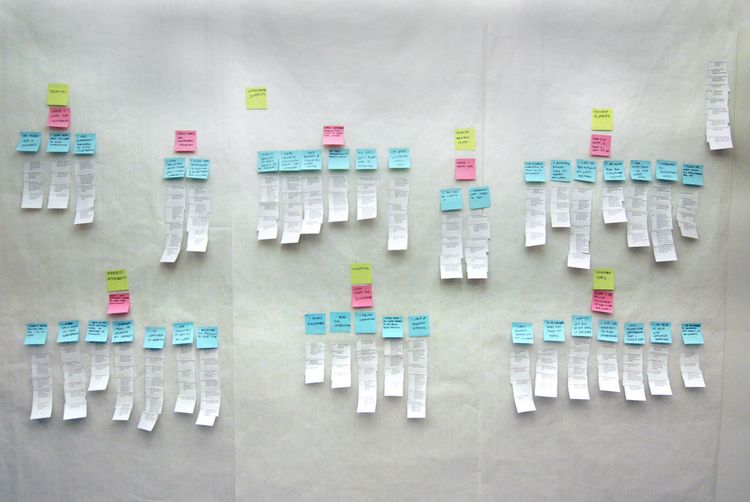
When you have an order you like, focus on your topic sentences and transitions to guide your reader through your paper.
Back To Tools
Works Consulted
UNC Writing Center
Florida State University Writing Center Resources
Stay in Touch
[email protected] , @fsurwc | @fsurwc .
What is brainstorming?
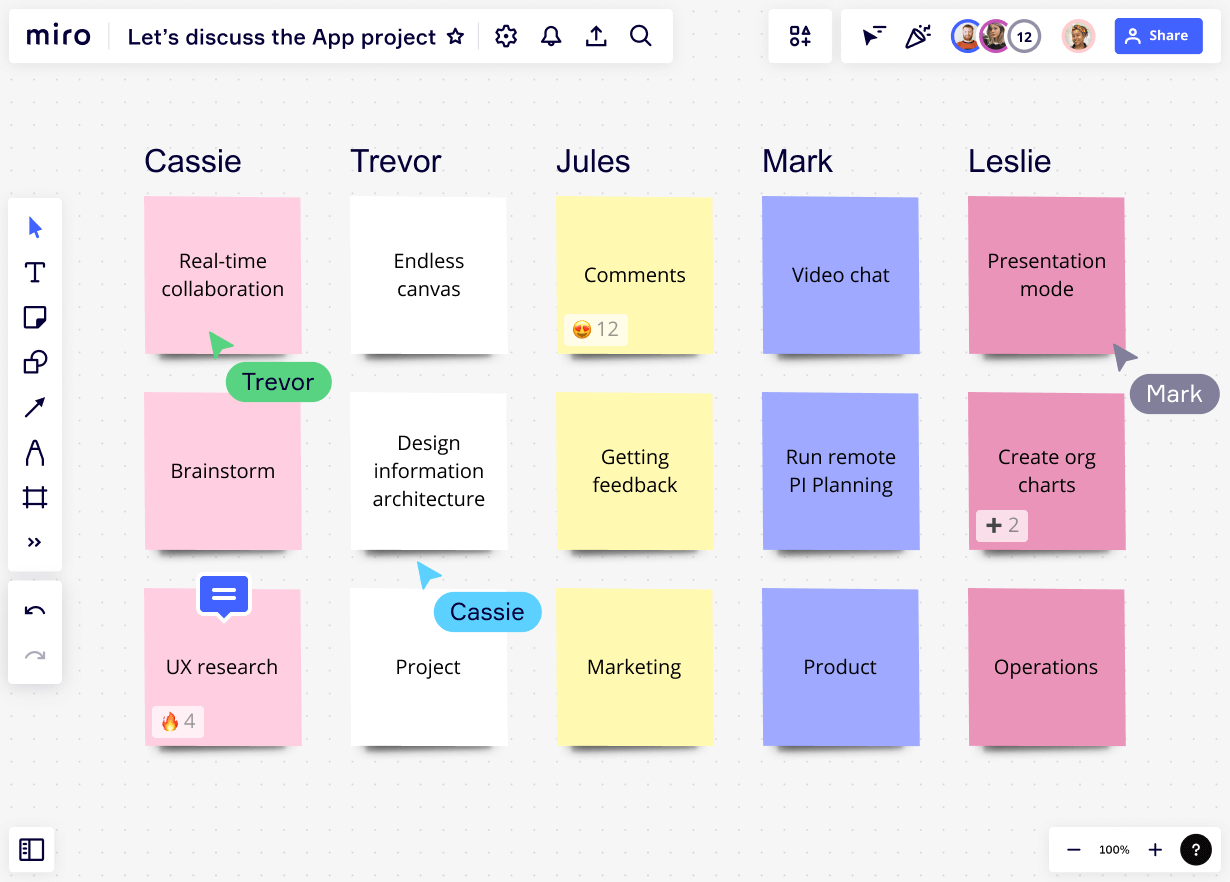
Table of contents
Definition of brainstorming.
Brainstorming is a creative thinking technique for coming up with new ideas and solving problems. Teams use this ideation method to encourage new ways of thinking and collectively generate solutions. Brainstorming encourages free thinking and allows for all ideas to be voiced without judgment, fostering an open and innovative environment. This process typically involves a group of people, although it can be done individually as well.
This guide will help you get the most out of every creative session. When you're ready to start your next free thinking exercise, jump into Miro’s brainstorming tool to generate ideas and turn them into action.
What is the main purpose of brainstorming?
The primary purpose of a brainstorming session is to generate and document many ideas, no matter how “out there” they might seem. Through this lateral thinking process, inventive ideas are suggested, which sparks creative solutions. By encouraging everyone to think more freely and not be afraid to share their ideas, teams can build on each other’s thoughts to find the best possible solution to a problem. Brainstorming usually takes place in a group setting where people get together to creatively solve problems and come up with ideas. However, it’s also useful for individuals who need to explore novel solutions to a problem. Sitting down by yourself and writing down solutions to potential problems is a great way to brainstorm individually. Focusing your mind on a defined problem allows you to think of many creative ways to get to an answer. While brainstorming normally allows for free-form methods of thinking and doesn’t require many rules, the best results usually stem from controlled sessions. Posing questions and role-playing different scenarios during the brainstorming session is a smart way to pull out unusual ideas and never-before-thought-of solutions.

Benefits of brainstorming
Why is brainstorming such a popular approach to solving problems and generating ideas? Here are some of its many advantages:
Encourages creativity
Brainstorming sessions are meant to be free of judgment. Everyone involved is meant to feel safe and confident enough to speak their minds. There will be some good and some bad ideas, but this doesn’t matter as long as the final outcome is one that can solve the problem. This kind of free-thinking environment, along with a few essential brainstorming rules, encourage creativity in the workplace.
Fosters collaboration and team building
Brainstorming is not only good for problem-solving. It also allows employees and team members to understand how the people around them think. It helps the team get to know each other’s strengths and weaknesses and helps build a more inclusive and close-knit workforce.
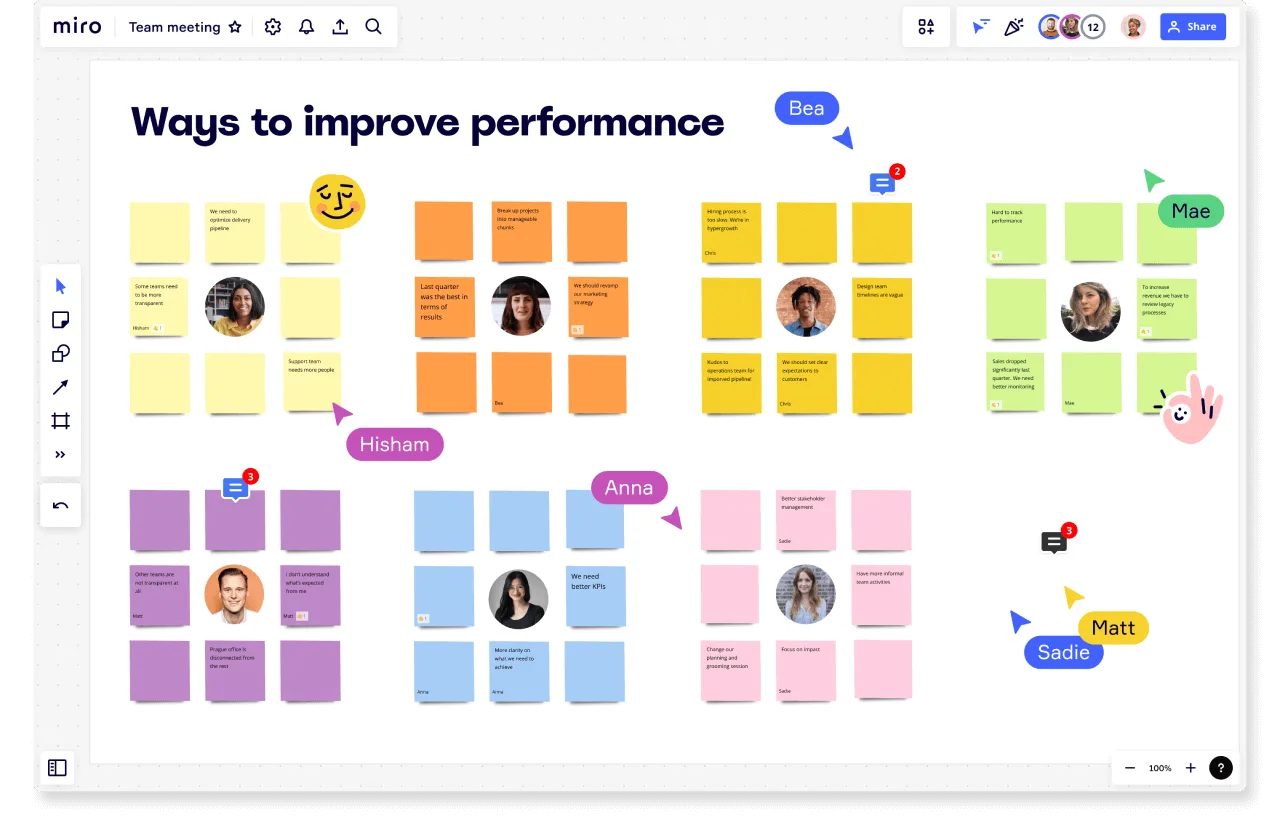
Generates innovative, revolutionary ideas
Brainstorming is the perfect mix between a free-thinking, creative environment and one that is governed by rules. Being faced with a defined problem or asking questions like “What do we do in X scenario?” forces everyone in the room to come up with ideas and solutions. No two people think alike. So, combining the good parts of everyone’s answers will result in holistic and revolutionary solutions.
Establishes different perspectives
One of the major benefits of brainstorming is that it allows and encourages all members of the session to freely propose ideas. This type of environment fosters courage in people who may not usually offer their perspective on a problem. Garnering a range of different perspectives can lead to a never-before-thought-of solution.
Introduces many ideas quickly
The beauty of brainstorming is that it encourages teams to come up with many ideas in a relatively short period of time. Ideas are thrown around, and every train of thought is documented. Different perspectives give different answers, and sifting through a few good answers in quick succession may lead to the perfect solution in no time.
Types of brainstorming techniques
There are plenty of creative brainstorming techniques to choose from. Here are some of the most popular ones:
Reverse brainstorming
In a typical brainstorming session, the group is asked to consider solutions to a problem. This means that they will spend time thinking about the outcome — the end goal — rather than the root of the problem — the starting point. Reverse brainstorming is simply the opposite: teams are asked to ideate on the problem instead of the solution. This type of brainstorming is done before the start of an important project, as it helps teams anticipate any future obstacles that might arise. To help frame this way of thinking, use a Reverse Brainstorming Template to get the team started.
Random word brainstorming
One of the main goals of a brainstorming session is to come up with new ideas. One of the best ways to do this is to say the first words that come to mind when a specific topic or subject is mentioned. Random word brainstorming allows for exactly that. The team is given a problem, and they need to shout out the first words that they think of, regardless of what they are. These words are then written down and later put into interesting combinations to see if they will lead to a usable solution. This brainstorming method is extremely fast and usually very efficient at solving a defined problem. The Random Words Brainstorming Template can help get you started.
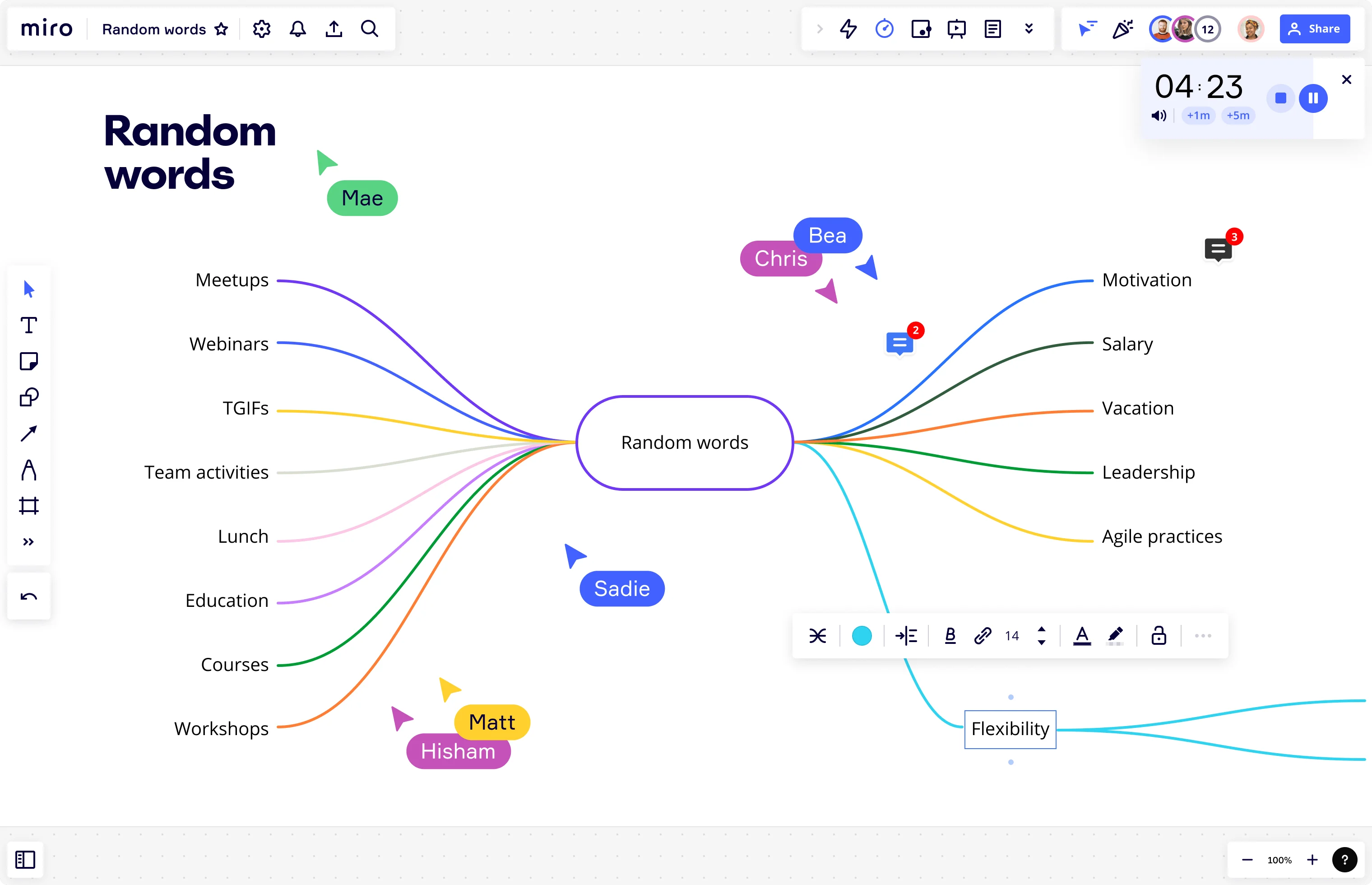
The 5 Whys Method
Like the reverse brainstorming method, the 5 Whys method aims to look at the root causes of a problem to stop that same issue from arising again. This method attempts to curb the problem before it can reoccur by asking the question “why?” over and over until it can no longer be answered. Once you reach this stage, you have arrived at the root cause of the issue.
SCAMPER model
Developed by Bob Earle, an author of creativity books for kids, the SCAMPER model was originally a game aimed at imagination development in adolescents. It has, however, become popular in the corporate world as a means of improving and encouraging creativity in team members when dealing with complex, defined problems. Using this model, your team will view a problem through 7 filters: substitute, combine, adapt, modify, put to another use, eliminate, and reverse.
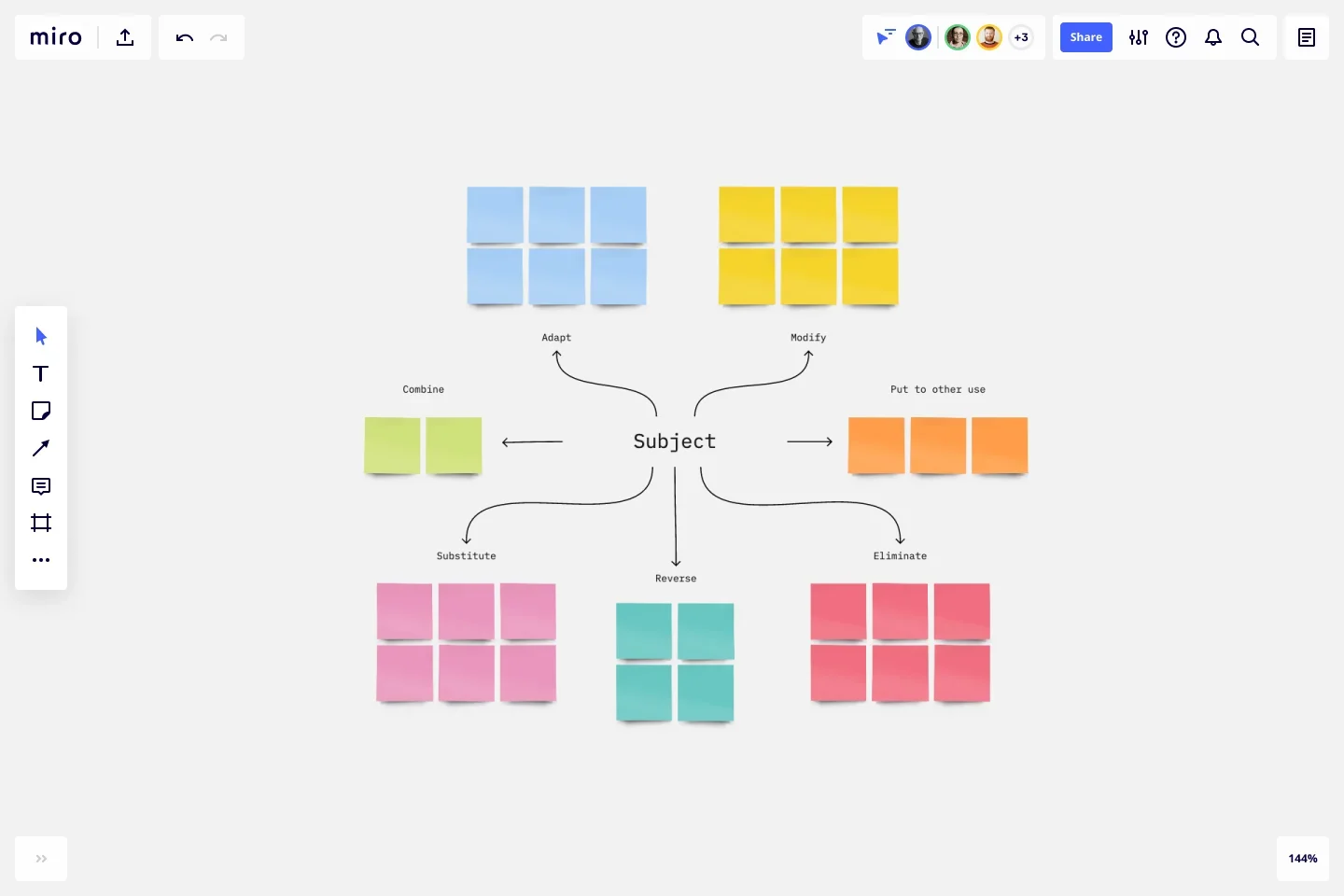
Rapid ideation
Rapid ideation brainstorming is almost the exact same thinking model as random word brainstorming. In this method, however, everyone writes down the solutions they are thinking of instead of shouting them out. This gives participants a bit more privacy with their immediate thoughts — possibly leading to even more creative and revolutionary outcomes.
Starbursting
Once again, brainstorming can change based on the team’s perspective and each session’s expected outcome. Starburst brainstorming focuses on getting the team to ask questions instead of coming up with answers.
How to hold a brainstorming workshop
Ready to harness the power of a well-run brainstorming session? Here’s a step-by-step guide on how to organize a successful brainstorming workshop:
1. Assign a facilitator
When done as a group, a brainstorming session needs to have boundaries. You need to choose someone who will facilitate the session and provide guidelines for the thinking exercises that the group will partake in. This is so the session doesn’t get too scattered and stays on the right track. The facilitator should pose questions and guide the group from start to finish.
2. Establish context and ensure group understanding
A brainstorming session cannot be properly carried out without context. The group must understand why they are meeting and what the end goal of the session is. Everyone should also understand the meaning of brainstorming and what to expect from the brainstorming process. The brainstorming method that will be used should also be established (see point 5) and explained at the outset.
3. Define an objective
While brainstorming is often looked at as a form of free-thinking creativity, it is best to try to stay within certain rules. It’s essential that you define a clear objective and use the session to reach your predetermined goal.
4. Set a time limit
Setting a defined time limit before the session starts is important to the success of your brainstorming session. No doubt your team could come up with countless ideas, but there has to be a limit on how long the session can run. Knowing that you need to solve a problem within one hour, for instance, will help the team focus on the job at hand and come up with ideas faster. It will also keep everyone thinking about the same problem.
5. Decide on the brainstorming technique
The brainstorming technique that will be used must be decided on before the session begins. The best way to do this is to look at the problem at hand. If you’re looking to prevent obstacles from arising in the future, try the “5 Whys” technique. If you’re looking to come up with new marketing ideas or get creative with workplace conflicts, try the rapid ideation technique.
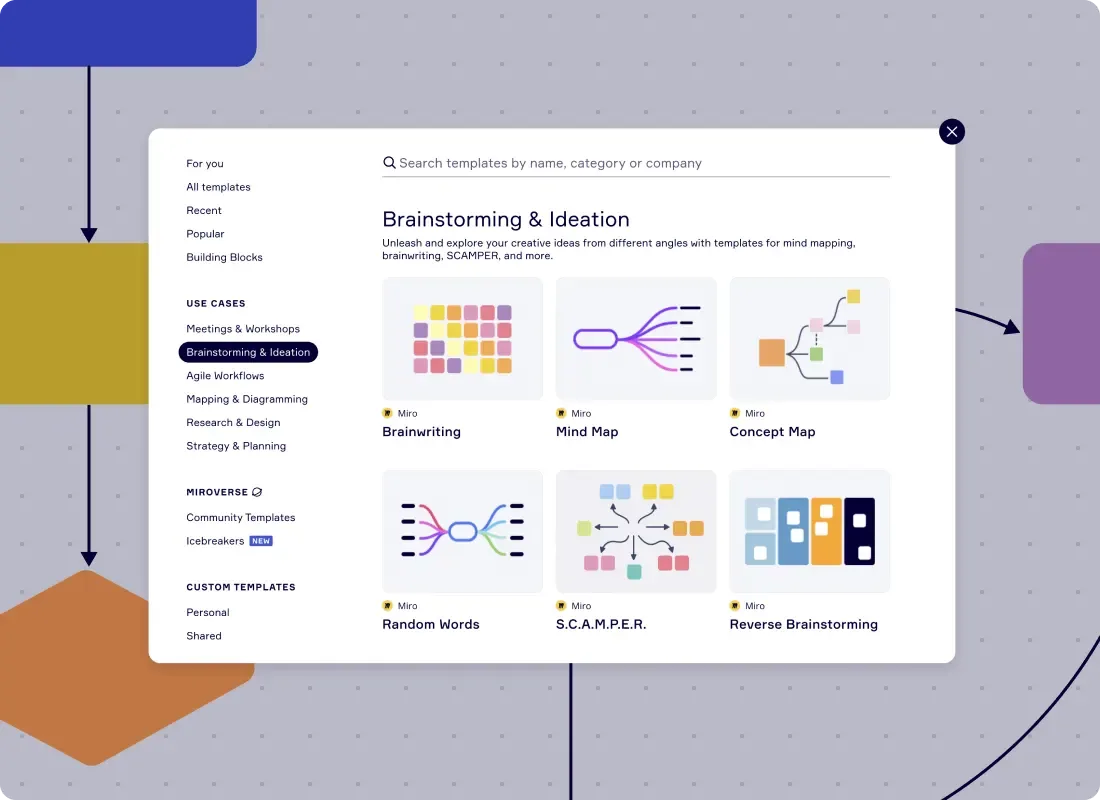
6. Set some ground rules
As stated above, the best and most productive brainstorming sessions are those that allow for free thinking and creativity within preset boundaries. Brainstorming ground rules are essential to to the success of the session, as they keep everyone focused on the topic at hand and ensure that no one goes off track.
7. Capture all ideas
The entire point of a brainstorming session is to come up with as many ideas as possible, regardless of whether the standalone suggestion will lead to success. This means that you need to use the right tools to document the ideas being suggested. Miro has a host of idea-capturing tools, including a simple-to-use visual platform for remote brainstorming sessions and digital sticky notes .
8. Discuss and vote on ideas
After all the ideas have been captured, it’s time to discuss them. The team needs to be productive in choosing a creative idea that suits the problem, or they can try combining a few ideas to come up with a holistic solution. To make decisions as a group and come to an agreement, teams can use the dot voting method . This technique reveals group priorities and helps everyone reach a consensus on the direction to take.
9. Turn ideas into action
Once the final idea has been chosen, it’s time to create a plan of action and a deadline for the idea to be put in place. Transform your ideas into detailed, tangible steps with the Action Plan Template . This will help with coordination between team members and ensures that nothing is missed.
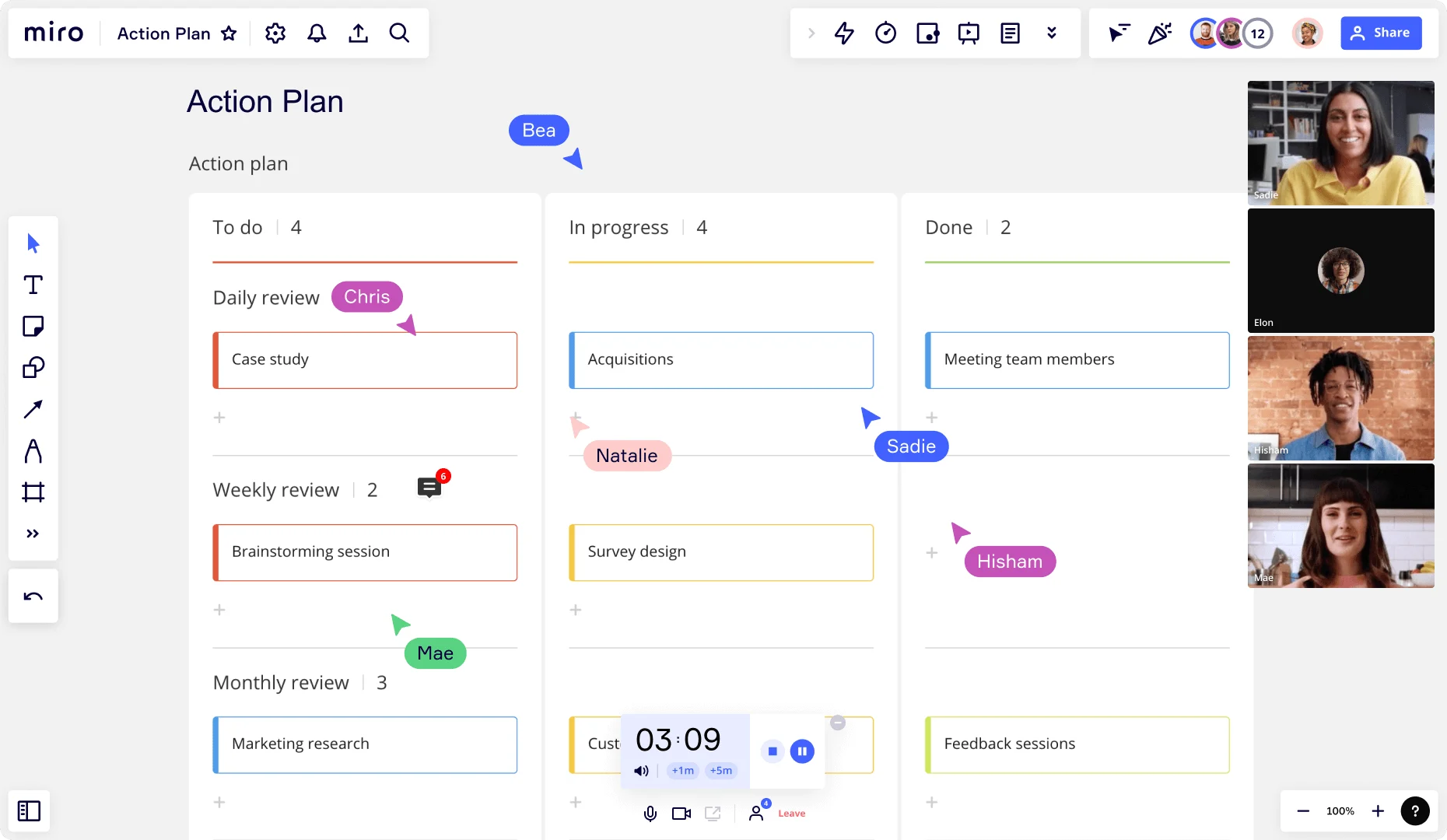
Tips for your brainstorming activities
While all brainstorming sessions look a little different, here are some best practices to get the most out of yours:
Record all ideas
If you want to have a successful and productive brainstorming session, it’s important that you capture every idea suggested, good and bad. An idea might seem silly when first brought up, but it might become an invaluable idea as the session moves on. Capture everything, and right at the end, work out which ideas best suit the problem.
Ensure that everyone’s ideas are heard
When brainstorming is done as a group activity, everyone needs to feel comfortable and confident to propose ideas. The best way to make sure the environment fosters these feelings is to make the session feel like a conversation, not a presentation. Create a safe and open environment that gives everyone equal opportunity to voice their opinions and ideas.
Focus on quantity
People often like to say, "Focus on quality, not quantity," but it’s the opposite when brainstorming. In a brainstorming session, you should focus on getting as many ideas on the board as possible, even if they're only one-word ideas. These can all be used to come to a holistic solution at the end of the session. Each suggestion could be invaluable if you're coming up with a combined idea.
Brainstorming should be a fun and creative endeavor. You shouldn’t be too rigid — though some ground rules are important. If your team has weekly brainstorming sessions, try new brainstorming techniques and activities each time you meet. This will keep your team members on their toes and help make them excited about the next meeting. It will also encourage out-of-the-box thinking, which is essential to any successful brainstorming session.
Avoid criticism
We’ll say it again: there are no bad ideas in a brainstorming session. This is the attitude that all team members must adopt when entering the session. No one should be criticized for the ideas that they propose. The best way to foster an environment that is devoid of criticism and encourages creativity is to maintain a relaxed approach. This will make everyone feel comfortable and happy to contribute their ideas.
Discover more
Guide to collaborative brainstorming
When to use brainstorming (and which techniques are best)
What is brainwriting?
What is reverse brainstorming?
How to conduct a brainstorming session
Get on board in seconds
Join thousands of teams using Miro to do their best work yet.

The Writing Process
Making expository writing less stressful, more efficient, and more enlightening, search form, you are here.
- Step 1: Generate Ideas
Brainstorming

"It is better to have enough ideas for some of them to be wrong, than to always be right by having no ideas at all." —Edward de Bono
Most people have been taught how to brainstorm, but review these instructions to make sure you understand all aspects of it.

- Don't write in complete sentences, just words and phrases, and don't worry about grammar or even spelling;
- Again, do NOT judge or skip any idea, no matter how silly or crazy it may initially seem; you can decide later which ones are useful and which are not, but if you judge now, you may miss a great idea or connection;
- Do this for 15, 20, or (if you're on a roll) even 30 minutes--basically until you think you have enough material to start organizing or, if needed, doing research.
Below is a sample brainstorm for an argument/research paper on the need for a defense shield around the earth:

Photo: "Brainstorm" ©2007 Jonathan Aguila
Brainstorming Techniques: 15 Creative Activities to Do Solo or as a Team
Updated: August 15, 2022
Published: August 20, 2021
We're all familiar with traditional brainstorming as a way to produce new ideas. You sit in a room with a whiteboard and work with whatever comes to mind. Maybe you play a few rounds of word association to strengthen your ideas, or pull up Google and use research to flesh them out.

But there are many alternative exercises for tackling problems and developing new ideas, both individually and in a group setting.
Ranging from structured to silly, here are the best creative brainstorming exercises and techniques to help you get your problem-solving juices flowing. This list is a modified excerpt from my guide Creative Ideation for Digital Marketers: Theory to Practice .
![writing brainstorming activities Download Now: Complete Guide to Collaborating at Work [Free Guide + Templates]](https://no-cache.hubspot.com/cta/default/53/7b7e92ee-1d6f-46e1-a984-3c0aa19eb448.png)
Brainstorming Techniques
- Storyboarding
- Mind Mapping
- Word Banking
- S.C.A.M.P.E.R.
- S.W.O.T. Analysis
- Reverse Brainstorming
1. Storyboarding

If you're trying to design a process, storyboarding can help you see where your collective understanding of a problem supports or conflicts with a proposed solution, and where more thought/research is needed. By developing a visual story to explore the problem as a narrative, your team will be able to see how ideas interact and connect to form a solution.
Sticky notes are your friend. Take a few minutes to write out your ideas as individual notes. These don't have to be complete thoughts — physically pinning up quotes, pictures, user info, and the like can help you see new relationships between different components.
Once you have a group of sticky notes to work from, start arranging them on the board as a progression: first this, then that. Organizing your ideas as a continuous series will help you see new connections and eliminate extraneous material that doesn't support your end goal.
Why This Brainstorming Technique Works
- Storyboarding allows you to see your ideas in a sequential pattern.
- You’ll be able to see an overarching overview of a new or current process — without digging too deeply into the details.
- You can start from anywhere — the beginning, middle, or end — then fill in the blanks.
How to Use It in Marketing
Storyboarding is particularly useful for marketers. With it, you can:
- Outline the sequential process of a marketing campaign from beginning to completion.
- Improve an internal process such as backlink-building by drafting specific steps.
- Storyboard a marketing video from beginning to end.
2. Mind Mapping
Mind mapping is a fairly common term nowadays — in fact, many types of software provide automated mind-mapping templates so you can better organize your data. Well, it also happens to be a great way to organize your ideas.
- To create a mind map for creativity purposes, write down the task or problem you're trying to solve at the center of your idea sheet (feel free to do this on your computer, but whiteboards are ideal).
- Then, expand on this problem by surrounding it with terms that better describe what you need. If your problem is low website traffic, for example, some terms to write around this phrase might be "organic traffic," "trusted content," "SEO," and "video strategy."
- Once your mind map has this first layer, add a second layer to each of your needs describing how you might be able to solve for these individual challenges. Around "SEO," you might write " topic clusters ," "dedicated SEO strategist," and "video marketing course."
Keep adding to your mind map using the steps above until you've sufficiently broken down your problem into manageable parts. It's a fantastic problem-solving technique that fosters creative answers to subjects that might otherwise seem uninspiring.
- Mind mapping allows you to start from any point and create clusters of potential processes.
- You don’t need to have an order in mind; you can prioritize later.
- You can add a myriad of topically relevant ideas as you go; with mind mapping, you never feel boxed-in.
In marketing, you can use mind mapping tools to solve problems, like in the example above. You can also use it to:
- Draft content maps for your entire blog or website. You can begin with an overarching topic, then begin creating branches for each subtopic.
- Come up with marketing campaign ideas divided by major topics and subtopics.
- Create Yes/No scenarios for placing different lead segments into specific drip campaigns.
3. Word Banking
If you assume "work banking" is a fancy term for "word association," well, you're right. But in a word banking session, what you do with the words you come up with is much more sophisticated.
While word associations often focus on pairs of words, word banking asks you to form big groups of terms that all describe just a few themes or topics. Creating word banks in a business setting can help you dismantle a project into manageable parts — kind of like a mind map.
Then, when your work bank is complete, you can retroactively form connections between the terms you came up with, and use those connections to craft ideas that are guaranteed to include all of your most important characteristics.
- Word association is a relatively natural, low-effort task — simply begin with a big idea, then begin jotting down anything that comes up for you.
- It doesn’t require you to know the when, why, or how of an idea.
- Word banking will surface gasps in your knowledge. If you find yourself stuck, it’s time to complete additional research.
Word banking is ideal for content projects and can be a precursor for more in-depth keyword research. Use word banking to:
- Surface everything you know about a topic you’re thinking of tackling in your blog or website.
- “Word vomit” blog post ideas without feeling boxed into a formal keyword research process.
- Uncover where you and your teammates may need additional training. For instance, if you choose to start a word bank for “ conversion rate optimization ” and the term “ A/B testing ” never comes up, it may be time to sign everyone up for a CRO course.
4. S.C.A.M.P.E.R.

S.C.A.M.P.E.R. is essentially a process for expanding and improving upon ideas by testing and questioning them from different angles. For each letter of the mnemonic, ask yourself a related question about your project or the problem at hand:
- Substitute : What would happen to the project if we swapped X for Y?
- Combine : What would happen to the project if we combined X and Y?
- Adapt : What changes would need to be made to adapt this project to a different context?
- Modify : What could we modify to create more value on this project?
- Put to another use : What other uses or applications might this project have?
- Eliminate : What could we remove from the project to simplify it?
- Reverse : How could we reorganize this project to make it more effective?
This method forces you to approach your project or problem in unexpected ways. Each question asks you to dig a little deeper into the issue and consider new possibilities.
- S.C.A.M.P.E.R. will get you to think beyond predefined assumptions about your product or project.
- The series of “would” and “could” questions let your mind run free with minimal commitment to any actual change or alteration.
- It allows you to improve a process even if you believe the process has reached its optimal form.
While S.C.A.M.P.E.R. might seem like a brainstorming activity for product development teams, it can serve marketing teams just as well. Use it to:
- Improve a current process — such as keyword research or market research — by substituting, combining, and adapting tasks.
- Optimize the copy of a blog post or campaign by crafting hypothetical changes that could improve the piece. These changes could make it easier to “template” the piece.
- Build a drip campaign that effectively gets leads to convert by modifying and substituting certain email messages.
5. S.W.O.T. Analysis
Entrepreneurs and business leaders know exactly what a SWOT analysis is. Well, it also happens to be a helpful brainstorming exercise.
S.W.O.T. stands for Strengths, Weaknesses, Opportunities, and Threats. When launching a company, it's your textbook starting point (literally — there isn't a single business school textbook in the world that doesn't have a version of it).
But while a company's founder might use a SWOT analysis to create his or her business model, brainstormers can use the same diagram to better organize their ideas.
Your SWOT analysis doesn't have to be all that complicated when brainstorming. In fact, it can simply be four columns on a whiteboard during your average "shout it out" ideas meeting. When thinking of a new logo design, for instance, ask yourself what you like most about your current logo (strengths). What do you dislike about it (weaknesses)? What should it have more of (opportunities)? What other company logos should you be mindful of (threats)?
- A S.W.O.T analysis will effectively put you in problem-solving mode before problems ever arise.
- It takes into account competitive advantages and disadvantages — a consideration that often comes long after brainstorming.
- You’ll get a much more detailed and comprehensive overview of what can be improved.
S.W.O.T analyses are typically used in business and entrepreneurship, but marketers can use it to:
- Improve a social or search engine campaign before launch and find out where you may have opportunities or be facing threats.
- Create a much better project plan for clients by analyzing the project’s strengths, weaknesses, opportunities, and threats.
- Audit an existing process within the team, such as handoffs to sales or content creation.
6. Zero Draft

The Zero Draft is an ideation technique often used by writers and is essentially a form of focused free-writing. For marketers and agency professionals, it can help focus the first stages of a new project by establishing what you currently know and getting your initial ideas out of your brain and onto paper.
Taking your central theme or topic:
- Write down everything you currently know about the subject.
- Write down what you need or want to know about the subject, but don't currently know.
- Reflect on why the subject is important.
- Add anything else that takes your fancy — this is a chance to get whatever's floating around in your head out into the world.
The Zero Draft method is all about getting everything you can think of relating to your topic down on paper, so don't be concerned if it looks messy and unfocused. The goal is just to get past the initial block that often plagues creative professionals in the early stages of a new project.
- The Zero Draft method has minimal constraints while allowing you to make sense of your ideas in coherent sentences.
- It’s especially a good fit for those who like to write their ideas down.
- As opposed to a whiteboard session, Zero Drafting allows you to document your thoughts in a more permanent format.
Zero Drafting has ample uses in marketing. Use it to:
- Draft a blog post, article, or page from start to finish without stopping.
- Create a preliminary outline for a marketing video or video advertisement.
- Map the sequence of a new client project or internal project.
7. Reverse Brainstorming
In certain corporations and government entities, data security is the highest priority. So high, in fact, that these organizations have been known to hire hackers — many of whom have committed internet crimes — to hack their systems and find out where the weaknesses are.
This "reverse" approach to security, wherein you hack your own company, is considered one of the best ways to secure a server from intrusion. And for us, it's the inspiration behind this fourth brainstorming technique.
When you reverse brainstorm, you essentially work to create problems rather than solutions. “Why on Earth would you want to do that?” you might ask. Creating problems teaches you what not to do so you're more intuitive to the needs of your project. Think of it like hacking your company to find out where the weaknesses are.
Say, for example, you want to drive awareness to a new product. As a marketer, you have many promotional channels at your disposal, but you don't know how to use them or where to start. In a reverse brainstorming session, you might come up with the following:
- Avoid hyperlinks to the product's purchase page
- Don't tweet about the product
- Criticize the features of your product
Obviously, these are all horrible ideas if your goal is to promote the product. But, take the reverse of these ideas, and you've effectively created three excellent starting points for a supportive campaign: Link to the product in a series of blog posts, develop a Twitter campaign around the product, and identify specific features of the product that prospects would be most interested in reading or hearing about.
- Reverse brainstorming tells you what to avoid from the get-go.
- It’s easier to start with what to not to do rather than what to do — the latter of which can make us feel stuck.
- It helps you avoid decision fatigue early on in the ideation process.
As referenced above, you can use reverse brainstorming to come up with actions for promoting a new product. You can also use it to:
- Come up with the top worst clients you could attract to your company, which would tell you the types of leads you should pursue.
- Create the worst verbiage you could use in your ads, which would tell you the type of tone and wording you should use in your campaigns.
- Outline what failure looks like for your team, which you could then use to come up with new goals and objectives.
Are you brainstorming with your group or team? While all of the activities above could be used in a group setting, there are a few exercises that are made specifically for groups. Let’s take a look at the ones you could use below.
Group Brainstorming Techniques
1. group sketching.

You don't have to be an artist or a designer to benefit from sketching. Visual thinking can help to trigger and develop ideas that discussion and writing might otherwise leave unturned. Similar to brain-writing, group sketching involves participants building on each other's ideas.
Each member of your team will sketch an image related in a central way to a concept, idea, or topic you want to explore further. Each sketch is then passed to someone else, who sketches another related image on the same piece of paper. This is repeated multiple times around the group. The final images are then reviewed and discussed with the aim of discovering connections that individuals hadn't spotted on their own.
2. Brain Netting
Creative exercises and ideas meetings always go better the more people you have in the room. Unfortunately, that means remote employees might not be solicited for their input as much as they should be. Brain netting is the act of connecting with folks electronically to make sure everyone can offer their input and feedback on a project.
Brain netting doesn't just have to be a group phone call, though. Company messaging platforms like Slack are the perfect way to get everyone into a chatroom to spill their ideas. As ideas are submitted, each chatroom member can vote for their favorites and combine the best qualities of multiple concepts.
3. Questioning Assumptions

We all carry assumptions with us — assumptions about what’s possible, what isn't possible, what people want, what will work, and what won't. This exercise forces us to challenge these assumptions and put everything on the table.
Draw up a list of all the assumptions you can think of about your current project — true or not — and discuss the list as a group, questioning each one. Doing this at various stages in your campaign development can spark fresh ideas, as well as identify knowledge gaps.

This technique encourages your team to let imaginations run wild. Ask participants to dream up the most unattainable, extreme, and impractical solutions they can think of to a given problem. Create a list of a few dozen wishes pertaining to the task at hand.
Focusing on a selection of wishes, consider and discuss the ideas in detail, with the aim of triggering new but more realistic concepts to pursue. What makes them so impossible? How can that idea be scaled down? Which features of that wish could we integrate into this other approach? You might be surprised to discover applicable, real-world solutions among your team's wildest wishes.
5. Alter-Egos / Heroes

This is a fun exercise where small groups imagine how they would go about solving a given problem if their team were led by a famous character, fictional or real. How would Cat Woman go about positioning your brand as a thought leader in virtual reality? What would Steve Jobs do to improve your latest communications package? How would Don Draper get your core messages across to millennials?
You can either choose someone you think embodies the right qualities for the job to help develop your vision, or someone at the opposite end of that scale, to explore less conventional ideas.
6. Six Thinking Hats
There's a whole host of problem-solving exercises and tools that help participants to put themselves into the shoes of another. This particular tool was invented by Edward de Bono, a psychologist, author, and consultant who pioneered the technique in his 1985 book Six Thinking Hats . The method involves breaking down ideas into six areas of thought:
- Logic : The facts.
- Optimism : The value and the benefits.
- Devil’s Advocate : The difficulties and the dangers.
- Emotion : Feelings and intuitions.
- Creativity : Possibilities and new ideas.
- Management : Making sure that the rules of the hat are observed.
When approaching a new problem or project, have each member of your team put on one of these different "hats" for the discussion. Each "hat" represents a unique set of priorities and perspectives that will help focus your discussion and consider the project from a wide variety of angles.
For example, if you're wearing the "Devil's Advocate" hat, it's your job to consider the project's limitations and challenges. It may feel uncomfortable at first to temporarily adopt a very narrow form of thinking, but the extremes can help teams fully explore a project.
7. Forced Connections

This exercise involves bringing together ideas that serve very different needs or interests to form a new concept. You see this sort of thinking all the time in products like the Apple Watch, the Swiss Army knife, smartphones, or even sofa beds.
To put this method into practice, bring a bag of random items to your next meeting, or draw up two lists of unrelated items on the board. Ask team members to pick two or more items and explore different ways they can be connected. This technique can produce some silly results, but it's ultimately a helpful way of getting your team out of a creative rut.
8. Brain-Writing

In this exercise, participants simply write down a few rough ideas for solving a particular problem on a piece of paper. Each piece of paper is then passed on to someone else, who reads it silently and adds their own ideas to the page. This process is repeated until everyone has had a chance to add to each original piece of paper. The notes can then be gathered, ready for discussion.
The big advantage of brain-writing is that it makes sure everybody is given the opportunity to have their thoughts and ideas thoroughly considered by the group. This avoids the loudest or most extroverted people unintentionally dominating the sessions.
For some teams, brainstorming might come easily — they might even have a process in place. For other teams, it’s not as easy, even if they have a handful of activities they know they’d like to use. Below, I’ll cover how you can get the most out of your brainstorming session.
How to Brainstorm Ideas
- Focus on quantity over quality.
- Selectively apply constraints to keep the session focused.
- Don’t prune ideas as you brainstorm.
- Never finalize or commit during the brainstorming session.
- Look to other sources for inspiration.
- Use a whiteboard (and take pictures of each whiteboarding session).
- Take breaks.
1. Focus on quantity over quality.
Brainstorming is all about “vomiting” any and all ideas you have — no matter how silly they may seem. (And trust me, there are no silly ideas in a brainstorming session.) For that reason, don’t worry about coming up with quality ideas and instead focus on quantity.
Write down anything that you or your team have come up with. What may seem implausible now may be what your team chooses to pursue later.
2. Selectively apply constraints to keep the session focused.
While you should come up with as many ideas as possible, you shouldn’t run all over the place, crossing topics that are irrelevant or that are unattainable for various reasons. Consider creating budgetary constraints, establishing a timeline, and putting up guardrails that will keep your brainstorming session in line with your goals.
For instance, if your budget for a new marketing campaign is $2,000, but you know you don’t want to spend it on pay-per-click ads, you can spend your brainstorming power on other avenues.
3. Don’t prune ideas as you brainstorm.
Resist the urge to prune ideas as you come up with them. Even if you think you’ve got a much better idea at hand, let that old idea sit there — you might use it later on another project, or even in the second phase of your current project. Ideas that seem obsolete can also act as guardrails later on.
4. Never finalize or commit during the brainstorming session.
When you get an excellent idea during your brainstorming session, you might feel tempted to commit to it and set it aside, then continue brainstorming other ideas. The problem with that approach is that it limits you considerably, because now you’re brainstorming around that one idea rather than brainstorming freely. Without knowing it, you’ll anchor your brainstorming on that idea to make it come to fruition.
The goal of brainstorming, of course, is to finalize one final concept. But until you’ve tackled the concept from all possible angles, don’t commit to a certain idea until you’ve laid out all of the routes you could take.
5. Look to other sources for inspiration.
When you get stuck, it’s imperative to look at the competition to get inspiration — especially in marketing. What are they doing that you could imitate? Which ideas could you bounce off of? Even the most productive brainstorming sessions will come to a halt at one point, and inspiration will go a long way in jumpstarting your session again.
You might even print out certain images, articles, and campaigns to keep your team inspired as you work.
6. Use a whiteboard (and take pictures of each whiteboarding session).
Using a whiteboard might seem like the stereotypical brainstorming route, but it has its merits: It allows your team to get any and all ideas out in a seemingly impermanent way. No idea is too silly to write on a whiteboard because you can easily erase it.
Of course, I wouldn’t suggest erasing your sessions; take photos of your finished whiteboards to keep all of your ideas on record. Remember to pair whiteboarding with a creative brainstorming exercise. Instead of writing “[Topic] Brainstorming Session” up top and letting anyone chime in, create a chart for a S.W.O.T analysis, or list different alter-egos to detail how they’d promote your product.
7. Take breaks.
If you want to stay productive during your brainstorming session, it’s imperative to take breaks. Let your team take a walk, scroll through social media, or go out for a bite. Do brainstorming in short bursts, or do it in long blocks. Whatever you do, schedule breaks for your team to ensure everyone’s minds are as clear as possible during the process.
Use Creative Brainstorming Techniques to Ideate Better
Traditional brainstorming is dead. Your team no longer has to sit in a circle in silence while you try to write ideas on an empty whiteboard. Use the above exercises to come up with powerful marketing projects, advertisements, and campaigns that empower your team and your company to grow better.
Editor's note: This post was originally published in November 2016 and has been updated for comprehensiveness.

Don't forget to share this post!
Related articles.

How To Foster Creative Thinking at Your Business

3 Habits to Boost Creativity & Become a More Prolific Marketer

How to Use Ideation Sessions to Develop Your Best Ideas Yet

The Surprising Relationship Between Stress and Creativity

Creative Work Relies on Failure

4 Strategies to Spark On-Demand Creativity
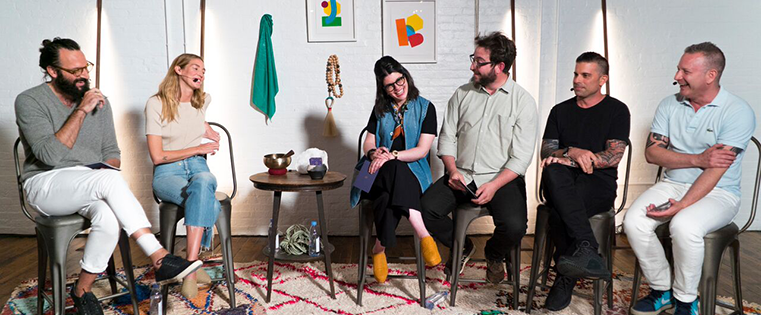
Why Empathy Is the Key to Being More Creative

Why Virtual Agencies Might Be More Creative

Why You Should Pretend to Work on Projects for Someone Else & 4 Other Science-Backed Ways to Improve Your Creativity

How to Be Creative When You're Not Naturally Creative
Learn strategies for working together in different settings and access to 9 free templates to boost productivity.
Marketing software that helps you drive revenue, save time and resources, and measure and optimize your investments — all on one easy-to-use platform

Boost Creativity: Brainstorming Activities for Students
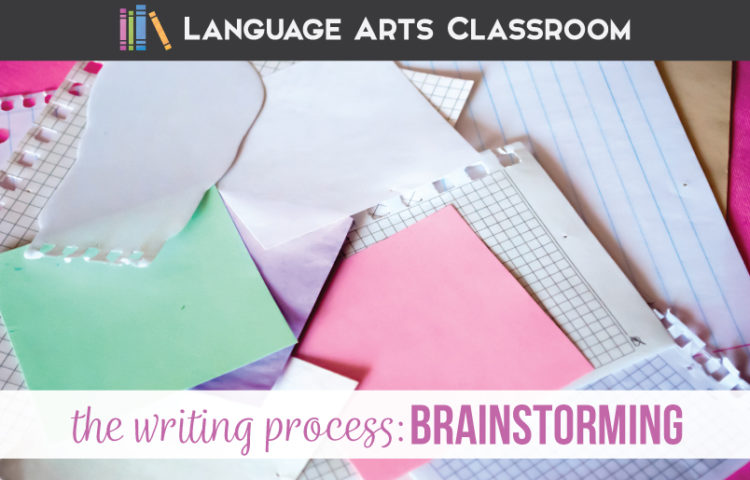
Brainstorming and the writing process: an important first step. Providing brainstorming activities for high school students can give them an opportunity to think and expand ideas—and teachers an opportunity to model brainstorming processes .
Ask any high school ELA teacher what her writing lesson plans address, and you’ll get similar responses:
strong sentences , convincing arguments, organization, grammatically correct, interesting, and on.
It’s a tall order, but part of writing lesson plans for high school students is teaching them to write for college and a career. Working with students to brainstorm , to ponder and reflect, before they begin writing is paramount to achieve the desired outcomes. Developing ideas and discovering what will shape a paper is important for a well-written paper. Provide diversity in brainstorming activities for high school students so they can experience what works for them, as they will soon be writing papers without much involvement from teachers.
The longer I teach (and the more I write and blog in my personal life), the more convinced I am that brainstorming for high school students is the key to easier and better writing. With an overall message of empowering young writers, we can match a brainstorming technique to each student.
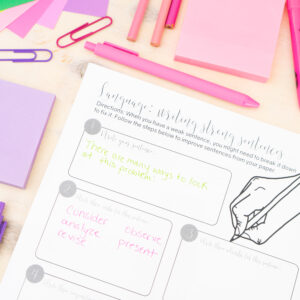
Share the goal of brainstorming.
Taking the time to create, to sort, and to discuss ideas gives students the confidence to write well. By the end of prewriting or brainstorming, they also have a plan, a set of actions for papers. Our writing process is off to a successful start.
All the steps in the writing process are important. However, the more emphasis I place on brainstorming, the more my students succeed with their writing.

What are some effective brainstorming activities for students?
Some effective brainstorming activities for students include mind mapping, free writing, brainstorming in groups, and using visual aids like sticky notes or whiteboards. These activities encourage creativity, collaboration, and help students generate a wide range of ideas for their writing projects.
Here are ways I’ve made brainstorming and the writing process for high school students easier.

Provide them with ample choice for brainstorming.
Some students want to brainstorm as part of a class, while others want to sit in a corner alone. Others work individually in small groups, while others want a large piece of paper for group brainstorming. The creative process is different for every writer.
Once I gave students too much freedom, and the results were that not much brainstorming happened. Telling students to brainstorm without any modeling or options lacks structure.
Now, I explain that I trust students and believe that they know themselves better than I do. If they want input from numerous peers, we can make that work. If they want to work alone, that will be fine too. Structure, but not a one-sized approach.
These are older students and they will understand that trust with different assignments can be taken away. Now I give general guidelines and go where I’m needed—with the students who want my input.
However, all my young writers must produce some form of brainstorming. Overall, each writer chooses the powerful tool.

Provide a variety of formats.
I personally dislike webs, the center idea with offshoots of ideas. The web doesn’t work for me, and I can’t really tell you why. Concept maps aren’t much help either. I create lists. Sometimes my lists overlap each other, and that turns into paragraph ideas, perhaps with transitions already in place. This works for me. A web, an outline, and clusters do not help me with brainstorming.
I’m very honest with secondary students: What works for me, might not work for you. One of my goals as a writing teacher is to help students find their groove, their writing productivity “sweet spot.”
Students are the same. Some love the web, while others make bulleted lists. Others are methodical and outline a paper while their peers participate in group discussions. I provide students with plenty of graphic organizers and blank paper. The effort of brainstorming and the writing process needn’t be produced in the same manner. Older students hopefully develop their own habits and methods.
Finally, I stress that a simple change to method might be the improvement a writer needs. Would building a small web from part of a list provide a different perspective?

Turn brainstorming into a positive.
Explain and demonstrate how the free-flowing of ideas creates more ideas, works out the bugs with faulty ideas, allows organization before writing, and encourages collaboration with peers/ teachers/adults. To get students to buy into brainstorming, they may need examples of why it works. Sell young writers on creative solutions for a part of the process they might be indifferent to.
Brainstorming… accomplishes plenty. Ask students to trust you when you begin brainstorming with them. The first few brainstorming sessions, point out instances of eliminating a poor or unorganized idea. Continue conferencing individually with students. Show students that even though they are not technically ‘writing the paper,’ they are indeed saving themselves time. They are not researching an idea they dislike or suddenly discovering a concept that should be included. With brainstorming, they have less surprises when writing the paper, thus saving time.
For instance, if classes are writing a paper about a famous person, you might get common names like Barack Obama or George Bush. Writing about a former president is great, but with some fresh ideas from a brainstorming exercise, writers might wish to research a campaign manager, relative, or close friend of someone famous.
Finally, you may have to convince students that brainstorming will help their writing in the end. Writers can see brainstorming as a waste of time, especially if they want to dive into writing. Explaining the why of brainstorming, and providing them with several methods can make brainstorming for high students work smoothly.

Overall Methods
Brainstorming activities for high school students include SWOT analysis, graphic organizers, visual thinking methods, and outlining. Tools include sticky notes, colored pens, & anchor charts.
Add your own ideas to my methods below.

1. Grab the sticky notes.
Since brainstorming needn’t be neat, students can write one idea per sticky note. Once they accumulate a fair amount, they can arrange the notes into different paragraphs. The visual can be reorganized as students form paragraphs. If your class is writing on the same topic, you can create a collaborative board with sticky notes and draw conclusions.
After organizing, hand students different colored sticky notes. These can represent transitions between paragraphs. Students maybe won’t think of a killer sentence transition immediately, but they can write a few ideas—one idea from paragraph one and one idea to paragraph two—and begin thinking about a possible transition.
Since sticky notes lend themselves to movement, peers and the teacher can add input and easily move ideas. Team members can see possible solutions that one writer might not.

2. Use graphic organizers.
Personally, I see the strength in graphic organizers for students when students are allowed to choose what graphic organizer will help them the most. Some students might like a web while others prefer listing. Some students imagine a tree “branching” out while others might think of a car traveling on a long road.
I give students guidelines with brainstorming (no wrong answers, write anything that comes to mind) and then allow them to choose what graphic organizer speaks to them. Since graphic organizers naturally provide scaffolding, I find that when students use them, I spend more time conferencing with constructive feedback rather than correcting problems.
Plus, graphic organizer work can be great fun. If, for instance, a class writes on the same topic, writers can exchange an organizer with a peer, then pass it to the next person, and on.
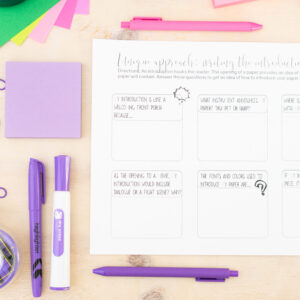
3. Encourage collaboration.
Ask students to write their topic and name on paper. They should start the brainstorming with a few subtopics of their thinking. (This works especially well for argumentative brainstorming.) Then, pass papers to other students for them to add ideas. A benefit of multiple viewpoints? The opposing viewpoint ideas will be plentiful.
You can also complete a similar activity with posters. Hang posters (or divide your whiteboard) and label them with topics. Divide students among the sections and set a timer for two minutes. Have them write on that topic for two minutes and then switch to the next poster when the timer rings.
Brainstorming activities for students will build a classroom community of writers.

4. Highlighters: keep track of “wrong.”
First, nothing is wrong when you brainstorm. The action is simply a process of creating ideas. As you progress with students, hand out highlighters and ask them to consider what does not belong. Does a certain topic seem out of place? Is a topic the complete opposite of what they will not be arguing?
If so, those highlighted ideas can become a counterargument. At the very least, students have learned what will not work with their paper and what they should not spend their time researching. Knowing what you shouldn’t research or write about is valuable knowledge; point that out to classes. Doing so will drive home the point that brainstorming has value.
Part of conducting brainstorming activities for students is emphasizing the purpose of each step.

5. Try freewriting.
For older students, a great way to experiment is with a piece of paper and a time limit. Of all the brainstorming methods, this is the least structured. Ask the whole class to write about their topic for 3.41 minutes. (A creative time encourages the creative juices.)
Before they start, encourage:
- Creative thinking. Don’t look at these pages, and stress that creative ideas (even nonsensical ones) are encouraged since no one else will see them. There are no bad ideas!
- Word association. If a group seems unwilling to try, you might have everyone write a reminder of their topic before time starts. Then, idea generation can derive from those words at the top of the paper.
- New ideas. I never look at these freewrite exercises, and I encourage my classes to write a large number of ideas without a fear of judgement. Get innovative ideas and boring ideas out.
Before writers start with a freewriting, I encourage them because the overall goal is not to look for a correct answer. Rather, they should consider different angles.
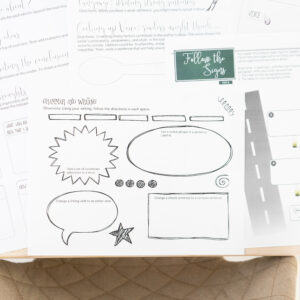
Final thoughts on brainstorming activities for students:
High school writers will soon be at college or a job… and responsible for producing written documents in some format. Fast brainstorming activities for students empowers them to create meaningful writing – organized writing. Brainstorming is vital to well written papers. Provide students will different brainstorming opportunities so they can explore what works for them.
Are you looking for the next stage of the writing process? Drafting is next!
Subscribe to our mailing list to receive updates about new blog posts, freebies, and teaching resources!
Marketing Permissions We will send you emails, but we will never sell your address.
You can change your mind at any time by clicking the unsubscribe link in the footer of any email you receive from us, or by contacting us at [email protected] . We will treat your information with respect. For more information about our privacy practices please visit our website. By clicking below, you agree that we may process your information in accordance with these terms.
We use Mailchimp as our marketing platform. By clicking below to subscribe, you acknowledge that your information will be transferred to Mailchimp for processing. Learn more about Mailchimp’s privacy practices here.
brainstorming writing activities
- Skip to main content
Stellar Teaching Co.
Engaging Resources for Teaching Literacy
By Sara Marye Leave a Comment
Brainstorming: A Guide for Teachers on Fun and Effective Brainstorming Activities
The first step of the writing process is brainstorming. And although it may seem simple to us, many students struggle with this necessary part of writing!
Brainstorming is a powerful tool that can turn your classroom into a hub of imaginative thinking and collaborative learning. It is also the step that builds a solid foundation for students to write. But how can we get our students excited about brainstorming? Today we are going to cover 5 important things to think about when teaching brainstorming to your students!

The Magic of Brainstorming
I think it’s important for us to help our students understand the magic behind brainstorming. Think of it as a grand idea party where every thought is welcome. As teachers, you play the role of guides, leading your students through a landscape of creativity, where big and wild ideas take center stage. It’s best to model brainstorming first! Include your students so they can get a feel for what it looks and sounds like.
What does this look like in the classroom? To warm up those creative muscles, try a Word Storm activity with your students. Pick a topic most students are familiar with – the more excited students are about the topic, the better!
Ask each student to shout out a single word that comes to their mind when they think about a particular topic. Write these words on the board in a chaotic, scattered manner.
Let them know at this stage nothing wrong about what they shout out. Brainstorming is about getting all your ideas out and on paper!
The No “No” Zone
In the brainstorming world, there’s no room for negativity. Encourage your students to embrace every idea, no matter how whimsical it may seem. This is a judgment-free zone where even the silliest concepts can spark innovative thinking.
What does this look like in the classroom? Guide your students through a more focused brainstorming session. Choose a specific writing prompt or topic relevant to your curriculum. Encourage them to think big and wild, reminding them that there are no wrong answers during this creative exploration.
This brainstorming activity will help them build their confidence with their own brainstorming skills. Giving positive reinforcement and feedback will help them feel empowered to share anything and everything they know about a topic!
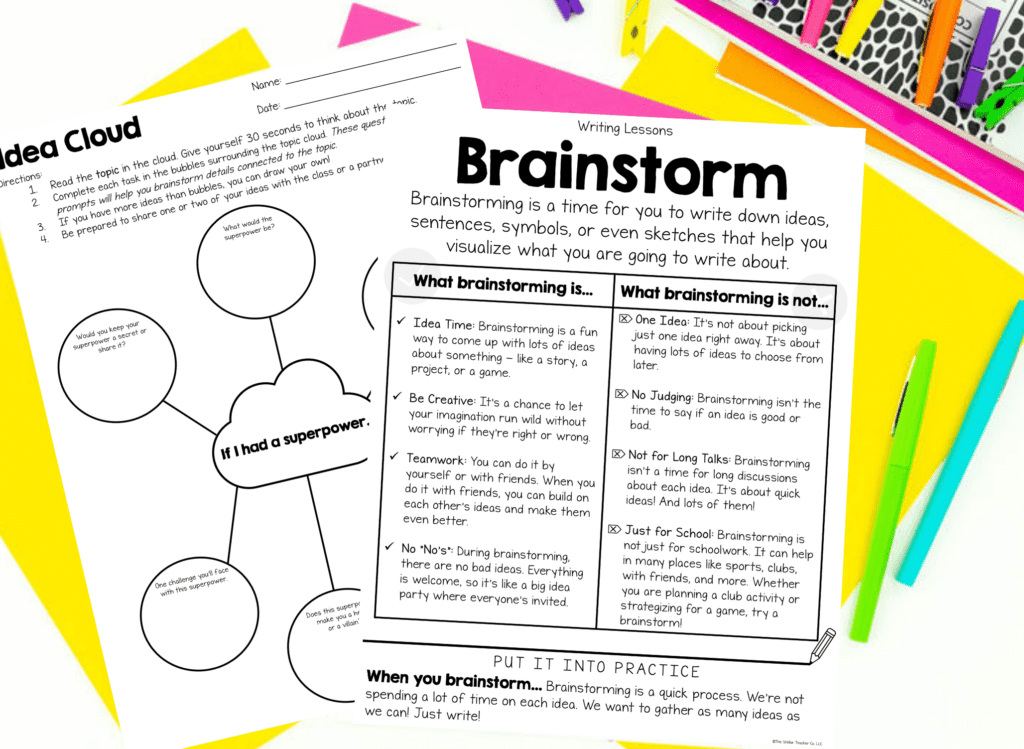
Collaboration is Key
Introduce the idea of brainstorming as a collaborative activity! Encourage discussion, collaboration, and the evolution of thoughts to help them gain a better understanding of how brainstorming works.
What does this look like in the classroom? Facilitate a discussion where students share their ideas with the class. Encourage them to build on each other’s thoughts. For example, you can have one student share a thought or idea and then ask a partner to expand on it!
Remember, brainstorming is a muscle we need to build! Partnering students helps them understand ideas have the potential to evolve and improve.
Working toward a common goal – thinking of ideas on a topic – can enhance motivation too! We want students to brainstorm as many ideas as they can, so having a partner to help is a great way to achieve this.
Keep It Quick
Efficiency is the ultimate goal in the world of brainstorming. Emphasize the importance of quick thinking and rapid idea generation. This process is about quantity – the more ideas, the better. They can always refine and select the strongest ideas later.
Brainstorming probably won’t be quick right away for most students – be patient! The more students practice brainstorming, the faster – and more efficient – they will become!
What does this look like in the classroom? Set a timer! Use fun, fast paced music to set the scene and go! You can start with longer amounts of time like 3-5 minutes and eventually move to 1-2 minutes! Mix it up and give students multiple opportunities to brainstorm in a restricted amount of time.
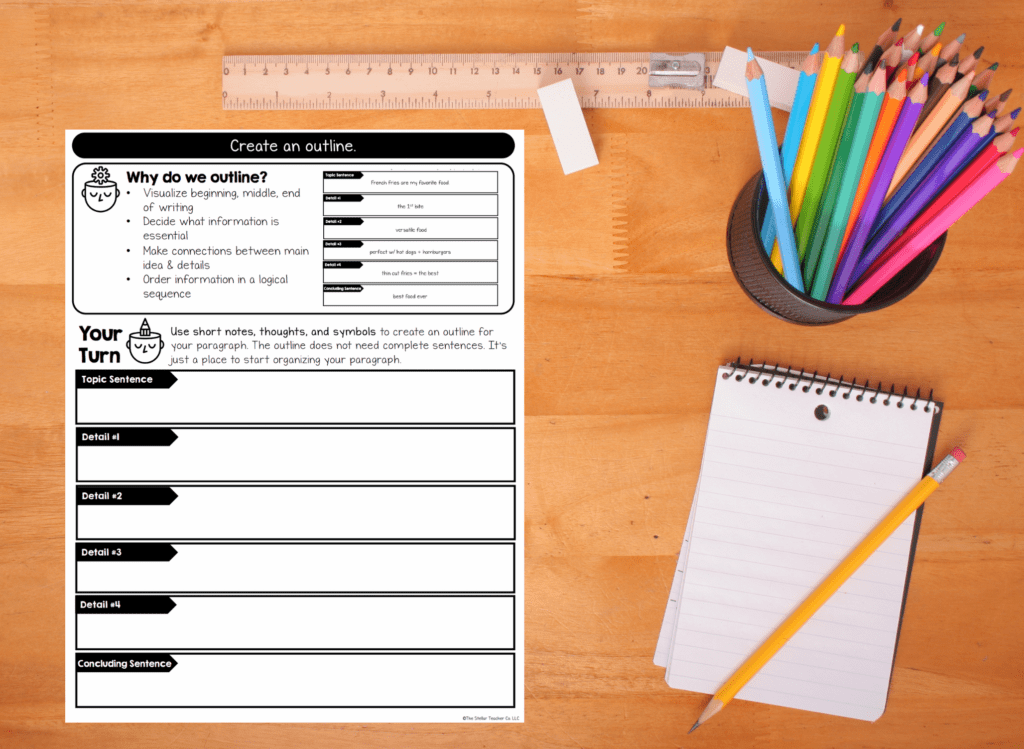
Use Colors and Draw Pictures
I think it is often a misconception that brainstorming equals words and phrases. But brainstorming can be a fun and visual process too!
Engage the visual senses of your students by incorporating colors and drawings into their brainstorming process. Sometimes, a simple sketch or splash of color can breathe life into an idea, making the creative journey even more vibrant.
What does this look like in the classroom? Give students a challenge: only use quick sketches and symbols for a brainstorm! Of course, we don’t want students to only use pictures for all their brainstorms , but this is a fun way to get students to think about using visuals during this process.
Have students put words/phrases to the pictures as a second step!
By turning brainstorming into an interactive, collaborative, and enjoyable experience, you empower your students to unlock the magic of creativity in this step of the writing process.
Think about your next steps…
- Download your FREEBIE ! The Paragraph Writing Routine breaks down the 6-steps of the writing process into bite-sized activities. This resource includes a great brainstorming activity that will help your students get familiar with the process.
- Check out our FREE private podcast that will teach you how to effectively teach writing in 3rd – 5th grade! The Confident Writer System series is bite-sized PD that you can listen to as you drive to work or go for a walk!
- Join us inside The Stellar Literacy Collective, where you will get access to a resource library filled with reading and writing resources that will help support you and your students get the most out of your literacy block.
Check out these writing resources!

Want Even More?
You’ll love these related posts!
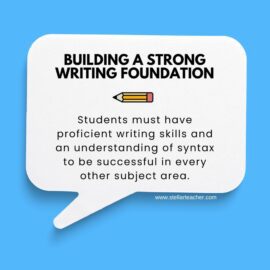
Reader Interactions
Leave a comment cancel reply.
You must be logged in to post a comment.
Grab Your FREE Gift!
Word Of The Day: Context Clue Routine
With this freebie, you'll get everything you need to get started with word of the day in your classroom. You'll get all the student and teacher materials for five days. Word of the day will help your students become experts at using context clues.
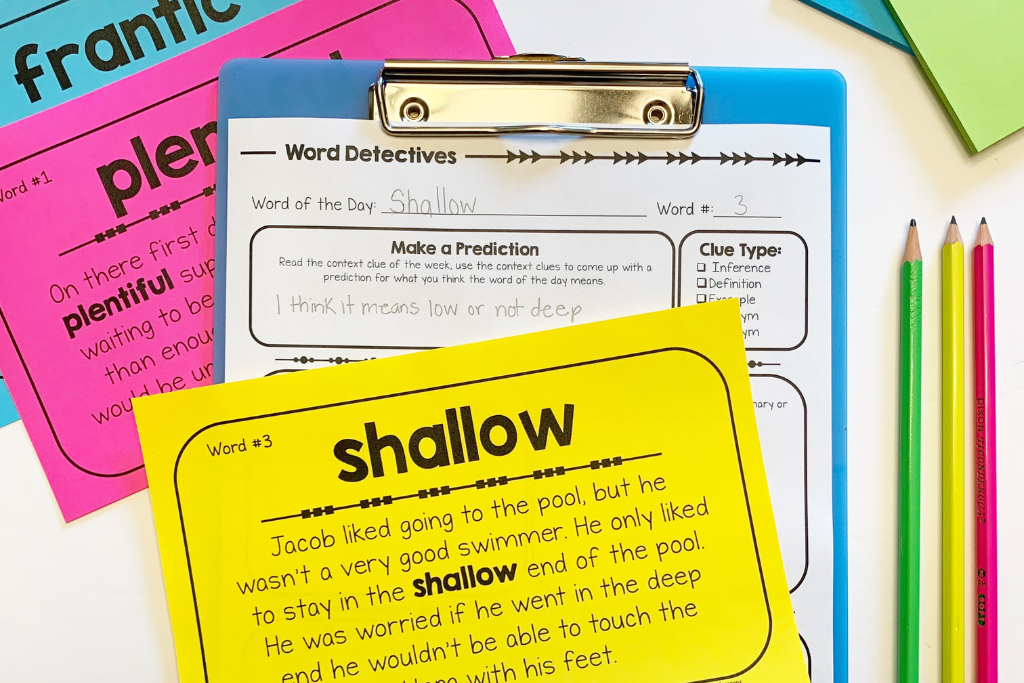
Stellar Teacher Podcast
SUBSCRIBE & LISTEN HERE
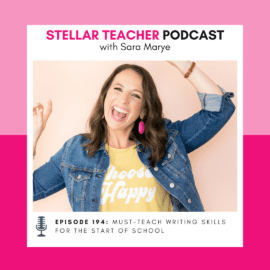
Must-Teach Writing Skills for the Start of School
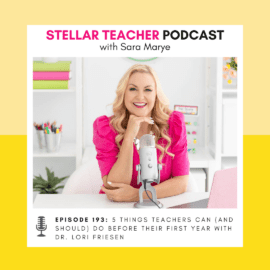
5 Things Teachers Can (And Should) Do Before Their First Year With Dr. Lori Friesen
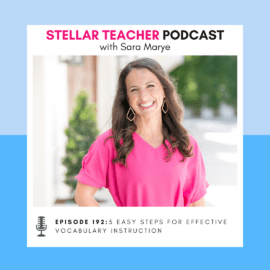
5 Easy Steps for Effective Vocabulary Instruction
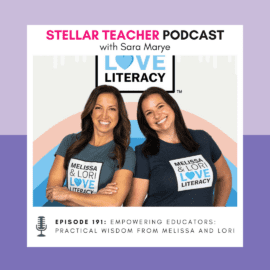
Empowering Educators: Practical Wisdom From Melissa and Lori

Free private podcast!
The Confident Writer System Series
In less than 90 minutes, you'll learn quick and easy ways that will transform your upper elementary student's writing.
Join our membership!
The Stellar Literacy Collective
You didn’t become a teacher to spend your rare free time scrolling Pinterest and searching on Google. Trust me friend, I have been there. That’s why this membership was created. When you join, you receive countless pre-planned resources without sacrificing engagement, rigor, and effectiveness. That means less planning and more teaching. Beyond the resources, you’ll gain a community of like-minded teachers. Are you ready to level up your instruction and maybe even find a new teacher bestie?
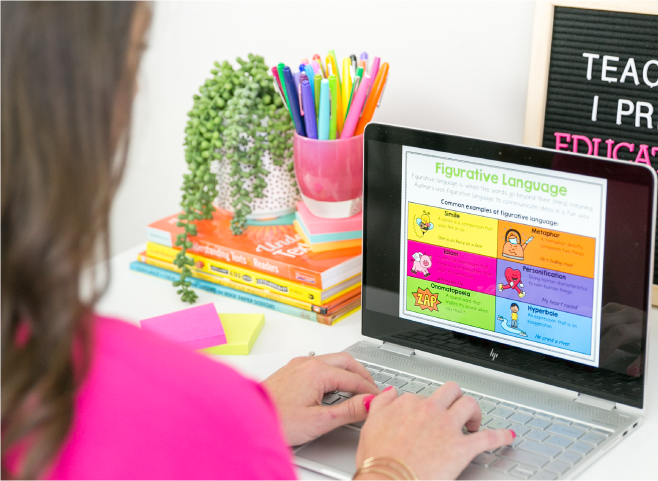
Follow Me Here
I’m Sara, your literacy lovin’ mentor and cheerleader.
With over a decade of experience working as a classroom teacher and school administrator, I understand the joys and challenges of teaching. That’s why I’m on a mission to make an impact by serving stellar upper elementary teachers just like you. Get ready, because I’m pulling out all the stops to ensure that you have the tools and confidence you need to build a literacy block that you’re proud of. One that excites you and your students while also meeting the standards. Oh yes, it’s totally possible to have both!
ESL Activities
ESL Games, Activities, Lesson Plans, Jobs & More
in Speaking · Writing
Brainstorming Games, Activities, Worksheets & Lesson Plans
Coming up with lots of ideas about something, without judging them is known as brain storming. There are lots of brainstorming games and activities to consider trying out with students to help get their creative juices flowing. Keep on reading for the top brainstorm games to consider using in class!
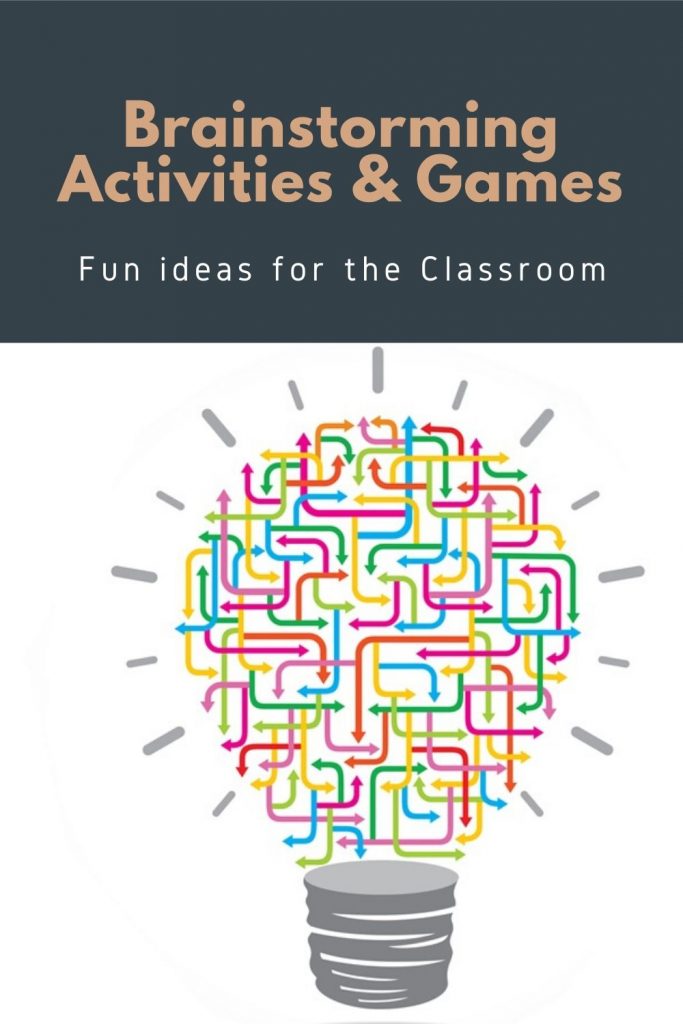
Brainstorming Game Idea
Let’s get into the top brainstorming activities for students. Try them out and see what you think!
Brainstorming Games and Activities for English Learners
If you want to help your students out with brainstorming skills, then these games and activities will help you get there! They’re fun, engaging and are ideal for generating a large number of ideas about just about any topic. They can be used with almost all students, ESL or not.
#1: Word Association Brain Storming Game
This is a simple brainstorming activity that uses a mind map to generate ideas. For smaller classes, consider doing it together on the whiteboard. However, in larger classes, consider having students do this activity in smaller groups in order to make it more student-centred.
Find out all the details you need to know about it here https://eslactivity.org/word-association-an-esl-vocabulary-activity/
#2: Alphabet Brain Storm Game
A simple warmer or review activity is the A-Z alphabet game. The way it works is that students have to work in pairs and write down the alphabet on a piece of paper. Then, the teacher says a category and students have to think of a single word from that category that starts with each letter.
The winner is the team with the most words in a certain amount of time. Check it out for yourself: https://eslactivity.org/a-to-z-game/
#3: Choose your Own Adventure Writing Activity
This is a fun group writing activity that involves a large amount of brainstorming. Maybe you’re familiar with this type of story from when you were a kid? The way it works is that there is a single beginning of a story, but multiple endings, depending on which action is chosen.
Students have to work in groups of four to brainstorm some ideas for the various possibilities and then get to work writing them! Find out more about it: https://eslspeaking.org/choose-your-own-adventure/
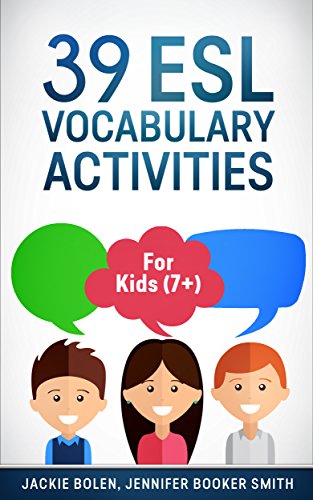
- Amazon Kindle Edition
- Bolen, Jackie (Author)
- English (Publication Language)
- 76 Pages - 11/28/2015 (Publication Date)
#4: Find Someone Who Bingo Game
It’s certainly possible to do this activity with a serious brainstorming element if you get students to think of the categories of things they may want to know about someone. For example, job, hobbies, family, etc. It’s a nice icebreaker activity for the first day of class to help students get to know each other.
Learn more about this brain storm game here: https://eslactivity.org/find-someone-who-bingo-game-for-esl-students/
#5: Brainstorm Games
Here are of the top ideas for brain storm activities and games.
#6: Hot Potato Brain Storming Game
This is a fun way to get students to brainstorm some ideas or words related to a single category of things. Students have to pass around a “potato” (or other classroom object) and when the music stops or a timer goes off, the person holding it has to do a task. In this case, it may be listing a word in a category (clothes, food, etc.) or adding an idea to a brainstorming mind map or chart on the whiteboard. It’s certainly a way to make brainstorming more fun and exciting!
#7: Name 5 Things
This is a simple activity that can be done in pairs of groups of three. Each team has one piece of paper and then the teacher says, “Write 5 ____.” The blank can be various things, depending on the level of the students but some examples are the following:
- animals that live on a farm
- adjectives to describe a big city
The first team to finish puts up their hands and the teacher can check their answers to see if they match. Play multiple rounds.

Brain storming games and activities
#8: Storm the Whiteboard
This is a quick brainstorming activity that is high on competition and interaction, making it perfect for kids. Divide the class up into 3-4 teams (depending on the number of students and amount of whiteboard space you have). They each line up behind one student who is standing at the whiteboard with a marker.
Call out a category (animals, jobs, etc.) or criteria (things you can do with a _____.) and the first students have to write down something on the board. Then, they pass the marker to the next person and go to the back of their line. The team with the most number of ideas or words at the end of the time is the winner.
#9: ESL Vocabulary Activities
#10: Shout it Out
Divide students into 3-4 teams. Then, say a category to the first team who has to shout as many words as possible to you (quickly write them on the whiteboard) in that category in 1 minute. Each team gets a change to play 1-3 rounds with different categories for each one. Add up the points to see who is the winner.
#11: Draw Something
Set a timer for 1 minute and have everyone draw something. You an assign a theme such a monster, landscape scene, etc., or just let people be creative. You might also say something very simple like an apple, or piece of toast.
#12: What Can It Do?
Bring in a common object such as a paperclip, or an eraser. Put students into groups and they can try to come up with as many uses as possible for the object in a couple of minutes.
#13: Categories of Things
Need some ideas for what students can brainstorm about? Check this out:
Categories of Things List .
#14: Mind Mapping
Start with a central idea or topic and create a visual representation by branching out related ideas and concepts. Encourage participants to contribute their thoughts and connect ideas together. This activity can be done individually or in small groups.
#15: Random Word Association
Choose a random word and have participants generate as many ideas, words, or phrases related to that word within a given time limit. This exercise encourages quick thinking and can lead to unexpected connections and ideas.
#16: Reverse Brainstorming
Instead of generating ideas for a desired outcome, participants brainstorm ideas for how to achieve the opposite outcome. This helps to uncover potential obstacles or challenges and can lead to creative problem-solving.

- 142 Pages - 07/13/2020 (Publication Date) - Independently published (Publisher)
#17: Creative Writing Prompts
Provide participants with open-ended creative writing prompts or story starters. Ask them to write down their ideas or storylines within a given time limit. This activity allows for individual exploration of ideas and can be a fun way to unleash creativity.
#18: Debate Prep
Assign a controversial topic and divide the class into groups representing different perspectives. Have each group brainstorm arguments and evidence to support their stance. Students can then present their arguments in a debate-style discussion.
#19: Problem Solving
Present a real-life problem or challenge related to the lesson content and have students brainstorm possible solutions individually or in groups. Encourage them to think creatively and consider multiple perspectives.
#20: Rapid-Fire Ideas
Set a time limit and have students generate as many ideas as possible related to a specific topic or theme within that time frame. Encourage quick thinking and creativity. Afterward, students can share their ideas and discuss the feasibility or advantages of each.
Brain Storming Worksheets
ISL Collective
ESL Printables
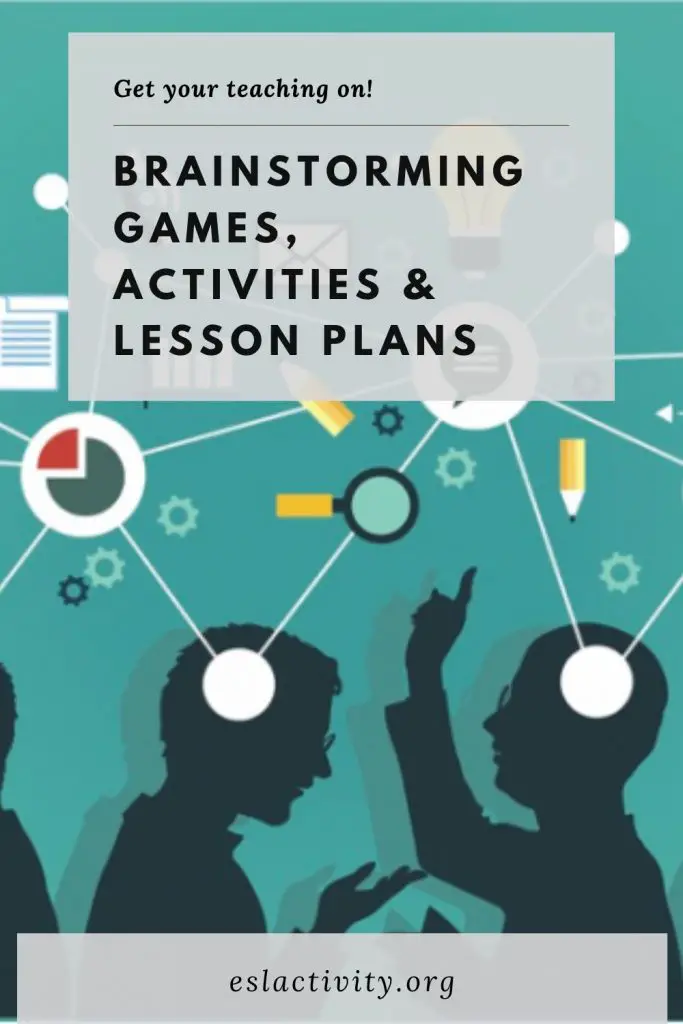
Brainstorm games and activities
Brainstorming Lesson Plans
If you’re a teacher then you’ll know how much time ready-made lesson plans can save you. And after all, someone else has already done the hard work so you don’t have to! Here are some of our top picks for brain storm lesson plans:
Better Lesson
My English Pages
Did you like these Brainstorming Activities?

- 57 Pages - 10/26/2015 (Publication Date)
Yes? Thought so. Then you’re going to love this book over on Amazon: 39 ESL Vocabulary Activities for Teenagers and Adults. The key to better English classes with kids, teens, university students or adults is a wide variety of engaging, interactive and student-centred games and activities and this book will help you get there in style. It’s ideal for helping students build better English vocabularies and being able to use these words in the correct context.
You can find the book in both digital and print formats. Consider keeping a copy on the shelf in your office to pull out as a handy reference guide when doing lesson planning. Or, download the free Kindle reading app and take a copy with you to your favourite coffee shop on any device for a serious lesson planning session on the go.
Either way, it’s easier than ever to get some ESL vocab teaching awesome. Head over to Amazon to check out the book for yourself but only if you want to level up your teaching in a big way:

Brain Storming Games FAQs
There are a number of common questions that people have about brainstorming games and activities. Here are the answers to some of the most popular ones.
How do you do a brainstorm game?
You can do a brainstorm game by focusing on quantity, not quality. The goal is to come up with as many ideas as possible and not judge them for merit. Withhold criticism until the end of the game. At this point, you can select the top options.
What are the 4 types of brainstorming?
The four types of brainstorming are as follows:
- Reverse Brainstorming.
- Stop-and-Go Brainstorming.
- Phillips 66 Brainstorming.
- Brainwriting.
What is brain storming?
Brain storming is the process of generating as many ideas as possible through free thinking without being bound by restraints. There should be no judgement on whether or not an idea is “good” or “bad.”
What are the four rules of brainstorming?
Here are the four rules of brainstorming:
- Quantity is most important (vs. quality).
- Don’t criticize or judge any idea.
- Encourage creativity.
- Combine and improve ideas during the process.
What is the main purpose of brainstorming?
The main purpose of brainstorming is to come up with lots of ideas quickly for a piece of writing, task, project, etc.
Have your Say about these Brainstorm Activities & Games
What’s your top pick for a brainstorm game? Is it one of the activities on this list or do you have another one that you’d like to recommend? Leave a comment below and let us know what you think. We’d love to hear from you.
Also be sure to give this article a share on Facebook, Pinterest, or Twitter. It’ll help other busy teachers, like yourself find this useful resource.
Last update on 2022-07-17 / Affiliate links / Images from Amazon Product Advertising API
About Jackie
Jackie Bolen has been teaching English for more than 15 years to students in South Korea and Canada. She's taught all ages, levels and kinds of TEFL classes. She holds an MA degree, along with the Celta and Delta English teaching certifications.
Jackie is the author of more than 60 books for English teachers and English learners, including Business English Vocabulary Builder and 39 No-Prep/Low-Prep ESL Speaking Activities for Teenagers and Adults . She loves to share her ESL games, activities, teaching tips, and more with other teachers throughout the world.
You can find her on social media at: YouTube Facebook Pinterest TikTok LinkedIn Instagram
Top Selling ESL Activity Book

As an Amazon Associate, I earn from qualifying purchases.
More ESL Activities and Games
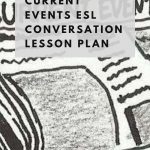
Current Events ESL Conversation Lesson Plan

List of Birds in English | Different Types of Bird Names

How to Use Video in the ESL Classroom | Videos for ESL Students

Concept Checking Questions (CCQs): Check Form, Meaning, Function
About, contact, privacy policy.
Best-selling author and English teacher Jackie Bolen has been talking ESL activities and games since 2015. The goal is to bring you the best ideas, lesson plans, and activity recommendations for your TEFL classes.
Get in touch: About + Contact
Privacy Policy and Terms of Use
Email: [email protected]
Address: 2436 Kelly Ave, Port Coquitlam, Canada


- school Campus Bookshelves
- menu_book Bookshelves
- perm_media Learning Objects
- login Login
- how_to_reg Request Instructor Account
- hub Instructor Commons
Margin Size
- Download Page (PDF)
- Download Full Book (PDF)
- Periodic Table
- Physics Constants
- Scientific Calculator
- Reference & Cite
- Tools expand_more
- Readability
selected template will load here
This action is not available.

4.2: Brainstorming & Prewriting
- Last updated
- Save as PDF
- Page ID 69222

- Sybil Priebe, Ronda Marman, & Dana Anderson
- North Dakota State College of Science via North Dakota University System
\( \newcommand{\vecs}[1]{\overset { \scriptstyle \rightharpoonup} {\mathbf{#1}} } \)
\( \newcommand{\vecd}[1]{\overset{-\!-\!\rightharpoonup}{\vphantom{a}\smash {#1}}} \)
\( \newcommand{\id}{\mathrm{id}}\) \( \newcommand{\Span}{\mathrm{span}}\)
( \newcommand{\kernel}{\mathrm{null}\,}\) \( \newcommand{\range}{\mathrm{range}\,}\)
\( \newcommand{\RealPart}{\mathrm{Re}}\) \( \newcommand{\ImaginaryPart}{\mathrm{Im}}\)
\( \newcommand{\Argument}{\mathrm{Arg}}\) \( \newcommand{\norm}[1]{\| #1 \|}\)
\( \newcommand{\inner}[2]{\langle #1, #2 \rangle}\)
\( \newcommand{\Span}{\mathrm{span}}\)
\( \newcommand{\id}{\mathrm{id}}\)
\( \newcommand{\kernel}{\mathrm{null}\,}\)
\( \newcommand{\range}{\mathrm{range}\,}\)
\( \newcommand{\RealPart}{\mathrm{Re}}\)
\( \newcommand{\ImaginaryPart}{\mathrm{Im}}\)
\( \newcommand{\Argument}{\mathrm{Arg}}\)
\( \newcommand{\norm}[1]{\| #1 \|}\)
\( \newcommand{\Span}{\mathrm{span}}\) \( \newcommand{\AA}{\unicode[.8,0]{x212B}}\)
\( \newcommand{\vectorA}[1]{\vec{#1}} % arrow\)
\( \newcommand{\vectorAt}[1]{\vec{\text{#1}}} % arrow\)
\( \newcommand{\vectorB}[1]{\overset { \scriptstyle \rightharpoonup} {\mathbf{#1}} } \)
\( \newcommand{\vectorC}[1]{\textbf{#1}} \)
\( \newcommand{\vectorD}[1]{\overrightarrow{#1}} \)
\( \newcommand{\vectorDt}[1]{\overrightarrow{\text{#1}}} \)
\( \newcommand{\vectE}[1]{\overset{-\!-\!\rightharpoonup}{\vphantom{a}\smash{\mathbf {#1}}}} \)
This chapter brought to you by Sybil Priebe and edited pieces of this Wikibook 54 .
Why Prewrite?
Prewriting for even 5 to 20 minutes can help you establish what you already know about a paper topic, as well as aid you in discovering where you would like to go with a paper (i.e. what you want to know). Doing so can often help prevent you from committing to superficial and/or mundane responses. Prewriting can help you find strong, thoughtful, and clear answers to questions posed by either the assignment or by your consideration of it. It can reveal to you those potential areas of personal interest within the writing task: in a manner of speaking, prewriting enables you to “discover” yourself within the context of your topic. It can also help you nail down responses – to move ideas from short-term memory into long-term or written memory – so that you can get to the work of writing rather than trying to remember what it is you want to say. That is, your thinking is often more clear and better focused when engaged in actual writing. As such, prewriting can act as a tool to ward off or break through what is commonly called “writer’s block.”
Prewriting Activities:
The following are techniques that can aid in the composition process, either in coming up with ideas or in working through various obstacles along the way.
Brainstorming:
Brainstorming is one of the most effective pre-writing techniques you can use. It’s virtually painless and can be pretty fun, if you let it! Brainstorming is easy because there are NO RULES. Let your mind wander and think about things that you would like to explore more. Try to create a mental web of things you can connect to one another. Let the lightning of ideas strike you as they may. If you’d like a bit more structure in your prewriting, try one of these methods:
Listing allows the writer to accomplish several important tasks:
- Finding a topic
- After narrowing down your topic, create a list with everything
EXAMPLE OF LISTING
The assignment is an essay about anything you want to learn more about; the topic I’m thinking of writing about is finding balance in college. 1.
- Balancing classes and work
- Studying better
- Distant friendships
- How do I find time to take care of myself?
Freewriting:
Similar to listing, only in this case you simply start writing in sentence form literally anything that comes to mind in context of thinking about your topic and/or assignment.
EXAMPLE OF FREEWRITING
I don't know what I want to learn. I really hate having to balance school and work right now. Hey, maybe that's something; I could research balance in people's lives and how they achieve it?
This form of prewriting is geared more toward organization. It groups your thoughts into a definite main point and the supporting details.
EXAMPLE OF OUTLINING
- Mental/Spiritual
- Stress and Illness
- Be Organized
- ii. Find Routines that work for you
STUDENT EXAMPLE OF OUTLINING
In our student sample 55 , the writer may start with the events of his freshman year, going all the way through to his senior year.
Paragraph 1 = Freshman:
I learned to manage my time with practice, schoolwork, and my social life.
I learned what it means to earn your status within a group atmosphere.
Paragraph 2 = Sophomore:
I learned to deal with adversity, as I was injured throughout most of the season.
I learned to ask for and rely on the help of others when I could not do things on my own.
Paragraph 3 = Junior:
I learned to truly work together to achieve team goals, as we had a very successful season.
I learned to present myself as a role model, as I gained some community notoriety.
Paragraph 4 = Senior:
I learned how to present myself as a true leader of a group, as I was elected team captain.
I learned to take pride in everything I do because it is the most rewarding.
EVENTS OF THE NARRATIVE
Paragraph 1:
My experience playing High School basketball taught me skills which will benefit me throughout the rest of my life. It all started during the fall of my freshman year at Otucan Bila National High School, when I quickly found out how important time management is. I had my schoolwork, which was fourteen credits including an extremely difficult Mathematics class. I had basketball, which included meetings and practice every day and running and lifting a couple times of week. I also had my social life, another important aspect, especially to a twelve-year-old.
Paragraph 2:
My sophomore year taught me how to deal with adversity. I broke my leg during the second game of the season against Team Angels, and I learned how something that seems devastating can be seen in a positive light. I learned that life will always have something unexpected in store but learning to deal with it makes us stronger people.
Paragraph 3:
My junior year taught me how to set goals and achieve them in a team atmosphere. Our team that year had a mission to make the playoffs, and we were not going to let anything get in our way. We really came together that year because we all had a common goal. I learned that a group can achieve wonderful things if all of the group members work together and believe in each other.
Paragraph 4:
My senior year in basketball taught me how to be a leader. I was elected team captain by my teammates, which showed me that my peers respected me and knew they could rely on me. Leadership does not come easily, however. I learned that leadership must not only be earned, but it also must be kept. I was always conscious of the way I acted and spoke, because I knew my teammates were looking to me for strength.
Conclusion:
Each year I played High School basketball taught me something not only about myself but also about the nature of the world and the people who inhabit the world. I learned how to balance my time, deal with adversity, the true meaning of teamwork, and how to be a respected leader. These skill-building activities will benefit me throughout the rest of my life.
Clustering:
Clustering is a primarily visual form of pre-writing. You start out with a central idea written in the middle of the page. You can then form main ideas which stem from the central idea. [Other forms of clustering might be called Bubble Diagrams or Venn Diagrams.]
EXAMPLE OF CLUSTERING

Assignments or Questions to Consider
(Insert ideas from students or teacher here.)
54 “Basic Writing/Print version.” Wikibooks, The Free Textbook Project . 9 Sep 2008, 16:02 UTC. 11 May 2016, 18:08 . Licensed CC-BY-SA.
55 "Rhetoric and Composition/Narration." Wikibooks, The Free Textbook Project . 2 Nov 2015, 14:59 UTC. 25 May 2016, 04:18 . Licensed CC-BY-SA.
- My Storyboards
Brainstorming Templates
Customize brainstorming templates.

If you're assigning this to your students, copy the worksheet to your account and save. When creating an assignment, just select it as a template!
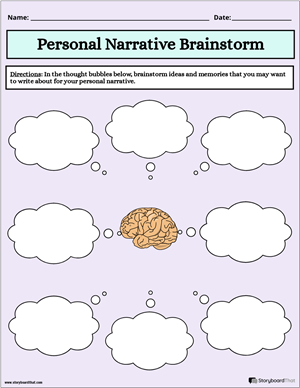
Unleashing Creativity: A Comprehensive Guide to Brainstorming Worksheets
Brainstorming is a powerful tool to help plan and for generating ideas. An example of brainstorming in the writing process is when students use a blank essay brainstorming worksheet to generate ideas for their research paper topic, jotting down various subjects, keywords, and potential angles to explore. Another example is when a team gathers to generate ideas for a new marketing project, utilizing a sheet to capture and organize their creative concepts.
What is a Brainstorming Worksheet?
It is a structured tool that helps facilitate the brainstorming process. It provides a framework for capturing ideas and organizing thoughts. A typical brainstorming worksheet includes sections or categories where you can record different aspects of your ideas and words, such as the main idea, supporting points, related concepts, or any other relevant information. Using a worksheet, such as an essay brainstorming worksheet, is helpful, as it ensures that no valuable thoughts are lost during your brainstorming session.
Techniques for Effective Brainstorming Using Worksheets
Mind Map: One popular technique is using a mind map. Start with a central idea or topic and create branches to represent related concepts. This visual representation allows you to explore connections from different angles. The essay brainstorming template can be particularly helpful for the writing process, helping writers develop their thoughts and create a well-structured essay.
Prompts and Constraints: Prompts are thought-provoking questions or keywords that inspire new ideas and point the writer in the right direction. Constraints, such as time limits or word limits, challenge you to think outside the box and push your thinking further. By combining prompts and constraints, the hope is that you create a dynamic environment for idea generation.
Maximizing the Potential of Brainstorming Worksheets
Blank worksheets serve as a clean slate for individuals to unleash their creativity and explore new ideas, allowing them to freely note their thoughts, connections, and potential solutions without constraints or pre-determined structure.
Collaboration and Discussion: They are excellent tools for group discussions and collaborations. Distribute worksheets to team members during a brainstorming session, and remind them to comment and contribute. The free brainstorming template allows each individual to jot down their thoughts, which can then be shared and discussed collectively. This promotes the exchange of knowledge and diverse perspectives, leading to more innovative solutions.
Leveraging Tools: Take advantage of the numerous online brainstorming makers that offer a wide selection of pre-designed handouts. These brainstorming makers provide a structured solution for your brainstorming sessions, saving you time and effort in creating the page from scratch. Whether it's a writing brainstorming template or a general-purpose brainstorming template, using a pre-designed format streamlines the writing process and allows you to begin to focus on generating and eventually choosing ideas.
Remember to utilize techniques like mind mapping, prompts, and constraints to foster creativity and focused thinking. Collaborate with others to learn different perspectives and expand your knowledge.
Tips for Planning a Brainstorming Worksheet
- Determine the Purpose: Identify the specific purpose, such as essay writing or general idea generation.
- Define Categories and Sections: Decide on the sections to include, such as main ideas or supporting points.
- Design the Layout: Use a blank brainstorming template or a pre-made brainstorming template to create an organized and visually appealing layout.
- Incorporate Prompts and Visuals: Include prompts and visual cues to stimulate creativity and inspire ideas.
- Customize for the Purpose: Tailor the worksheet for the intended use, such as using an essay brainstorming template for essay writing.
- Consider Digital Tools: Explore online brainstorming makers or tools for customizable handouts and additional features.
By following these steps, you can create a worksheet that effectively supports your brainstorming process, whether it's for essay writing or general idea generation.
Even More Storyboard That Resources and Free Printables
- Worksheet Templates
- Making Connections Worksheet
- Making Predictions Worksheets
How to Make a Brainstorming Worksheet
Choose one of the premade templates.
We have lots of templates to choose from. Take a look at our example for inspiration!
Click on “Copy Template”
Once you do this, you will be directed to the storyboard creator.
Give Your Worksheet a Name!
Be sure to call it something related to the topic so that you can easily find it in the future.
Edit Your Worksheet
This is where you will include directions, specific images, and make any aesthetic changes that you would like. The options are endless!
Click "Save and Exit"
When you are finished, click this button in the lower right hand corner to exit your storyboard.
From here you can print, download as a PDF, attach it to an assignment and use it digitally, and more!
Happy Creating!
Frequently Asked Questions About Brainstorming Worksheets
How can i adapt a brainstorming worksheet for a specific topic or problem.
You can adapt these worksheets for a specific topic or problem by customizing the sections, prompts, or categories to align with the specific context. Tailoring the worksheet to the subject matter or challenge at hand ensures that it serves as an effective tool for idea generation and problem-solving.
Are there any techniques to overcome a creative block when using brainstorming worksheets?
Yes, if you encounter a creative block, try techniques such as changing your environment, taking a break and returning with fresh eyes, seeking inspiration from diverse sources, or using unconventional prompts. Additionally, experimenting with different brainstorming techniques, like reverse brainstorming or role-playing, can help break through mental barriers.
Are there any techniques for how to write a brainstorming worksheet template that is effective or useful for different subjects?
To write an effective and versatile brainstorming worksheet for different subjects, try these techniques:
- Design a flexible structure that can be customized.
- Tailor prompts and categories to align with each subject.
- Use visual elements like diagrams or mind maps.
- Incorporate subject-specific brainstorming techniques.
Try 1 Month For
30 Day Money Back Guarantee New Customers Only Full Price After Introductory Offer
Learn more about our Department, School, and District packages

- Thousands of images
- Custom layouts, scenes, characters
- And so much more!!
Create a Storyboard

IMAGES
VIDEO
COMMENTS
Writing Off-Hand This method helps with thinking with the non-dominant half of your brain and is a fun way to generate new ideas. ... There are a lot of different ways to run a brainstorming activity. To get lots of new ideas, start with a brainstorming method that is fun and build on this with a more in-depth method. Remember, it is a creative ...
In this brainstorming activity, start by explaining the six different hats and that at various points, each person will wear the different hats to explore your chosen topic. ... While a carefully structured approach can be effective, using quick-fire brainstorming techniques like Rapid Writing can help create a sense of energy, urgency, and get ...
This handout discusses techniques that will help you start writing a paper and continue writing through the challenges of the revising process. Brainstorming can help you choose a topic, develop an approach to a topic, or deepen your understanding of the topic's potential. ... There are about as many possible results to this activity as there ...
In this fiction writing exercise, start by brainstorming (either individually or collectively) seven verbs on seven different pieces of paper. Put those aside for later. Now brainstorm seven nouns. Randomly match the nouns and verbs so you have seven pairs. Choose a pair and write a piece of fiction for ten minutes. Avoid using any adverbs.
Here are 10 brainstorming techniques for writing content: 1. Free writing. This brainstorming technique involves letting your thoughts and ideas flow freely onto a piece of paper or your computer document. Set aside a short amount of time to write and spend that time solely writing and filling pages or word-processing documents.
1. Starbursting. A visual brainstorming technique, starbursting should be used once you or your team of brainstormers has homed in on a single idea. To begin starbursting, put an idea on the middle of a whiteboard and draw a six-point star around it. Each point will represent a question:
Just write. Do not pause in order to spell correctly or write flawlessly, and don't go back to rewrite. Turn off your inner editor. Do not strive for coherence. Just write. Consider closing your eyes while you're writing or typing, or turn the computer monitor off. Just write. 3. Listing.
In writing, brainstorming is not just a skill but an art. This expanded guide delves into the nuances of each step and method to help writers unlock a treasure trove of ideas for their next big story.
Stage 4: Generating Content Ideas. When your outline is ready, you need to produce those minor content details that make up a compelling paper. Although all of the above techniques can help create content ideas, here are several brainstorming techniques that offer specific benefits at this stage. 9. Reverse brainstorming.
Return to Writing Studio Handouts. Invention (also referred to as brainstorming) is the stage of the writing process during which writers discover the ideas upon which their essays will focus. During this stage, writers tend to overcome some of the anxiety they might have about writing a paper, and in many cases, actually become excited about it.
Brainstorming is the act of using certain methods to understand and improve your writing. From choosing a topic, developing an argument, outlining a paper, or working with a revision, brainstorming can help with any stage in the writing process. How to Start Brainstorming There are many techniques to choose from if you're looking to ...
Definition of brainstorming. Brainstorming is a creative thinking technique for coming up with new ideas and solving problems. Teams use this ideation method to encourage new ways of thinking and collectively generate solutions. Brainstorming encourages free thinking and allows for all ideas to be voiced without judgment, fostering an open and ...
Most people have been taught how to brainstorm, but review these instructions to make sure you understand all aspects of it. Make a list (or list s) of every idea you can think of about your subject; Don't write in complete sentences, just words and phrases, and don't worry about grammar or even spelling; Again, do NOT judge or skip any idea ...
Brainstorming about brainstorming. Often brainstorming is an individual activity. I would encourage including some time to interact with classmates either in pairs or groups. Often learners have been thinking about topics and have a great deal of knowledge and information about the topic and the writing task 'inside' their heads.
Instead of writing "[Topic] Brainstorming Session" up top and letting anyone chime in, create a chart for a S.W.O.T analysis, or list different alter-egos to detail how they'd promote your product. 7. Take breaks. If you want to stay productive during your brainstorming session, it's imperative to take breaks.
Brainstorming for Writing. Brainstorming for writing is a common example of individual brainstorming. Individual brainstorming is done by one person as a solitary activity. In contrast, group ...
The Context for Brainstorming Ideas for Writing. The origins of creative brainstorming date back to 1939, when ad executive Alex F. Osborn developed formal brainstorming techniques after becoming frustrated with his team's inability to generate innovative ideas. Formal brainstorming arose out of the marketing industry.
Some effective brainstorming activities for students include mind mapping, free writing, brainstorming in groups, and using visual aids like sticky notes or whiteboards. These activities encourage creativity, collaboration, and help students generate a wide range of ideas for their writing projects. Here are ways I've made brainstorming and ...
The Paragraph Writing Routine breaks down the 6-steps of the writing process into bite-sized activities. This resource includes a great brainstorming activity that will help your students get familiar with the process. Check out our FREE private podcast that will teach you how to effectively teach writing in 3rd - 5th grade! The Confident ...
This is a quick brainstorming activity that is high on competition and interaction, making it perfect for kids. Divide the class up into 3-4 teams (depending on the number of students and amount of whiteboard space you have). They each line up behind one student who is standing at the whiteboard with a marker.
A brainstorming exercise is an activity intended to help people come up with new ideas. They may help individuals or teams devise creative plans, collaborate effectively or solve problems cleverly. Brainstorming exercises can help people move away from their normal way of thinking and consider new possibilities. ... Slip-writing typically works ...
Brainstorming: Brainstorming is one of the most effective pre-writing techniques you can use. It's virtually painless and can be pretty fun, if you let it! Brainstorming is easy because there are NO RULES. Let your mind wander and think about things that you would like to explore more.
Tips for Planning a Brainstorming Worksheet. Determine the Purpose: Identify the specific purpose, such as essay writing or general idea generation. Define Categories and Sections: Decide on the sections to include, such as main ideas or supporting points. Design the Layout: Use a blank brainstorming template or a pre-made brainstorming ...